

Dali Travel Guide: Top 22 Things to Do in Dali, China
Welcome to Dali! A city where ancient history whispers among mist-shrouded mountains and the calm waters of Erhai Lake reflect the slow-paced lifestyle of its inhabitants. Nestled in China’s Yunnan Province, Dali is a haven for those seeking tranquility, cultural richness, and a deep connection with nature. This travel guide invites you on a journey through a city that has managed to retain its charm and traditions amidst the ever-changing tides of time.
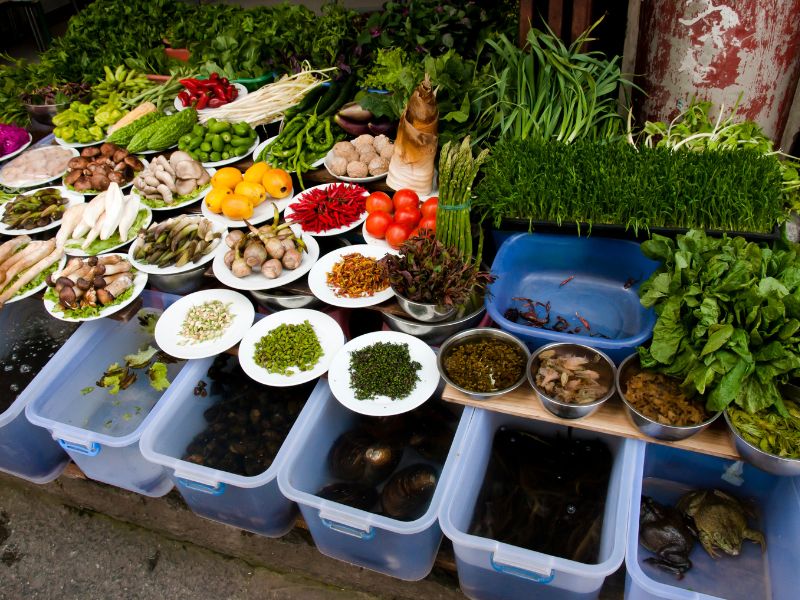
A City Steeped in History
Dali’s story is as captivating as the landscapes that surround it. Once the heart of the Nanzhao and Dali Kingdoms, this city is a living museum, with its ancient city gates, traditional Bai architecture, and the majestic Three Pagodas standing as silent witnesses to a bygone era. Exploring Dali’s cobbled streets and ancient structures is like stepping into a painting, where every corner tells a tale of dynasties, battles, and a rich cultural heritage that has survived the test of time.
Nature’s Masterpiece
Surrounded by the Cangshan Mountains and overlooking the vast Erhai Lake, Dali offers natural beauty that can soothe the weariest of souls. Whether you’re hiking the mountain trails, cycling around the lake, or simply enjoying a quiet moment in one of its many hidden gardens, Dali’s landscapes provide a perfect backdrop for adventure and introspection.
A Melting Pot of Cultures
Dali is home to the Bai people, known for their vibrant traditions, exquisite handicrafts, and warm hospitality. The city’s markets and festivals are a riot of colors, flavors, and sounds, offering a glimpse into the lives of its indigenous communities. From the daily morning markets to the grand celebrations of the Bai’s March Street Festival, Dali’s cultural tapestry is as intricate as it is fascinating.
Culinary Delights
The cuisine in Dali is as diverse as its culture. Local dishes are a blend of fresh ingredients from the mountains and lake, offering flavors that are both bold and comforting. Don’t miss out on trying the local cheese, “rushan,” or the savory “xiangyun” ham, and let your taste buds embark on a journey of their own.
The Artistic Soul
Art and creativity flow through Dali’s veins, with numerous galleries, craft workshops, and music venues scattered across the city. The vibrant art scene is a testament to the city’s enduring spirit of expression and innovation. In Dali, art is not just observed; it’s lived and breathed, inviting visitors to not only see but also partake in its creation.
So pack your bags and get ready to discover the wonders of Dali.
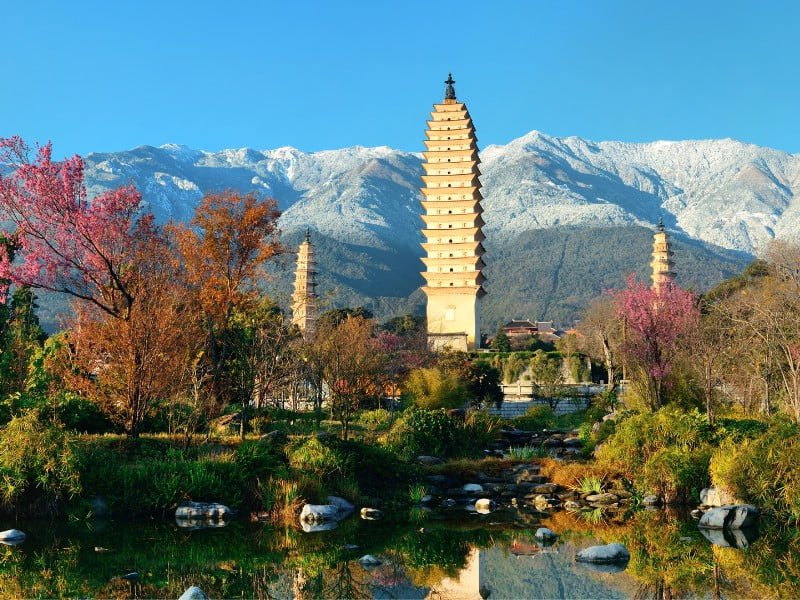
Dali City Guide: A Brief History Of Dali, China
Dali, with its laid-back vibe and stunning vistas, carries stories that stretch back into the mists of ancient history. It’s a place where every alleyway and breeze from Erhai Lake seems to whisper tales from the past. Dive into Dali’s history, and you’re in for tales of kingdoms, conquests, and a cultural tapestry that’s as vibrant as the local tie-dye.
Way Back When
Long before Dali became the poster child for serene getaways, it was home to the Bai people, who’ve been around for more than a millennium. Picture this: ancient tribes settling by the bountiful Erhai Lake, carving out a living and setting the stage for a rich cultural legacy. Fast forward a bit, and you’ve got the Nanzhao and Dali Kingdoms turning the place into a buzzing hub that attracted traders, artists, and monks like bees to honey.
Dynasty Drama
Imagine Dali as the backdrop for a historical epic, its streets bustling with traders from distant lands and scholars debating in the courtyards of majestic temples. The city was a beacon of culture and Buddhism during the Nanzhao and later Dali Kingdoms, kind of like the ancient world’s trendsetter. But as with all epic tales, the plot twists with the arrival of the Mongols, who added their own chapters to Dali’s story, blending cultures in ways that changed the city’s course.
The Mongol Makeover
When the Mongols rolled in during the 13th century, Dali’s days of independence were put on pause, but that didn’t dampen the city’s spirit. Dali adapted, absorbed new influences, and kept its cultural flame burning bright. It’s this blend of the old and new, the indigenous and the foreign, that gives Dali its unique character today.
A Modern-Day Muse
Fast forward to modern times, and Dali has become a haven for the creative soul, attracting a new wave of artists, writers, and dreamers drawn to its beauty and tranquility. The city’s history and natural landscapes provide endless inspiration, making it a place where past and present coexist in harmony.

Dali Top Attractions and Best Places to Visit in China
A long-time backpacker haunt for its authentic Chinese atmosphere and the mountains which surround it, Dali is equally as popular among domestic tourists today . In short, it is a popular place on the travel trail in China , but for good reason.
With much to see and do, you could easily spend a week here, so be sure to get this region plenty of time.
Start your time in this popular destination in Yunnan by exploring the Ancient City of Dali . Located thirteen kilometres away from the centre of the modern city of Dali, this well-preserved collection of buildings date from the Ming Dynasty.
Once an important trading and military post situated on a gateway to the Silk Road , it still contains temples, intact city walls, and folk-style homes which were once part of a vibrant community which held a great deal of importance in the region.
Fascinating Attractions
After you have gotten your fill of Dali’s Ancient City, make sure that Chongsheng Temple is next on your to-see list. Better known as the Three Pagodas after its primary attraction, these spires have been around for over 1,800 years and marked the time when Buddhism first arrived in the region.
Standing over 220 feet tall, these multi-tiered pagodas have a commanding presence on the skyline in the surrounding area, but that isn’t all there is to the temple complex; the main building itself is a serene place, and with an attractive bell tower and lush gardens, this place is well worth a visit.
Dali isn’t the only place in this part of Yunnan Province which has ancient buildings that have stood the test of time. After experiencing everything the city has to offer, plan a day trip out to the Ancient Town of Shaxi .
Once an important waypoint on what was known as the Yunnan-Tibet Tea Horse Road, Shaxi is an island of authenticity in a sea of sanitized reproductions of China’s past. Things may not be 100% squeaky clean here, but it is what it is – a place where real human beings still live, even after thousands of years of history.
More Attractions
Here, the same old temples, shops, markets, bridges, and other infrastructures serve the same purpose they have for many centuries – the more you walk around, the more you will realize this place is the real thing.
Whether you walk amidst its rice paddies or walk through the market when locals are buying everyday essentials from merchants who can trace their lineage back countless generations, you will find the off the beaten track experience you are desperately seeking in this time-tested town.
Nature lovers will enjoy their time in the Dali area, as it is situated close by to some of China’s most beautiful alpine scenery. If you don’t have time to wander this region’s high country at your leisure, at least make time in your schedule to see the Cangshan Mountains .
A mountain range with a peak elevation of over 13,000 feet, the views over the valley from the tops of these peaks are awe-inspiring. Active travellers will love the hiking opportunities they will find here, while those who sweat at the thought of exercise will be happy to learn there is a cable car available to allow them to enjoy the view from high above the valley that is home to the city of Dali.

Other Cultural Attractions: Trip to Dali, China
Do you still have an appetite for ancient towns after visiting the ones mentioned above? Xizhou Town is another old settlement you should see while in the Dali area. A relatively short day trip from Dali, this place was a thriving centre of commerce all the way up to 1949, the year when the Communist Party of China emerged victorious over the KMT.
While its buildings have deteriorated somewhat since that time, many feel that it lends an air of authenticity to this ancient town that the Dali Ancient City lacks. When you aren’t walking through the narrow streets of this atmospheric place, check out the local market – mostly free of the trinket stalls which plague much of Dali’s market, you’ll find wandering here to be a far more pleasant experience.
Other Attractions
Xizhou is situated on the shores of Erhai Lake , a body of water considered to be one of the most picturesque in China . Start your time here by having a coffee with breakfast overlooking its misty surface. Once you have finished up, check out the sightseeing boat cruise, as it will allow you to get out onto the water and experience the peacefulness of this lake up close.
Back in Dali, the Dali Foreigner Street is where you’ll want to go if you are looking for the greatest range of souvenirs from your time in this corner of Yunnan. Yes, there is some dinky plastic crap – but there are also exquisite wood carvings, silverware, and other fine local crafts.
Look carefully, and you’ll find something unforgettable to bring home with you.
Top 22 Things To Do in Dali, China For Visitors
Here are the top 22 things to do in Dali:
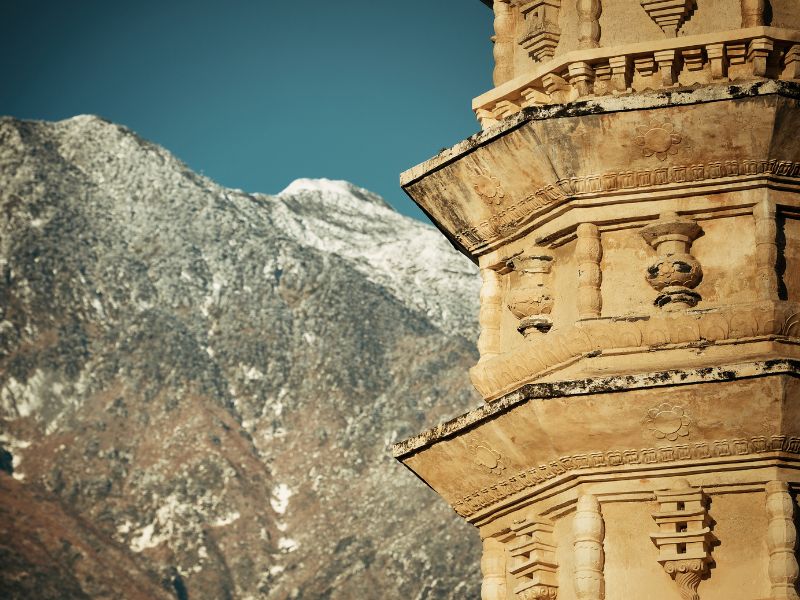
1. Explore the Ancient City of Dali
The Ancient City of Dali, also known as Dali Old Town, is a beautifully preserved area with traditional Bai architecture, cobbled streets, and vibrant markets. Walk through the ancient city gates and explore the bustling streets filled with artisan shops, cafes, and tea houses. Don’t miss the opportunity to try local snacks from street vendors. The area comes alive at night with lanterns illuminating the streets, offering a charming atmosphere.
2. Visit the Three Pagodas
The Three Pagodas, located northwest of Dali Old Town, are an iconic symbol of the city’s history and religious significance. These structures have withstood earthquakes and wars, dating back to the 9th and 10th centuries. The reflection of the pagodas on the nearby pond offers a spectacular photo opportunity. Visitors can also explore the Chongsheng Temple complex behind the pagodas, which provides panoramic views of Dali and its surroundings.
3. Cruise on Erhai Lake
Erhai Lake, meaning “Ear-shaped Sea,” is the second largest freshwater lake in Yunnan and offers stunning natural scenery. Take a boat cruise to explore the lake’s islands, each with its own unique charm and temples. Cycling around Erhai Lake is also a popular way to enjoy the breathtaking landscapes and visit nearby fishing villages. Sunset by the lake is particularly mesmerizing and not to be missed.
4. Hike Cangshan Mountain
Cangshan Mountain, with its towering peaks and verdant forests, offers numerous hiking trails for all levels. The chairlift to the Zhonghe Temple provides easy access to spectacular views and the starting point for several trails. The Jade Belt Road is a gentle path that runs along the mountain, offering stunning views of Erhai Lake. Keep an eye out for the marble stones and streams that Cangshan is famous for.
5. Wander Through Xizhou Town
Xizhou is a charming town near Dali, known for its well-preserved Bai architecture and vibrant daily market. Visit the historic Yan family compound to see traditional Bai homes and courtyards. Try the local specialty, Xizhou baba, a savory or sweet stuffed pancake. The town is also a great place to observe local life and interact with the friendly Bai people.
6. Relax in Shuanglang Village
Shuanglang Village, situated on the northeastern shore of Erhai Lake, has become a haven for artists and is known for its laid-back atmosphere and stunning lake views. Wander through the narrow lanes lined with boutique hotels, galleries, and cafes. Enjoy a leisurely meal by the lake, offering fresh seafood and local dishes. The village is an ideal spot for those looking to escape the hustle and bustle and enjoy the slower pace of life.
7. Visit the Dali Museum
The Dali Museum, located in Dali Old Town, offers insights into the history, culture, and art of the Dali region. The museum houses artifacts from the ancient Nanzhao and Dali Kingdoms, traditional Bai clothing, and local crafts. It’s a great place to learn about the area’s rich heritage before exploring the city. The museum’s architecture itself is a blend of traditional Bai style and modern design.
8. Explore Butterfly Spring Park
Butterfly Spring Park is a tranquil spot at the foot of Cangshan Mountain, famous for the thousands of butterflies that gather here in spring. The clear spring and lush surroundings make it a picturesque place for a stroll. Legend has it that the spring is a symbol of eternal love, attracting couples and visitors. The park also features a museum dedicated to butterflies, showcasing various species and their importance to the local ecosystem.
9. Attend the Dali International Photography Exhibition
Held annually, the Dali International Photography Exhibition attracts photographers and artists from around the world. The event showcases a wide range of photographic works, from traditional landscapes to contemporary art. It’s a fantastic opportunity to see creative works and meet artists in the beautiful setting of Dali. The exhibition highlights the city’s growing reputation as a cultural hub.
10. Visit Zhoucheng Village
Zhoucheng Village is the largest Bai community in Dali, known for its traditional tie-dyeing techniques. Visitors can participate in tie-dye workshops to learn about the process and create their own fabric designs. The village is also home to several ancient temples and traditional Bai houses, offering a glimpse into the local way of life. It’s a great place to purchase authentic handcrafted souvenirs.
11. Explore Weishan Old Town
Though a bit further afield, Weishan Old Town is worth the visit for its well-preserved architecture and slower pace of life compared to Dali Old Town. This hidden gem is the birthplace of the Nanzhao Kingdom and is rich in history and culture. The town’s traditional market is a bustling place where visitors can sample local foods and observe daily life. Weishan’s serene atmosphere and historic significance make it a fascinating day trip.
12. Climb Weibao Mountain
Weibao Mountain, near Weishan, is considered sacred and offers several Taoist temples and pavilions along its hiking trails. The climb provides not only spiritual enrichment but also stunning views of the surrounding countryside. It’s a place of pilgrimage for Taoists and those interested in Taoism. The tranquility and natural beauty of Weibao Mountain make it a refreshing retreat.
13. Taste Dali’s Local Cuisine
Dali’s cuisine is a reflection of its cultural diversity, offering a variety of Bai, Tibetan, and Yunnanese dishes. Must-try dishes include “crossing-the-bridge” noodles, Dali-style claypot fish, and grilled cheese (rubing). Local markets and street food vendors are the best places to sample these delicacies. Don’t forget to pair your meal with some locally produced Dali beer.
14. Enjoy Tea at a Traditional Tea House
Dali is surrounded by tea plantations, and visiting a traditional tea house to sample local teas is a must-do activity. Experience a traditional tea ceremony and learn about the different types of tea produced in the region, including the famous Pu’er tea. Many tea houses are located in beautifully restored buildings, offering a peaceful setting to enjoy your tea. It’s a great way to relax and immerse yourself in local culture.
15. Participate in the Torch Festival
The Torch Festival is celebrated by the Bai and other ethnic minorities in Yunnan, marking one of the most important and colorful events in Dali. The festival includes traditional sports, folk dances, and, of course, the lighting of torches. It’s a unique experience that allows visitors to witness local traditions and join in the festivities. The festival takes place annually in late June or early July.
16. Take a Cooking Class
Joining a cooking class in Dali is an excellent way to learn about local ingredients and cooking techniques. Classes often include a market visit to select fresh ingredients, followed by hands-on instruction in preparing traditional dishes. It’s a fun and interactive way to delve into Yunnan’s culinary traditions. Plus, you’ll have the chance to enjoy the fruits of your labor at the end of the class.
17. Shop for Local Crafts
Dali is known for its vibrant arts and crafts scene, with local artisans producing everything from pottery and textiles to silver jewelry and traditional paintings. The best places to shop for these handmade items are in Dali Old Town and Xizhou Town. Purchasing these crafts not only provides you with a unique souvenir but also supports the local artisan community. Be sure to visit the workshops where you can see artists at work.
18. Visit Bai Traditional Houses in Xizhou
Xizhou is renowned for its well-preserved Bai traditional houses, which feature intricate wood carvings, colorful wall paintings, and beautiful courtyards. Visitors can tour some of these historic homes to learn about Bai architecture and culture. Many houses also host cultural performances and offer traditional Bai snacks. It’s an immersive way to experience the heritage of the Bai people.
19. Hike to Hidden Waterfalls
The mountains and valleys around Dali hide numerous waterfalls and streams, offering refreshing hikes away from the city. Guides can take you to some of the less-known waterfalls where you can enjoy a picnic and a swim in natural pools. These hikes often pass through small villages and terraced fields, providing insights into rural life in Yunnan. It’s an adventure that combines natural beauty with cultural discovery.
20. Explore Dali’s Night Market
Dali’s night market is a lively place where you can find a wide range of street food, crafts, and entertainment. It’s an ideal spot to try local snacks, shop for souvenirs, and enjoy the bustling atmosphere. The market is also a great place to observe local life and interact with residents. Be sure to try the local barbecue and sweet treats.
21. Attend the San Yue Jie Festival
The San Yue Jie Festival, held in the third lunar month, is one of the largest traditional markets and cultural festivals in Dali. It attracts people from various ethnic groups who come to trade goods, socialize, and celebrate. The festival features horse racing, traditional music and dance, and lots of local food. It’s a vibrant display of Yunnan’s diverse cultures and a fantastic opportunity for cultural immersion.
22. Relax at Cangshan’s Hot Springs
After a day of exploring, unwind at one of Cangshan Mountain’s natural hot springs. These thermal waters are believed to have healing properties and offer a serene setting surrounded by nature. There are several hot spring resorts where you can enjoy a variety of pools and spa treatments. It’s the perfect way to relax and rejuvenate in Dali’s beautiful mountain landscape.
These activities provide a comprehensive experience of Dali’s history, culture, natural beauty, and culinary delights, allowing you to immerse yourself in the unique charm of this enchanting destination.
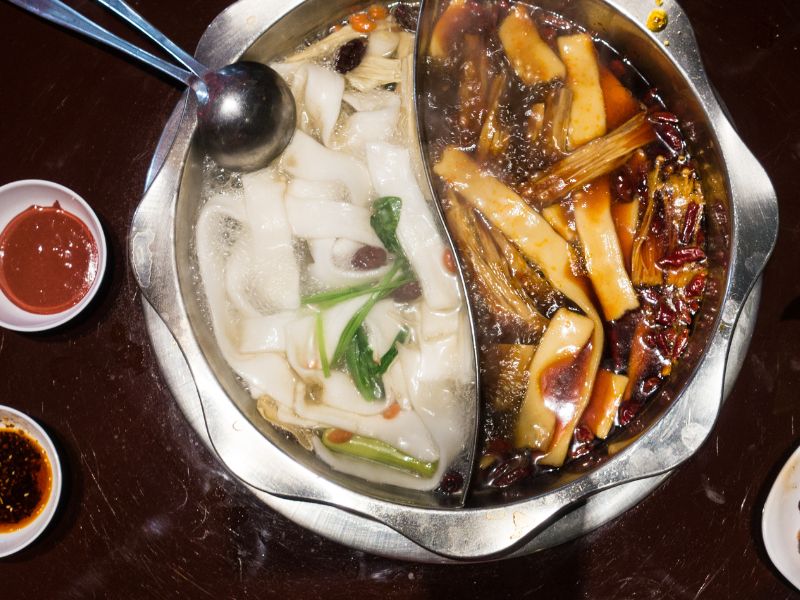
What To Eat and Drink in Dali, China
Here’s your ultimate travel guide to the must-try eats and drinks in Dali, promising an unforgettable journey for your taste buds.
Dali’s Signature Dishes
- Erhai Fish (洱海鱼) : Caught fresh from the crystal-clear waters of Erhai Lake, this dish is usually grilled or steamed, seasoned with local herbs and spices, offering a taste of Dali’s natural bounty.
- Rice Noodles with Pork (过桥米线) : A comforting bowl of rice noodles served with thinly sliced pork, vegetables, and a rich, aromatic broth. It’s a staple breakfast or lunch option that perfectly encapsulates Yunnan’s love for noodles.
- Crossing-the-Bridge Noodles (过桥米线) : This iconic Yunnan dish consists of a steaming hot pot of broth, served alongside raw ingredients like slices of meat, vegetables, and noodles, which are cooked tableside. It’s not just a meal; it’s an experience.
- Yunnan Cheese (乳扇) : Also known as “Rushan,” this unique dairy product is often grilled or fried and served with a sweet or savory dip. It’s a testament to the dairy traditions of the Bai people.
- Shanxi Mature Vinegar Peanuts (山西老陈醋花生) : A popular snack or appetizer, these peanuts are mixed with mature vinegar, giving them a tangy, addictive flavor that’s hard to resist.
Must-Try Beverages
- Dali Beer (大理啤酒) : Brewed locally, Dali Beer is a refreshing lager that captures the spirit of the city. It’s the perfect accompaniment to a spicy meal or a sunset by the lake.
- Sweet Osmanthus Tea (桂花茶) : This fragrant tea, made from the sweet osmanthus flowers, is a favorite among locals and visitors alike. It’s known for its sweet, floral aroma and a number of health benefits.
- Highland Barley Wine (青稞酒) : This Tibetan-inspired alcoholic beverage is made from highland barley and has a rich, robust flavor. It’s a must-try for those looking to sample the local spirits.
- Rose Petal Jam (玫瑰花酱) : Often spread on toast or used as a sweetener for tea, this jam made from local roses adds a floral touch to any meal.
- Wild Mushroom Hot Pot (野生菌火锅) : While not a drink, no culinary journey in Dali is complete without experiencing a hot pot filled with locally foraged mushrooms, a true delicacy of the region.

Tours For Visitors To Dali, China
Here’s a comprehensive list of tours you should consider to make the most out of your visit to Dali.
1. Historic Dali City Tour
Delve into Dali’s ancient past with a guided tour around the Dali Old Town. Discover the city’s well-preserved gates, walk along its ancient walls, and explore landmarks like the Three Pagodas. Learn about the rich history of the Bai people and the city’s significance along the Tea Horse Road.
2. Cangshan Mountain Hiking Experience
Embrace the great outdoors with a hike along the Cangshan Mountain range. Choose from trails that suit all levels of fitness, from leisurely walks to more challenging treks. Enjoy panoramic views of Erhai Lake and Dali below, and discover the mountain’s unique flora and fauna.
3. Erhai Lake Cycling Tour
Cycle around the picturesque Erhai Lake, stopping at fishing villages, local markets, and temples along the way. This leisurely tour offers a glimpse into the daily lives of the local communities and stunning lakeside scenery. It’s a great way to experience the natural beauty surrounding Dali at your own pace.
4. Tea Plantation and Tasting Tour
Yunnan is famous for its tea, and a visit to a local tea plantation reveals the secrets behind tea production. Learn about the ancient art of tea making, from picking to processing, and enjoy a tasting session of different varieties, including the renowned Pu’er tea.
5. Bai Culture and Artisans Workshop Tour
Immerse yourself in Bai culture with a tour that takes you to traditional Bai homes, workshops, and markets. Learn about Bai architecture, watch artisans at work creating tie-dye textiles and pottery, and perhaps try your hand at some traditional crafts.
6. Dali Street Food and Market Tour
Explore Dali’s culinary scene with a guided tour of its bustling markets and street food stalls. Sample local specialties such as fried cheese, rice noodle soup, and sweet rose cakes. This tour is a feast for the senses and offers insight into the local cuisine and ingredients.
7. Xizhou Ancient Town and Zhoucheng Village Tour
Discover the charm of Xizhou and Zhoucheng, two towns near Dali known for their well-preserved Bai architecture and vibrant local markets. In Zhoucheng, known as the ‘Town of Tie-Dye,’ you can witness the traditional process of making Bai tie-dye textiles.
8. Dali Nightlife Experience
Experience Dali after dark with a tour of the city’s best bars, breweries, and night markets. Enjoy local craft beers, taste street food delicacies, and soak up the lively atmosphere. It’s a great way to experience the city’s modern-day culture and socialize with locals and fellow travelers.
9. Meditation and Yoga Retreats
For those seeking tranquility, Dali offers several meditation and yoga retreats set in serene locations. Reconnect with nature and find inner peace through guided meditation sessions, yoga classes, and wellness workshops, all while surrounded by Dali’s stunning landscapes.
10. Bird-Watching and Nature Tour in the Wetlands
Venture into the wetlands surrounding Dali for a bird-watching tour. These biodiverse areas are home to a variety of bird species, offering a peaceful escape into nature. It’s an ideal tour for photographers and nature lovers.
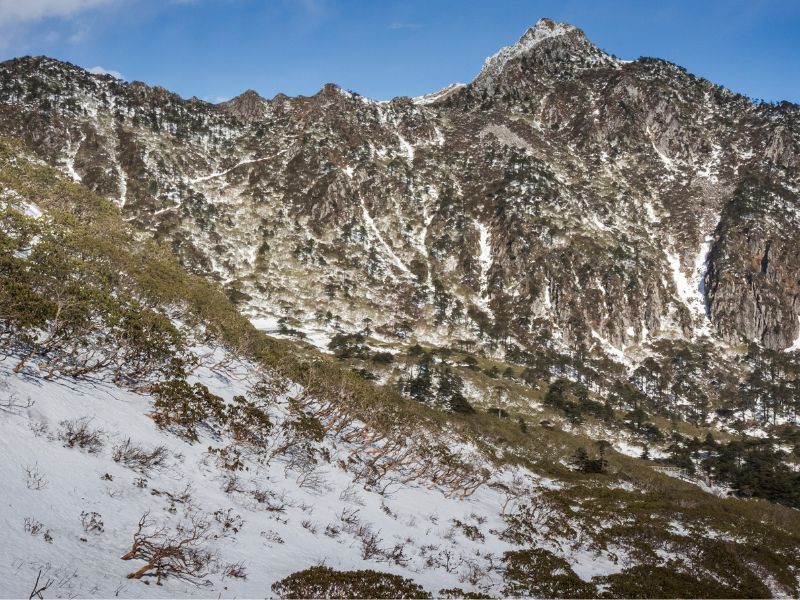
Day Trips From Dali, China
Here’s a curated list of day trips from Dali that promise to enrich your travel experience with unforgettable memories.
1. Xizhou Ancient Town
Just a short drive from Dali, Xizhou is renowned for its well-preserved Bai architecture and vibrant local culture. Stroll through the town’s bustling market, sample traditional Bai snacks, and admire the intricate designs of the historic houses. Xizhou offers a glimpse into the daily life and traditions of the Bai people, making it a must-visit for cultural enthusiasts.
2. Cangshan Mountain Hike
The Cangshan Mountain Range, with its majestic peaks and breathtaking scenery, offers numerous hiking trails suitable for all levels. Take the cable car up and hike among the clouds, exploring tranquil streams and waterfalls. The mountain’s flora and fauna add to the beauty of the hike, promising a day filled with natural wonders. Don’t forget to pack a picnic to enjoy amidst the stunning vistas.
Cycling around Erhai Lake provides a leisurely way to take in the serene beauty of one of China’s largest freshwater lakes. The route takes you through quaint fishing villages, lush farmlands, and offers panoramic views of the lake and mountains beyond. Bike rentals are readily available, and the flat paths make this an enjoyable activity for all ages. Stop at local eateries along the way to savor fresh fish and regional specialties.
4. Shaxi Ancient Town
A bit further afield, Shaxi was once a bustling stop on the Tea Horse Road and has retained much of its old-world charm. The town’s Sideng Square, surrounded by traditional wooden buildings and the ancient stage, is a highlight. Visitors can explore the local temples, enjoy hikes to nearby villages, and immerse themselves in the tranquil atmosphere of rural Yunnan. Shaxi is an ideal destination for those looking to step back in time.
5. Weishan Old Town
Discover the lesser-known Weishan Old Town, where history comes alive amidst Ming and Qing dynasty architecture. The town’s relaxed pace, historic buildings, and friendly locals offer a stark contrast to more touristy destinations. Weishan’s local market is a treasure trove of Yunnanese snacks and crafts. The town serves as a gateway to the Weibaoshan Daoist mountain, home to centuries-old temples nestled in lush forests.
6. Three Pagodas and Chongsheng Temple
While technically in Dali, the Three Pagodas and the adjacent Chongsheng Temple complex warrant a day trip of their own. These iconic structures are a testament to Dali’s Buddhist heritage and offer stunning photo opportunities. The site’s history, combined with the panoramic views of Dali and Erhai Lake from the temple grounds, is truly mesmerizing. Visitors can explore the temple’s extensive grounds, including several newly restored pavilions and halls.
7. Bai Traditional Villages Tour
Spend a day visiting the Bai traditional villages that dot the landscape around Dali. Each village, with its unique customs, architecture, and crafts, offers a different perspective on Bai culture. Participate in a traditional tie-dye workshop in Zhoucheng or explore the ancient irrigation systems in Shuanglang. These villages provide an intimate look at the Bai way of life, past and present.
8. Butterfly Spring
Nestled at the foot of the Cangshan Mountains, Butterfly Spring is a natural spring surrounded by a lush garden and thousands of butterflies in the right season. The site is famed for its annual “Butterfly Meet,” where swarms of butterflies gather, creating a spectacular sight. The spring’s clear waters and the surrounding greenery make it a peaceful retreat. It’s a spot that combines natural beauty with local legend, offering a tranquil escape from the bustling city.
9. Jizu Mountain
Regarded as one of the most sacred Buddhist mountains in Yunnan, Jizu Mountain invites visitors to explore its ancient temples, serene forests, and stunning views. The hike to the summit is rewarded with panoramic views of the surrounding countryside and a chance to visit the historic Jinding Temple. The mountain is a site of pilgrimage and offers a peaceful atmosphere for reflection and exploration. It’s an ideal trip for those seeking both spiritual and physical elevation.
10. Puzhehei Scenic Area
For those willing to venture a bit further, the Puzhehei Scenic Area offers an idyllic landscape of karst formations, clear lakes, and lush vegetation. Known as “a place where fish and shrimp play,” Puzhehei is perfect for kayaking, photography, and enjoying Yunnan’s natural beauty. The area is also home to several small ethnic villages, providing insight into the diverse cultures of the region. It’s a paradise for nature lovers and photographers alike.
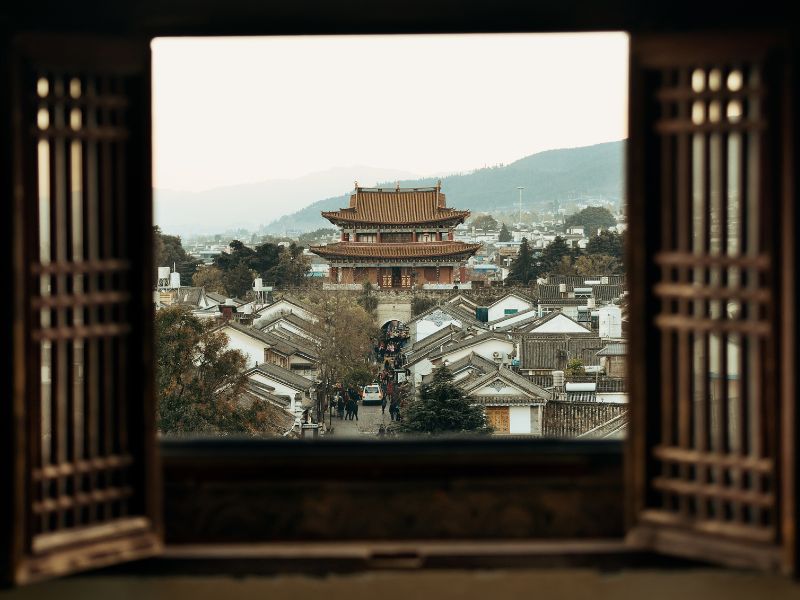
Dali Transportation Guide
Here’s a detailed guide on getting around Dali, ensuring you make the most of your visit.
Getting to Dali
By Air : The closest airport is Dali Airport, serving both domestic and limited international flights. From the airport, you can take a taxi or a shuttle bus to reach Dali city center or directly to the Old Town.
By Train : Dali has its own railway station, connecting it with major Chinese cities. The high-speed trains offer a comfortable and efficient way to travel to Dali from places like Kunming, the provincial capital.
By Bus : Long-distance buses run frequently between Dali and other cities and towns within Yunnan Province, including direct routes from Kunming, Lijiang, and Shangri-La.
Getting Around Dali
By Bicycle : Renting a bicycle is a popular way to explore Dali and its surroundings, especially around Erhai Lake and the Old Town. There are numerous rental shops offering bikes for hourly or daily rates.
By Electric Scooter : For a faster mode of transport, electric scooters are available for rent. They offer a fun and efficient way to navigate the city and surrounding countryside.
By Local Bus : Dali’s local bus service is an economical option for getting around, with routes covering the city, Dali Old Town, and major attractions. Buses are frequent, and routes are well-marked, making it easy to navigate the area.
By Taxi : Taxis in Dali are readily available and reasonably priced. They can be hailed on the street or ordered through your hotel. Always make sure the meter is running to avoid overcharging.
On Foot : Walking is perhaps the best way to explore Dali Old Town, where the streets are lined with historical buildings, artisan shops, and cafes. Many of Dali’s attractions are within walking distance of each other, making it a pedestrian-friendly option.
Private Car or Van Hire : For those looking to explore more remote areas or preferring a personalized itinerary, hiring a private car or van with a driver for the day is a convenient option. This can be arranged through travel agencies or hotels in Dali.
Tips for Travelers
- Public Transportation : While public buses are cheap and efficient, they can get crowded during peak tourist seasons. Always keep an eye on your belongings.
- Bicycle Rides : When cycling, especially around Erhai Lake, be prepared for sudden weather changes and carry necessary supplies like water and snacks.
- Navigating the Old Town : The charm of Dali Old Town is best experienced on foot. Wear comfortable shoes and be ready to explore its narrow, cobbled streets.
- Language Barrier : Not all taxi drivers or bus operators speak English, so it’s handy to have your destination written in Chinese or a map app to show them.

Where To Visit After Your Trip To Dali?
Here’s a list of destinations that promise to extend your adventure with more unforgettable experiences.
Just a few hours north of Dali, Lijiang awaits with its ancient town, a UNESCO World Heritage site, famous for its well-preserved architecture and waterways. Explore the cobbled streets, visit the iconic Black Dragon Pool, and soak in the views of Jade Dragon Snow Mountain. Lijiang’s vibrant Naxi culture and bustling night markets offer a deep dive into the local heritage.
2. Shangri-La
Venture further into the mystical landscapes of Yunnan to discover Shangri-La, a city that embodies the region’s natural and cultural splendor. The Songzanlin Monastery, resembling a mini Potala Palace, and the breathtaking views of Pudacuo National Park are highlights. Shangri-La is also the gateway to the Tibetan cultural area, offering a glimpse into the traditions and lifestyles of the Tibetan people.
Known as the “City of Eternal Spring” for its pleasant climate, Kunming, the provincial capital, offers lush parks, historic temples, and the mesmerizing Stone Forest. It’s a vibrant city where modernity meets tradition, offering a range of cultural experiences, from the dynamic Yunnan Nationalities Village to the tranquil Green Lake Park.
4. Yuanyang Rice Terraces
For those willing to venture further, the Yuanyang Rice Terraces offer some of China’s most spectacular landscapes. These intricately constructed terraces change colors with the seasons and provide breathtaking sunrise and sunset views. The area is also home to several ethnic minorities, including the Hani people, offering rich cultural interactions.
5. Tiger Leaping Gorge
One of the deepest gorges in the world, Tiger Leaping Gorge offers one of the most dramatic treks in China. The trail provides stunning views of the Yangtze River as it forcefully makes its way through the gorge. It’s a challenging hike that rewards adventurers with unparalleled natural beauty and a sense of accomplishment.
6. Jinghong, Xishuangbanna
Experience the tropical side of Yunnan in Jinghong, the heart of the Xishuangbanna Dai Autonomous Prefecture. The region is known for its lush rainforests, wild elephants, and the rich culture of the Dai people. Visit the Xishuangbanna Tropical Botanical Garden and enjoy a traditional Dai water splashing festival if you’re there in April.
7. Puzhehei
Nicknamed “the Guilin of Yunnan,” Puzhehei offers stunning karst landscapes, clear lakes, and peaceful boat rides. The area is dotted with small villages and vibrant lotus blooms in the summer, offering a perfect blend of natural beauty and rural life.
In spring, Luoping transforms into a sea of yellow as the canola flowers bloom, creating one of China’s most stunning natural displays. The area is also known for its unique karst formations and the spectacular Jiulong Waterfall.
9. Dianchi Lake
Just outside Kunming, Dianchi Lake offers a scenic escape with its vast waters bordered by mountains and parks. Enjoy a leisurely boat ride, explore the surrounding temples and pavilions, and don’t miss the impressive Dragon Gate in the Western Hills.
10. Jianshui
An ancient town with over 1,200 years of history, Jianshui is renowned for its traditional architecture, including the Chaoyang Gateway Tower and the Confucius Temple. It’s a lesser-visited gem that offers a deep dive into the Ming and Qing dynasties’ culture and architecture.

Dali Travel Guide: Final Thoughts
As we draw our Dali travel guide to a close, let’s reflect on why this city is more than just a stop on your itinerary—it’s a journey into the heart of Yunnan’s mesmerizing blend of nature, culture, and history.
A City That Lives Its History
Dali doesn’t just rest on the laurels of its past; it wears its history with pride. From the ancient walls that encircle the old town to the tranquil temples that have witnessed centuries unfold, Dali offers a living, breathing history lesson that’s accessible to all. It’s a place where every stone tells a story, inviting you to listen.
The natural beauty surrounding Dali is nothing short of breathtaking. Whether it’s the serene vistas of Erhai Lake that call for contemplation or the rugged peaks of the Cangshan Mountains that challenge adventurers, Dali’s landscapes serve as a backdrop for endless exploration. It’s a reminder of the simple beauty that nature offers to those willing to seek it out.
Dali stands as a testament to the diversity and richness of Yunnan’s cultural heritage. Here, the Bai people’s traditions thrive alongside a growing community of artists, travelers, and expats, creating a vibrant mosaic of life that’s as colorful as the tie-dye textiles found in the local markets. Dali is a place where cultures not only coexist but flourish together.
The Flavors of Dali
Your taste buds are in for a treat in Dali, where the cuisine is as diverse as its landscapes. From street food stalls serving up mouth-watering snacks to restaurants offering fusion dishes that marry local ingredients with international flavors, Dali’s culinary scene is a delight. Each meal is an opportunity to explore the region’s bounty.
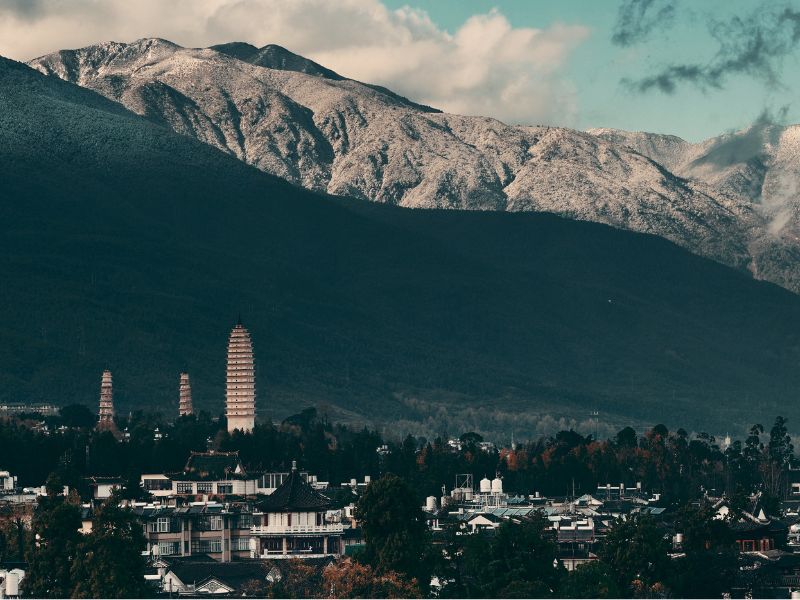
Ode To Dali
In the land of Dali, where mountains meet the sky, A place of beauty, where ancient echoes lie. Wander through the streets of Old Town’s embrace, With Bai-style architecture, a glimpse of grace.
Three Pagodas stand tall, proud and strong, Whispering tales of history, a legacy that’s long. Erhai Lake glistens, serene and pure, Reflecting the beauty that will endure.
Xizhou Village beckons, with its charm untold, Bai culture and traditions to unfold. Step into the past, where time slows down, As ancient customs and crafts are found.
Cangshan Mountain calls, with trails to explore, Nature’s wonders, to captivate and adore. Rivers and waterfalls, a symphony of sound, A sanctuary of peace, where solace is found.
Shaxi’s ancient streets, a portal to the past, Trade routes and stories that forever last. Shibaoshan’s grottoes, a spiritual retreat, Carved in stone, a treasure to meet.
Journey further to Lijiang, Shangri-La, and beyond, Yunnan’s beauty, an enchanting bond. Immerse in the colors, the flavors, the sights, A traveler’s delight, where dreams take flight.
Oh, traveler, let Dali’s essence touch your soul, With each step, a new story to unfold. Embrace the wonders, the cultures, the art, In the heart of Dali, a journey to start.

How to Plan a Trip to Dali
Dali is always on the top destinations list for a Yunnan tour. The famous Chinese TV drama Meet Yourself (去有风的地方) was filmed in Dali. People are attracted by its quiet and romantic vibe. In this article, you will learn about how to plan a trip to Dali through considering these aspects:
- What Are the Must-Sees ?
- How Many Days for a Dali Trip ?
Best Times to Visit Dali
How to get to dali, where to stay in dali.
- Find Your Ideal Dali Trip Here
What Are the Must-Sees?
"Wind, flowers, snow, and the moon" are Dali's romantic theme. This is also the best summary of Dali's scenery.
Here we have handpicked Dali's most popular five attractions suitable for all kinds of visitors.
Some local cultural experiences are highly recommended to add into your trip plan, such as learning to make flower cakes and trying Bai tie-dyeing in a traditional Bai village at the foot of Cangshan.
Fengyangyi Village, Shaxi Ancient Town, and Xizhou Ancient Town are picturesque settings in the popular TV drama 去有风的地方. If you're interested in visiting these captivating locations, feel free to contact us , and we'll create your trip based on your preferences and needs.
Our recommendations are for your reference. You should make adjustments based on your own interests and preferences. We are happy to create a trip for you according to your requirements.
Also see the Ultimate 7 Things to Do in Dali or Top 7 Attractions to See in Dali to get some inspiration.
How Many Days for a Dali Trip
It takes 4 days for a Dali trip that visits the essential attractions and has some cultural experiences. Here is our suggested itinerary:
- Day 1: Dali arrival + Dali Old Town
- Day 2: Cangshan Mountains exploration with tie-dyeing experience
- Day 3: Bike around Erhai Lake with flower cake making
- Day 4: Departure
If that looks good to you, check out more details on 4-Day Dali Dynamic Tour .
Our tours are flexible. The itinerary can be adjusted according to group size, time, budget, interests, and other requirements. Just contact us .
Extending Your Dali Tour
To fully enjoy the landscape of Yunnan, you could extend your trip to Kunming and Lijiang. A week's journey is recommended — see 7-Day Kunming, Dali, Shaxi, and Lijiang Tour , outlined below:
- Day 1: Kunming arrival + free time
- Day 2: Stone Forest + Dian Lake; transfer to Dali by a bullet train
- Day 3: Dali Old Town + the Three Pagodas + flower cake making
- Day 4: Jianchuan Ancient Town + Shaxi Ancient Town
- Day 5: Transfer to Lijiang; Lijiang Old Town
- Day 6: Dragon Snow Mountain + Baisha Village
- Day 7: Lijiang departure
Contact us if you have any questions or requests. You could also tell us your interests and requirements, and we will create a trip for you.
The best times to visit Dali are from March to May and mid-October to November.
As the saying goes "March in Dali witnesses a superb view": you will see a beautiful Dali in March and April, when the flowers are in full bloom and there is lots of sunshine and fresh air.
Top Weather Tips:
- Sun protection is important because UV rays in Dali is strong.
- The daily temperature variation is great, especially after the rain. Layered clothing that can be easily carried is advisable.
- Rain mainly falls in July and August. It is likely to spoil views for periods of a few hours.
Check out Dali Weather to discover the best places to go in each season in Lijiang and more top tips.
Dali has an airport and a railway station that connect with other cities in China and Yunnan.
Several domestic cities have direct flights to Dali, such as Beijing (4 hours), Shanghai (4 hours), Guangzhou (3 hours), Chongqing (2 hours), Guiyang (2 hours), and Kunming (1 hour).
Driving and taking a bullet train are the two main ways to get to Dali from other cities in Yunnan.
From Kunming to Dali, it's a 2 or 2½ hours' journey by a bullet train.
From Lijiang to Dali, driving is recommended (2½ hours) or a 2 or 2½ hours' journey by normal train.
From Shangri-La to Dali, driving is the only way (4½ hours).
Hotels in the four best places to stay in Dali with convenient locations, regional features, and good reviews are recommended here for your reference:
Dali Old Town — Most Popular Choice
- Luxury and special: The One Resort
- Boutique: Xianju Suhuaying Inn, Gurong Hotel, Dali E-outfitting Boutique Hotel
- Economical: Dali Landscape Hotel
Erhai Lake — Scenic Accommodation
- Luxury and special: Fansu Guanyun Lake View Light Luxury Inn
- Boutique & Economical: Manshan Yise Resort Hotel, Munwood Panorama Resort Hotel
Xizhou Town — Quiet Relaxation
- Luxury and boutique: The Linden Centre, Sky Valley Heritage Boutique Hotel
Shaxi Ancient Town — Stopover between Dali and Lijiang
- Boutique: Shaxi Landscape Hotel, Sunyata Shaxi Hotel, Qing Jing Courtyard
Check out Where to Stay in Dali — 7 Best Boutique Hotels for more details.
Find Your Ideal Dali Tour Here
All our itineraries are customizable. If you have any ideas or requirements, contact us . We will create a trip for you based on your group size, time, budget, interests, preferences, and other requirements.
See our popular Dali tours for inspiration:
- 4-Day Essence of Dali Tour — Feel a Dynamic Dali
- 4-Day Dali and Tea Horse Road Experience Tour — The Past Prosperity of Dali
- 6-Day Yunnan Ethnic Minorities Tour — Kunming, Dali, and Lijiang
- 7-Day Dali, Lijiang, and Shangri-La Tour — A Feast of Landscapes and Ethnic Minority Culture
- 2-Week Private China Tour: Beijing–Xi'an–Lhasa-Shanghai
- 12-Day China Silk Road Tour from Xi'an to Kashgar
- 11-Day China Classic Tour
- 14-Day China Natural Wonders Discovery
- 15 Best Places to Visit in China (2024)
- Best (& Worst) Times to Visit China, Travel Tips (2024/2025)
- How to Plan a 10-Day Itinerary in China (Best 5 Options)
- 8 Days in China: Top 15 Tours and Itineraries (2024/2025)
- China Weather in January 2024: Enjoy Less-Crowded Traveling
- China Weather in February 2024: Places to Go, Costs, and Crowds
- China Weather in March 2024: Destinations, Crowds, and Costs
- China Weather in April 2024: Where to Go (Smart Pre-Season Pick)
- China Weather in May 2024: Where to Go, Crowds, and Costs
- China Weather in June 2024: How to Benefit from the Rainy Season
- China Weather in July 2024: How to Avoid Heat and Crowds
- China Weather in August 2024: Weather Tips & Where to Go
- China Weather in September 2024: Weather Tips & Where to Go
- China Weather in October 2024: Where to Go, Crowds, and Costs
- China Weather in November 2024: Places to Go & Crowds
- China Weather in December 2024: Places to Go and Crowds
Get Inspired with Some Popular Itineraries
More travel ideas and inspiration, sign up to our newsletter.
Be the first to receive exciting updates, exclusive promotions, and valuable travel tips from our team of experts.
Why China Highlights
Where can we take you today.
- Southeast Asia
- Japan, South Korea
- India, Nepal, Bhutan, and Sri lanka
- Central Asia
- Middle East
- African Safari
- Travel Agents
- Loyalty & Referral Program
- Privacy Policy
Address: Building 6, Chuangyi Business Park, 70 Qilidian Road, Guilin, Guangxi, 541004, China

Exploring Dali: A Comprehensive Travel Guide to Must-Do Activities
Nestled in the breathtaking landscapes of southwestern China, Dali is a destination that beckons travelers with its serene beauty and rich cultural heritage. This ancient city, located in the Yunnan province, is renowned for its stunning views of the Cangshan Mountains and the enchanting Erhai Lake. Dali’s old town, with its traditional Bai architecture, narrow streets, and vibrant markets, offers a glimpse into the region’s rich history and cultural diversity.
But Dali is more than just a picturesque setting; it’s a place where you can immerse yourself in a myriad of experiences. From exploring ancient temples and pagodas to discovering local crafts and cuisines, Dali offers something for every traveler.
Come along on this journey as I uncover the numerous factors that make Dali a must-visit destination for your travel bucket list.
You might also be interested in: ⭐ 11 Best Things to Do in Kunming 2023 (Plus a Food Guide!)
Table of Contents
🌟 dali travel planning guide, 👑 best things to do in dali old town, 🚲 best things to do: cycling around erhai lake, 🏔️ best things to do in cangshan mountain, 😋 what to eat in dali, 🛫 how do i travel to dali, 🚖 how to get around dali, ☀️ best time to visit dali, 🏨 where to stay in dali, 🌸final tips on traveling to dali, china travel planning guide&faq.
Disclosure: This article contains affiliate links. If you make a purchase after clicking one of these links, I earn a small commission at no extra cost to you. You can learn more about this in my disclosure policy.
Considering a last-minute trip to Dali? 🇨🇳 Top Activities and Tours in Dali: 1. 1-Day Dali tour with the Daili old town, Xizhou Village and Three Pagodas 2. Dali Yunnan Local Market + Pottery Making Eco Tour 3. Private hiking and trekking tour to Cangshan Mountain from Dali 4. Eat Your Way Through Yunnan’s Tea & Horse Road, from Dali to Lijiang 🏨 Top Hotels in Guangzhou: Tinghua Island Garden Inn (⭐️ 4.9 luxury) OASIS EAST VILLA (⭐️ 4.9 luxury) Oasis The Secret Luxury Hotel (⭐️ 4.8 luxury) Three Colour Chain Inn Dali Erhai (⭐️ 4.9 mid-range) Dali Ancient Luchun Hotel (⭐️ 4.9 mid-range) 🌐Make sure to install ExpressVPN in advance for unrestricted internet access during your stay in China!
Dali Old Town, situated between Cangshan Mountain and Erhai Lake, was built during the Ming Dynasty. Going uphill leads to Cangshan Mountain, while going downhill takes you to Erhai Lake. Despite its small size, this town harmoniously accommodates Buddhist temples, mosques, and Catholic churches, embracing different beliefs.
Like many ancient towns in China, Dali Old Town has been somewhat commercialized. However, fortunately, many indigenous people have not moved away, so you can still immerse yourself in the alleys and markets, experiencing a bit of local life.
Additionally, you can fully enjoy the benefits of commercialization, such as quiet and comfortable inns, street stalls, whether it’s daytime or nighttime, whether you prefer strong liquor or coffee, you can always find a cozy place.
1. Confucian Temple
The Bai people, who value culture, had a tradition in ancient times: when a new life was born, they would take the newborn to the Confucian Temple, scoop up some soil from the temple, and place it in the baby’s swaddle. They would then go to the Martial Temple, scoop up some soil, and also place it in the swaddle, praying for the child to excel in both literary and military skills in the future.
Today, the Confucian Temple seems to serve more as a landmark of the ancient town. It is the busiest area in the ancient town, where Foreigner Street, Renmin Road, and Fuxing Road intersect. During the Spring Festival, camellias in the courtyard bloom one after another, decorating the spring of the old town.
🎫Admission ticket: free ⏰Opening hours: 8:00 AM – 6:30 PM
2. Dali Old Town Catholic Church
The essence of Renmin Road is hidden in the branching alleys. In the alley at the intersection of Renmin Road and Xinmin Road, there is a Catholic church with a blend of Chinese and Western styles. Built in 1927 by French missionary Father Yè Měi Zhāng, was once the only Catholic church in Dali Old Town.
Unlike other churches with Western styles, this Catholic church fully adopts the local “Bai” architectural style. With carved beams and painted rafters, as well as traditional Chinese paintings, it is incredibly magnificent.
🎫Admission ticket: free ⏰Mass Time: Weekdays 07:00 (Monday to Saturday); Sunday 09:30.
3. Foreigner Street
Foreigner Street is not the formal name of a street, but a small section of the ancient city’s Huguo Road. Initially, this area was designated by the local government as a specific residence for foreign tourists, so foreign visitors gathered here throughout the year, leading to its later renaming as “Foreigner Street.” Nowadays, with gradual opening up, it’s difficult to find traces of foreigners on Foreigner Street, but it remains lively.
On the over 1000-meter-long Foreigner Street, there are many Western-style shops, as well as a place to enjoy Western cuisine. In the evening, the bars on the street start operating, making it particularly lively.
There are many small shops such as jewelry stores, antique shops, Tie-dyeing workshops, galleries, etc., selling Bai ethnic snacks and souvenirs. You can stroll and shop along the way, but prices are on the higher side.
4. Wuhua Tower
Wuhua Tower, once used for official gatherings and hosting honored guests, is now a prominent feature of Dali Old Town. Despite its tumultuous history of being built and destroyed three times, what stands today is a reconstruction from the 1990s, designed to resemble the Ming Dynasty Wuhua Tower.
While there may not be much to see from the ground, ascending the tower to overlook the ancient town offers a captivating view . Of particular note, the top floor houses an affordable café, allowing visitors to enjoy a relaxed afternoon at the highest point in the ancient city for a modest fee of CNY 10-20.
5. Grand Marshal’s Mansion (Dali Museum)
The Grand Marshal’s Mansion, originally the Dali Governor’s Mansion in the Ming and Qing dynasties, is now the Dali Museum.
From ancient times to the Ming and Qing dynasties, the history of Dali can be glimpsed here. The courtyard’s collection of steles from various dynasties is the museum’s most valuable treasure , with over 120 ancient steles from the Song Dynasty to the Qing Dynasty, providing detailed descriptions that serve as the best historical guide to Dali.
The museum is open from 08:30 to 17:30 daily from April 1 to October 31, and from 09:00 to 17:00 on other dates, closed on Mondays.
6. Dali Art Factory
This area was once an old factory in the old town that has been transformed into an art district. It’s situated at the end of a deep alley, making it challenging for most tourists to find.
Despite the presence of old factory buildings and signs from the 1990s, the area is now filled with trendy tea houses, small theaters, vintage clothing stores, bookshops, galleries, coffee shops, photography studios and more.
It’s known as the “most artistic area in Dali,” yet it’s relatively small, serving as a hub for young artists and photographers in the area. Visiting here provides a unique opportunity to experience an industrial atmosphere that’s rare within the old town.
7. North Gate Market
North Gate Market is the largest market in the old town , with various stalls lining both sides of the small road. Local residents bring their own products and set up stalls randomly, simply laying out a piece of cloth or placing a basket on the ground to create a stall.
This market offers a range of products including locally pickled rose sugar, fresh local vegetables, and various mushrooms, all at reasonable prices. Local residents typically navigate the market with bamboo baskets, which are convenient for carrying their purchases.
More than 90% of travelers heading to Dali will definitely visit Erhai Lake. It complements Cangshan Mountain, forming the ultimate business card for the most splendid scenery in Dali.
Circling around Erhai Lake , you’ll encounter islands, sandbars, forests, villages, and more, gathering various must-visit destinations in Dali, including the ancient city, Xizhou village, Shuanglang Town, Little Putuo Island, and the urban area.
📌Cycle around the Erhai Lake
Erhai Lake is vast, and if you have ample time, circumnavigating it is the most suitable and representative way to explore. A tour around Erhai Lake typically starts from Dali Old Town and takes 1 to 2 days. Whether by car, self-driving, or biking, this itinerary can connect several must-visit destinations around the lake.
However, for a more immersive experience, it’s recommended to allocate two days . It’s suggested to travel clockwise from west to east, allowing you to catch the mesmerizing sunset over Erhai Lake in the east.
🌞 For a one-day trip: Starting from Dali Old Town in the morning, you can follow the route of Xizhou Village – Haishe Ecological Park – Shuanglang Town – Wase Village – city area – Longkan Wharf, and return to Dali Old Town in the evening. Renting a car is recommended for a one-day tour to complete the circuit around Erhai Lake in one go, while biking would cover only half the distance. You can plan the itinerary according to your preferences.
8. Majiuyi Village
Majiuyi is a Bai village in the middle section of the western shore of Erhai Lake. Near the village, there are some oddly shaped trees growing by the lakeside, which gives an artistic feel. Since 2013, the village has rapidly built rows of hotels and inns along the lakeshore, gradually forming a linear hotel cluster.
Apart from the coastal houses developed into hotels, the rest of the village remains intact. There are wide asphalt roads, old ladies in Bai costumes, and white-walled and grey-tiled houses, and if you look closely, you’ll find almost every household grows flowers.
However, the most spectacular scenery in Majiuyi is the metasequoia forest that gradually turns red from November onwards. This metasequoia forest is quite extensive, and when the autumn wind blows, the leaves flutter in the breeze, as if the red clouds have spilled all over the ground.
9. Panxi Village
Panxi Village is a quiet little village by the side of Erhai Lake. Only some inns are built on the side facing Erhai Lake, while the rest of the village maintains the local way of life without being completely commercialized.
Most families in the village are well-off, with square courtyards, three-story small buildings, and yards full of fruits and vegetables, and poultry, living a carefree life.
However, the most famous attraction in Panxi Village is the “Erhai S-shaped Bend,” which is the widest part of Erhai Lake and provides a special viewpoint for admiring the lake, making it a wonderful place to view the lake.
Panxi Village is only a 20-minute drive from Dali Old Town. If you are not driving, there is no need to worry about the inconvenience of getting in and out of the village, as there are many private cars nearby that provide 24-hour shuttle services for tourists. Also, you can ask the hotel owner to call a familiar driver to pick you up.
10. Xizhou Village
If any town embodies the history of Dali, it is Xizhou Village. With over 80% of its residents being Bai people, Xizhou has preserved a large number of residential buildings dating back to the Ming and Qing dynasties, making it the best-preserved cluster of Bai ethnic dwellings in Dali. Compared to Dali Old Town, Xizhou has a richer cultural atmosphere.
Bai architecture is characterized by its predominant white color , with white walls and grey tiles. The town boasts hundreds of Bai residential buildings from the Ming, Qing, Republic of China, and contemporary periods, such as the Yan Family Compound, Yang Family Compound, and Mansion of General Yin, symbolizing the Bai people’s pure and simple way of life.
Many murals can be found throughout the town, and elderly people often dress in Bai tie-dye jackets and wear Bai ethnic accessories, showcasing the ethnic charm.
In Xizhou Village, every street and alley has its own unique features, all clean and tidy, without an overwhelming number of tourists. There are many shops renting ethnic costumes and selling tie-dye fabrics, which are a must-try experience!
Xizhou’s Posu Baba (“喜洲破酥粑粑”) is a must-try local snack when visiting Dali! It’s a kind of crispy pancake made mainly from flour, similar to a Western pizza. It comes in sweet and savory flavors. The savory version is sprinkled with green onions, Sichuan peppercorns, and minced pork, while the sweet one is flavored with ham and rose sugar, making it deliciously crispy and fragrant.
P.S. Xizhou is a bit far from the shore of Erhai Lake. If you’re just wandering around the town, you’ll need about 1-2 hours to explore.
11. Haishe Ecological Park
Haishe Ecological Park is a lush, pristine wetland park. The park sits on a long, narrow sandbar, extending into the sea on three sides.
Entry to Haishe Ecological Park is free, and the island retains its original beauty with almost no facilities, except for a gate at the entrance prohibiting motor vehicles. You can see vast stretches of trees and tall grass, with the clear, blue waters of Erhai Lake in the distance.
The park is not very large, featuring many oddly shaped trees reflecting in the water, which is a major characteristic of Haishe Wetland Park. Aside from the submerged dead trees, abandoned boats, and a derelict coffee house, there is also a large tree at the end of the park known as the “couple tree,” which is a must-see sight.
📍Location: Haishe Ecological Park is 3 kilometers from Xizhou Village and can be reached by bike in about 15 minutes.
12. Zhoucheng Village
Zhoucheng Village is the largest Bai ethnic village in Dali, renowned for its tie-dye fabrics and embroidery, earning it the title “the hometown of Bai tie-dye.”
As you enter the village, you’ll pass by an ancient opera stage and two large green trees. Despite ongoing renovations in the village, it still retains a unique sense of simplicity and authenticity. The lively market, various local snacks, and locals dressed in ethnic attire carrying bamboo baskets.
One of the highlights is experiencing traditional tie-dye, as Zhoucheng is the home of Bai tie-dye art. Every household along the road is a tie-dye workshop, with blue and white patchwork hanging along the street. Even if you’re just wandering around aimlessly, you’ll likely be greeted by one or two Bai grandmothers inviting you to visit their dyeing workshops.
13. Shuanglang
Shuanglang, once a small fishing village and a crucial stop on the Southern Silk Road, boasts some of the best lakeside views in Dali. As a relatively new and popular destination, it attracts travelers from all over China.
The town of Shuanglang has developed a vibrant commercial atmosphere, with various bars, guesthouses, and souvenir shops. If you choose to stay in Shuanglang, opt for a room with a view of the lake. From the balcony, facing Erhai Lake, one can witness stunning sunrises and sunsets with just a window open.
There are two places in Shuanglang where you need to buy tickets: Nanzhao Island and Yuji Island . Nanzhao Island features a resort, a statue of Guanyin (the Goddess of Mercy), and a small beach. While Yuji Island boasts two unique villas, the Sun Palace and the Moon Palace, both with avant-garde designs, making them upscale accommodations. Personally, if you’re looking to explore, Yuji Island is worth the visit.
If time allows, consider taking a boat tour around the islands. Operated by local villagers, these tours last about 25 minutes, offering panoramic views of each island along with the chance to dip your toes in Erhai Lake and enjoy the breeze—a truly relaxing experience.
14. Wase Village
Compared to the well-known Shuanglang, Wase Village is much quieter and more off the beaten path. However, to photographers, it is considered the best spot along the Dali Erhai Lake circuit for taking pictures.
Little Putuo Island , built during the Ming Dynasty, is a pavilion-style two-story building constructed in the middle of the sea. Visitors can take a boat to the island for sightseeing. Every winter, the island is filled with a large number of red-billed seagulls, attracting many bird watchers. If time is limited, it’s still worth driving by to admire from a distance.
At the Wase Pier, there is a platform that extends directly into the water, offering a perfect vantage point for admiring Cangshan Mountain and enjoying the sunset glow.
Luwo Mountain Relic Site is a hidden gem located 1 kilometer from Wase towards Shuanglang along the coastal road. It features a small cliff by the sea with extensive dry grasslands, solitary trees extending into the sea, and a beach below covered in rocks. However, when descending the mountain for photography, safety should be a top priority.
15. Cangshan Mountain
Cangshan Mountain is an integral part of tourism in Dali. In recent years, it seems that Erhai Lake tourism has become more popular, but I believe that the scenery of Cangshan Mountain is just as impressive as Erhai Lake. Dali has become even more spiritually rich because of these mountains and waters.
Taking a Cable Car
The most common way to visit Cangshan Mountain is to take the cable car directly up the mountain. The entire Cangshan Mountain spans over 40 kilometers from north to south, with complex routes within the mountain. Hiking requires a good level of physical fitness and familiarity with the routes.
Among them, the Xima Pool Cableway is the best way to appreciate Cangshan Mountain. Taking the Xima Pool Cableway to the top of Cangshan Mountain takes about 40 minutes, with a transfer station midway. Finally, you reach an altitude of about 3900 meters.
From the clear sky at the beginning to the misty fog on the mountaintop, you can experience the most mysterious and enticing scenery of Cangshan Mountain, including the glacier relics, azalea forests, and fir forests. This cableway is also the longest one on Cangshan Mountain.
Yudai Rd (Jade Belt Rd) is a stone path that crosses Cangshan Mountain, resembling a jade belt hanging between the six peaks and five streams of Cangshan Mountain. Yudai Rd is 16.2 kilometers long, and it takes about 6 hours to complete the entire route.
This is a route designed specifically for walkers , with a relatively gentle stone path that passes through many important attractions of Cangshan Mountain and offers views of Dali Valley. As Yudai Rd connects with three cable cars, some people choose to hike the Yudai Rd while using different cable cars for ascent and descent.
The Best Time to Visit Cangshan Mountain
The best time to visit Cangshan Mountain is during the spring ( March to May ) and autumn ( September to November ) seasons. Spring showcases the mountains draped in vibrant red azaleas, a breathtaking spectacle. In winter, visitors can witness the Cangshan Snow, one of the Four Wonders of Dali. Sometimes, the cableway may close due to weather conditions.
Personally, I find winter less beautiful than spring because Cangshan’s vegetation is lush and vibrant during that time . Without the adornment of flowers and trees, it would be somewhat regrettable.
🎫Xima Pool Cableway round-trip ticket: Peak Season (Apr. – Oct.): CNY 335 Off-Peak Season (Nov. – Mar.): CNY 275
👉 Book Cangshan Mountain Hiking Tour on VIATOR
16. Three Pagodas
Chongsheng Temple, a royal temple from the time of the Nanzhao Kingdom, was the largest and grandest temple in Dali’s history. Although the temple has been abandoned and rebuilt, its most striking feature, the Three Pagodas, has stood tall here for over a thousand years.
The Three Pagodas consist of one large pagoda, known as the Qianxun Pagoda, and two smaller pagodas. The Qianxun Pagoda, at 69.13 meters tall, boasts a simple and majestic exterior with unique eaves, reflecting the Tang Dynasty architectural style.
The two smaller pagodas are adorned with Buddha statues, lotus flowers, and treasure vases, and their charming shapes contrast with the more solemn Qianxun Pagoda.
For a better view of the Three Pagodas, visitors can climb to the higher buildings in the Chongsheng Temple complex. The temple area is constructed along a central axis, with main buildings such as the Daxiong Hall and Yutong Guanyin Hall aligned on this axis. Walking along the central axis, visitors are greeted by the solemnity of the temple.
For a quieter and more serene place to admire the Three Pagodas, the Reflection Park is a good choice. Located outside Chongsheng Temple, this small park has fewer visitors and offers the best angles to capture the reflection of the pagodas in the water.
17. Wuwei Temple
Wuwei Temple, a royal temple built during the Nanzhao Kingdom, is located at the foot of Cangshan Mountain. The temple follows the tradition of Chan Buddhism and has been home to many eminent monks throughout history.
Wuwei Temple is ideal for those who enjoy a quiet atmosphere. While not grandiose, it holds the status of a royal sanctuary from the Nanzhao Kingdom era, with exceptionally fresh air in the mountains. The temple is often bustling with incense offerings, as it is a place of regular worship for the locals.
In front of the temple, there is a small open space where people often practice morning exercises. Visitors may also encounter scenes of Buddhist ceremonies or foreign monks practicing martial arts. It’s truly a place where you can feel the devoutness of those practicing here.
Note: Wuwei Temple is hidden deep in the mountains, and the road conditions are very poor, consisting of dirt roads. It can be quite tiring to walk, so be prepared if you choose to visit on foot.

Xizhou’s Posu Baba (喜洲破酥粑粑)
Xizhou’s Posu Baba is a famous snack from the historical town of Xizhou, made mainly from flour. It comes in two flavors, sweet and salty. During preparation, a two-tier charcoal fire is used, with intense heat on the top and gentle heat on the bottom. After brushing the prepared dough with lard, it is baked in a pan. During the baking process, the dough is brushed several times with oil to make it crispy and fragrant.
Xizhou’s Posu Baba has a crispy outer shell and a soft interior, earning it the nickname “Eastern Pizza” and making it very popular.
Shengpi (Raw Pork Skin)
During festivals or casual gatherings, the Bai people always showcase their signature dish and specialty, Shengpi, a cold salad made from raw pork.
Shengpi literally means “raw skin,” where an entire pig is roasted over straw fire to remove the hair, and while still fresh, the roasted pork is thinly sliced or shredded.
There are two main ways to enjoy Shengpi: one is to eat the raw skin and condiments separately, dipping the skin in the condiments before eating; the other is to mix the condiments with the raw skin directly, creating a cold salad. Each method has its own unique flavors and textures.
Nuodeng Ham
Nuodeng Ham is a high-quality Yunnan ham, known for its superior taste. It is made using high-quality well salt from Nuodeng, and each ham is cured for three years. The meat near the bone can be eaten raw and is delicious; other parts are excellent when fried, stewed, or steamed.
Nuodeng well salt does not contain iodine but is rich in potassium, which is beneficial for health. It has excellent penetration, making it an excellent choice for curing meat.
Rushan (乳扇)
Rushan is a fan-shaped curd made from milk through a special process, with high nutritional value. It can be eaten raw, but it is best enjoyed when grilled. Eating it raw may have a slightly milky taste, which some people may not like. Grilled Rushan, when paired with condensed milk, rose jam, peanut butter, or chili sauce, is very delicious.
Dali Hot and Sour Fish
Dali Hot and Sour Fish is a traditional dish originating from Shuanglang. People living by Erhai Lake catch fresh fish from the lake, which is then cooked with sour ingredients like green plum or papaya, along with dried chili powder and pickled chili for spiciness. Tofu, potatoes, and other ingredients are added to enhance the flavor, creating a delicious and popular dish that never fails to satisfy.
Cold Chicken Rice Noodles
Cold Chicken Rice Noodles are extremely popular in Dali due to their perfectly balanced sweet and sour flavor. Locals who enjoy spicy and sour flavors love it, and even those with different tastes can appreciate it.
The rice noodles are placed in a bowl and topped with various condiments and braised chicken, then drizzled with homemade sauce, chili oil, Sichuan peppercorn oil, walnut sauce, and more, making it incredibly appetizing!
Yongping Yellow Braised Chicken
Yongping Yellow Braised Chicken uses high-quality local chicken, and while the cooking method is simple, getting the timing right is crucial.
The yellow braised chicken has a great texture and is chewy. Experienced chefs can usually make a plate of fragrant yellow braised chicken in about ten minutes. The spiciness of the dish can vary between restaurants, so if you can’t handle too much spice, it’s best to let the chef know. Most restaurants in Dali make delicious yellow braised chicken.
Braised Pork with Carved Plum
Carved Plum is a traditional specialty of the Bai ethnic group in Dali, and is one of the most delicious snacks in Dali.
Green plums harvested in spring are carved with patterns by local girls, gently pressed to form chrysanthemum shapes, and then shaped into serrated plum cakes. These cakes are placed in a basin of water, sprinkled with a little salt to remove the sourness, and then placed in a sand jar. They are soaked in high-quality brown sugar and honey for several months until the plum cakes turn golden yellow, indicating they are ready to be eaten.
The pork used for Braised Pork with Carved Plum is typically multi-layered pork belly, with alternating layers of fat and lean meat. It is steamed together with the carved plums for about 4 hours, allowing the pork to absorb the fragrant essence of the plums. The result is a dish that is rich but not greasy, with a delicious taste. Most restaurants in Dali serve this dish, and it is known for its authentic flavor.
Dali Airport (DLU) is the only airport in Dali City, with direct flights to over 20 domestic destinations including Beijing, Shanghai, Kunming, Xishuangbanna, Tianjin, Chengdu, Chongqing, Guiyang, and Guangzhou.
Located about 13 kilometers from downtown Dali, 17 kilometers from Dali Old Town, and 3 kilometers from the shore of Erhai Lake.
Dali has only one train station, Dali Railway Station , which offers high-speed trains to and from Kunming, Guangzhou, Guilin, Lijiang, and Shangri-La.
The station is located in downtown Dali, about a 10-minute drive from the city center and 40-50 minutes from the Dali Old Town.
There are currently 30 bus routes within Dali City, with routes like Bus No.4 and No.8 directly connecting to Dali Old Town, with a journey of about 30 minutes (Note: Bus No.4 takes a longer route, while No.8 is shorter, so Bus No.8 is preferred). Bus fares range from CNY 2 to 3.
Additionally, there are many bus routes in Dali that take you from the city center to accommodations and various attractions such as Xizhou Village, Cangshan Mountain, Zhoucheng, and Shuanglang.
Taxis are readily available in Dali and can be found at taxi stands or hailed on the street. It’s advisable to have your destination written down in Chinese characters, as many taxi drivers may not speak English. During the daytime, the first 3 kilometers cost CNY 8, while at night, the fare is CNY 10.
Renting a bicycle is a popular option for getting around Dali. Many guesthouses and rental shops offer bicycles for rent, allowing you to explore the city at your own pace.
Dali has a distinct dry and wet season, with mild winters and not-too-hot summers, making it suitable for travel throughout the year. However, there are some differences in the scenery in different seasons. Generally, the peak season for travel to Dali is from May to October.
For a unique experience, it is recommended to visit during special festivals.
Every April (15th day of the 3rd lunar month) is the “Third Month Fair” in Dali, a traditional ethnic festival with a history of thousands of years. The festival lasts for 7 days, from the 15th to the 21st of the 3rd lunar month.
Every July or August (around the 24th day of the 6th lunar month for the Bai ethnic group and the 25th day of the 6th lunar month for the Yi ethnic group) is the Torch Festival celebrated by the Yi and Bai ethnic groups in Dali.
If you’re looking to have a room with a view of the sea, you can opt for hotels or guesthouses within the Erhai Lake Scenic Area or Shuanglang Scenic Area, but typically, prices are higher in these areas. If you prefer being close to the old town, there are many hotels and guesthouses within Dali Old Town, although prices may also be on the higher side. Additionally, the numerous guesthouses at the foot of Cangshan Mountain are also a good option, offering a relatively higher value for money and just a few stops away from the old town.
OASIS EAST VILLA

This is a hotel that offers standard hotel services along with the personalized touch of a guesthouse. The stay experience is fantastic – breakfast, afternoon tea, and the mini bar are all complimentary; breakfast and afternoon tea can be enjoyed in the room; custom makeup bags and Hermès toiletries are provided; there’s butler service (very attentive but not overly intrusive).
The villa has 6 unbeatable sea-view rooms, each with a spacious layout, a plush and comfortable large bed facing the beautiful Erhai Lake outside the window, perfect for a honeymoon trip. Each room also has a bathtub, perfect for a relaxing soak at night.
Located in a villa area, the hotel offers free shuttle services to and from the airport/high-speed railway station for room bookings. The hotel is a bit far from attractions like Dali Old Town and Shuanglang, but they can arrange taxi services. A taxi to Dali Old Town costs around CNY 70.
👉Read more and check availability on Trip
Three Colour Chain Inn Dali Erhai

This hotel is located right across from Erhai Lake, and it only takes a 2-minute walk to reach Shuanglang and the food street. The hotel features a popular spot for taking photos.
The rooms are decorated in a luxurious European style, with large floor-to-ceiling windows, electric curtains, and amenities such as a swimming pool and bathtub.
Guests can swing on a swing while overlooking Erhai Lake and Cangshan Mountain, or enjoy the sunset on the rooftop terrace. Every part of the hotel, including the restaurant, rooftop, rooms, small garden, and public areas, offers views of the sea and mountains. Guests can also wear local costumes provided by the hotel for photos.
The hotel also offers complimentary afternoon tea desserts and breakfast.
👉 Read more and check availability on Trip
Tinghua Island Garden Inn

Tinghua Island Garden Inn offers 22 sea-view rooms, all arranged in a U-shaped structure around a corner of Erhai Lake. The decor is simple and elegant, with a touch of Mediterranean style. Each room provides a wide view of the lake, offering a beautiful sight of Cang Er’s scenery right outside the window!
What sets this inn apart is the unique design of each room. Some feature swings and private baths, others have rooftop open-air swimming pools, and some even offer panoramic bubble houses!
By the Erhai Lake, there are white tables and chairs for relaxation under the swing, along with white daisies, flowing curtains, Turkish sofas, a variety of pillows, and woolen blankets, creating picture-perfect travel scenes!
Guests can enjoy personalized butler service in each room. The hotel also helps guests plan their travel routes and provides photography services for those who love taking photos, offering them exquisite clothing and props for their pictures!
Oasis The Secret Luxury Hotel

The Oasis The Secret Luxury Hotel is ideally situated, right in the heart of Dali Old Town, offering easy access to shopping and dining. Despite its central location, the hotel provides a peaceful retreat, ensuring privacy and security.
Housed in a renovated old mansion, the hotel boasts a charming courtyard with flowing water, exuding a quaint, ancient charm. The rooms are elegantly styled, perfect for travelers seeking a serene and intimate atmosphere.
The hotel’s services are attentive, including complimentary breakfast, afternoon tea, minibar, and turndown service. Guests can enjoy breakfast and afternoon tea in their rooms, catering to those who prefer a private dining experience. The afternoon tea desserts are exquisite and not for sale. Additionally, the butler serves a bowl of sweet soup every evening, regardless of the guest’s return time.
The rooms are equipped with top-notch amenities, with the bedding receiving high praise. Apart from standard toiletries, guests are provided with face masks and steam eye masks.
However, some rooms may have dim lighting and slightly inadequate soundproofing.
Dali Ancient Luchun Hotel

The hotel is located at the foot of Cangshan Mountain. From a distance, its flying eaves, white walls, and gray tiles, along with the simple shadow walls and wooden corridors, almost become a microcosm of the architectural features of the entire city of Dali.
The hotel has a dedicated fleet that provides free airport shuttle services. Guests can also be transported to Dali Old Town or other destinations as needed, with transportation arranged by the hotel.
The design style of the hotel rooms is modern and minimalist, with retro-style wooden furniture. The rooms are spacious, with large panoramic windows that allow you to enjoy the magnificent view of Cangshan Mountain and the misty Erhai Lake, as well as the lingering charm of the sunset.
The hotel offers a rich and varied breakfast with excellent flavors. The restaurant is stylish, and there is also a café where guests can sit and enjoy the view outside.
- If you plan ahead and aren’t worried about language issues, traveling independently is totally fine!
- External vehicles are not allowed in the Erhai Lake Ecological Corridor. You can only ride bicycles or take the sightseeing cars inside the corridor.
- When renting an electric scooter, try to choose a high-power one. The cute small electric scooters are only good for their looks.
- When hiring a car to travel around the lake, make sure to agree on the price, time, and route with the driver in advance to avoid being ripped off.
- Don’t easily choose restaurants that pull customers on the roadside. There are many delicious foods you can choose online.
- Do not buy fruits with strange colors on the roadside; they are dyed and not tasty or healthy.
- Don’t easily be attracted to niche attractions; they may not be as good as they appear in photos.
- There are many places in Dali suitable for taking photos; there is no need to visit artificially created attractions.
- Choose the right time for seasonal attractions; for example, cherry blossoms and rapeseed flowers bloom in March.
- Dali Ancient Town is suitable for night visits; it will be more atmospheric.
- It is not advisable to buy silver jewelry or antiques in the ancient city; many are fake.
- Dali’s specialties include fresh flower cakes and tea.
- There are many attractions in Dali, suitable for slowing down and experiencing. Don’t try to visit all the attractions in one or two days.
- The ultraviolet rays in Dali are strong throughout the year; be sure to use sunscreen. Dali is also very dry, so moisturize well.
- Most ethnic clothing is of poor quality and similar. If you want to buy a skirt for photos, you might as well visit a clothing store in the ancient city.
🎫Do I need a visa for China?
Yes. Most visitors to China will need a visa to enter the country. The type of visa you need will depend on the purpose and duration of your trip, as well as your nationality. If you are a resident of the US, you must apply for a Chinese visa at the Consular Office in the country. On the other hand, inhabitants of countries like Japan, Canada, and the UK can request a visa through the Chinese Visa Application Service Center .
🤔 Why is it necessary to install a VPN in China?
In China, the government has strict regulations on internet access, leading to the blocking of popular websites and social media platforms such as Facebook, Twitter, Google, and YouTube. To access these sites, a VPN is suggested as a means of bypassing the restrictions. It is important to choose a reputable VPN provider and use caution while doing so. ExpressVPN has been historically deemed the most reliable VPN for this purpose, despite being heavily targeted by China’s censors. Nevertheless, it is still a widely preferred option owing to its ease of installation and user-friendliness.
📲 Is it necessary to have a Chinese SIM card while in China?
Yes. It is crucial to acknowledge that accessing the internet in China may pose limitations due to certain websites being prohibited or filtered. To ensure uninterrupted connectivity while staying in China, purchasing a local SIM card is advisable. For optimum results, acquiring SIM cards from either China Unicom or China Mobile is recommended. While China Mobile has the most comprehensive coverage in China and is a market leader, China Unicom is more compatible with foreign phones, enabling 3G and 4G services. Or you can purchase a SIM card online .
🔮 Should I buy China travel insurance?
Yes. Although China is generally a safe country for travel, it is still possible to encounter accidents or other unexpected occurrences. Therefore, obtaining travel insurance can provide a sense of security and financial protection. In my research, I have found that World Nomads is a reputable travel insurance provider that covers a wide range of activities and is recommended for the average traveler. Nevertheless, I advise you to compare insurance quotes from various providers before making a decision.
🚙 Can you rent a car in China?
Unfeasible . Obtaining a Chinese driver’s license to rent a car and self-drive may seem like an option, but it is not a practical choice for most foreigners. Therefore, many prefer to opt for a driver or public transportation when navigating China, as it proves to be more convenient.
✈️ What’s the best site to purchase flight tickets for China?
I suggest using Trip for affordable flights to China. As a China-based company, they often offer lower prices compared to foreign companies. Additionally, they offer English-speaking phone support in case of any issues.
🏡 What is the best way to book hotels in China?
Not only does Trip offer a wider range of flight options, but it also provides a greater selection of hotels to choose from. Moreover, Agoda is a reliable resource for hotels throughout Asia.
🎒What do I pack for China?
Travel adapter and converter: China uses a different electrical system than many other countries, so it’s important to bring a travel adapter and converter if you plan to use electronic devices such as phones, cameras, and laptops. Sunscreen: The UV index in China can be high, particularly during the summer months, and prolonged exposure to the sun without protection can cause skin damage and increase the risk of skin cancer. Deodorant: It should be noted that finding deodorant in China may not be a simple task.
📚 Can a guidebook for traveling to China be useful?
Yes . If you’re planning to travel to China for the first time, a travel guidebook can be a valuable resource, and Lonely Planet is one of the most reputable guides available globally. Its comprehensive itineraries and recommendations take into account your personal preferences and can save you both time and money. The insider tips are also extremely helpful in navigating China’s unique cultural landscape like a local.
Enjoy these related articles

Leave a Reply Cancel Reply
Your email address will not be published. Required fields are marked *
Name *
Email *
Add Comment *
Save my name, email, and website in this browser for the next time I comment.
Post Comment
Things to do in Yunnan: exploring Dali (大理) Old Town
- June 3, 2024
Dali (大理) is one of the most popular destinations in Yunnan. Don’t miss this post if you want to visit the old capital of the Nanzhao kingdom.
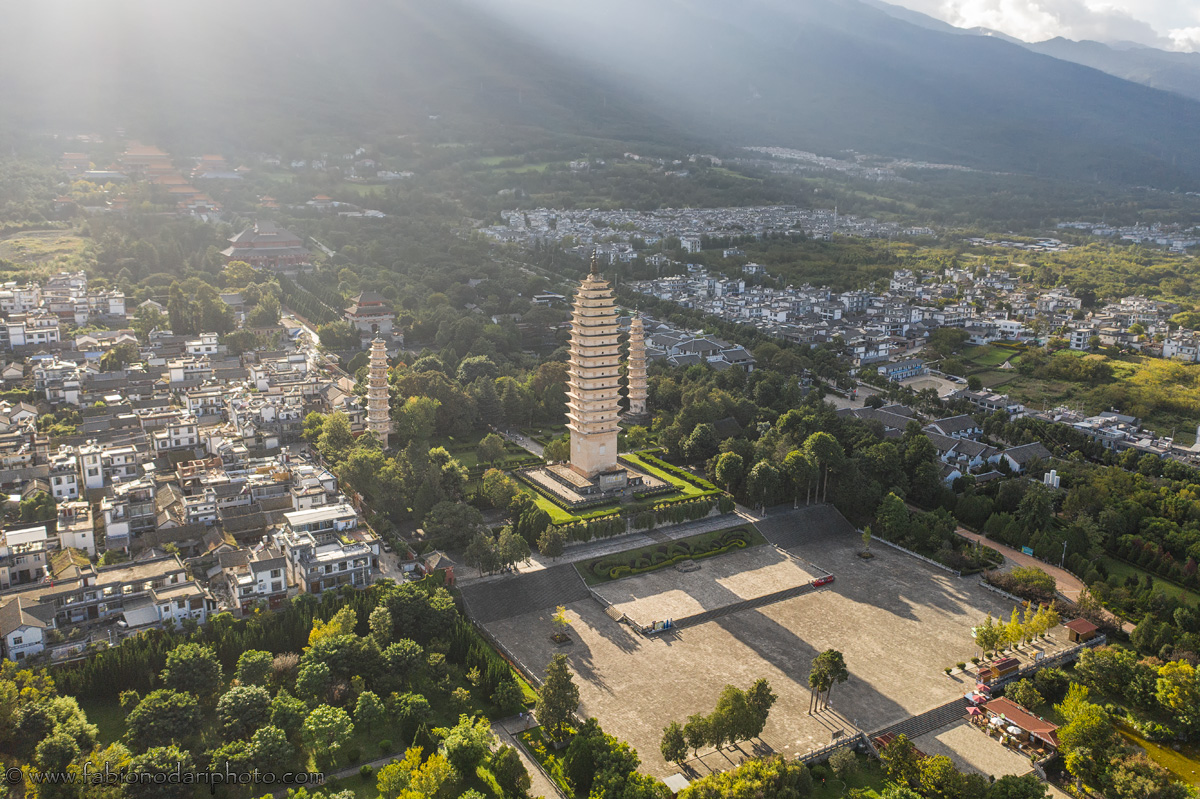
In my blog, I have often talked about Yunnan , one of the most beautiful provinces in China. But my list of places to visit can’t be complete without mentioning Dali , the ancient capital of the Nanzhao kingdom, and the old capital of Yunnan ( don’t miss my Yunnan travel guide ).
Dali is a city with a millenary history. Located at a strategic point along the ancient Tea Horse Road (also known as the South Silk Road) , the Erhai Lake naturally protects it on one side and the Changshan Mountains on the other (whose peaks reach about 4000 meters). Despite being about 2000 meters above sea level, the climate is mild all year round, and the land is fertile. Dali is the most important center for the Bai minority, one of the largest in China and Yunnan.
The Bai population (Bai means white in Chinese) is famous for their ability to work silver and marble and for being able to create many incredible decorations. Bai houses are generally white, with beautiful paintings on the exterior walls. A whole book would not be enough to talk about the Bai culture, so the best thing to do is visit Dali and Lijiang.
Things to see in Dali
The old town of dali.
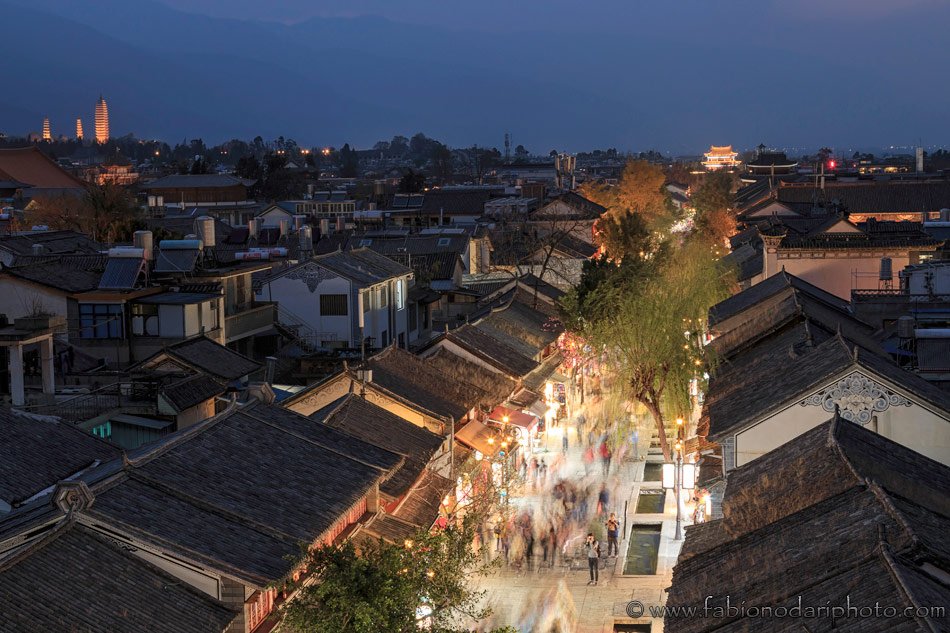
Dali’s main attraction is the old town, one of the few in China surrounded by walls. Unlike Lijiang, Dali is a little more authentic because there are still many families living there. For a panoramic view, I recommend a walk on the walls to enjoy the view of the lake on one side and the mountains on the other.
The two main streets within the city are crowded and full of shops, but if you start wandering around a bit, you will see immediately why many agree that Dali is more authentic than Lijiang. My suggestion is to find accommodation in the old town.
The three Pagodas
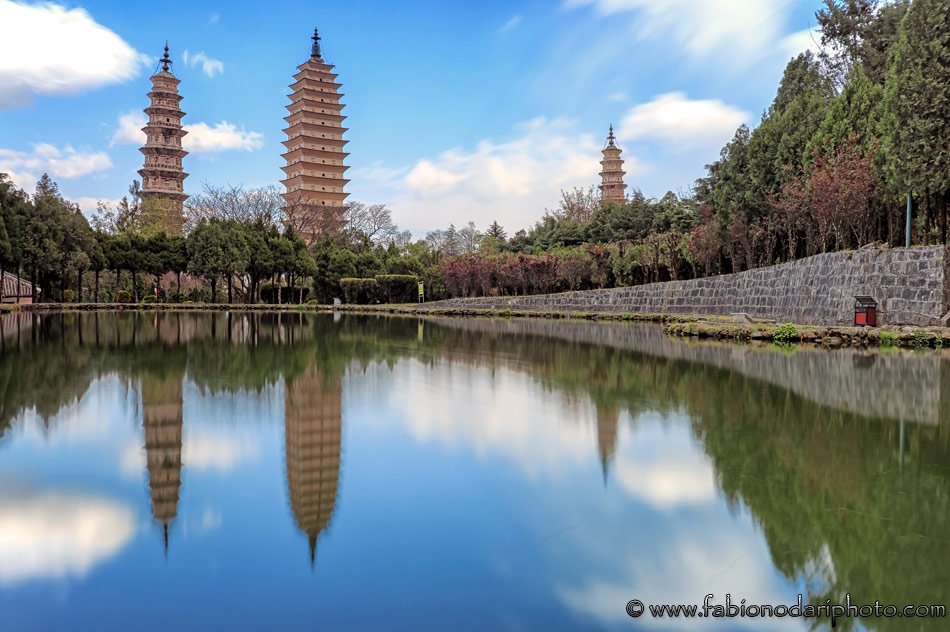
The three pagodas are a complex of temples about 1.5km from the old town of Dali. They can be reached on foot or by taxi. Apart from the three pagodas, you’ll find a complex of temples, and it takes at least a couple of hours to see them all. The three pagodas are different from most other religious buildings in China because they are truly ancient (unfortunately, after the cultural revolution in China, many ancient buildings have been destroyed).
If you want to know more about the Three Pagodas, you will find more info here. Don’t miss the small pond on the right side of the pagodas walking towards the mountain, where you can photograph the three pagodas reflected in the water.
A visit to the houses of the craftsmen
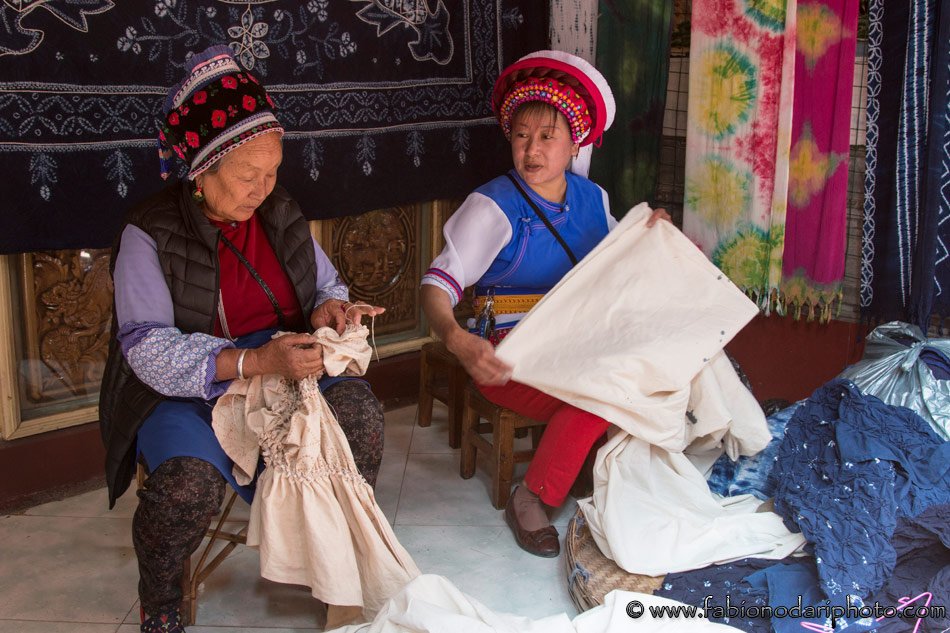
As I said at the beginning of the article, the Bai are excellent craftsmen, and their fame is well deserved. In the Dali area, you can see different forms of craftsmanship. The most interesting one is the processing of Batik fabric. There are different methods to achieve the same objective: coloring the fabric.
In Guizhou Province, the Miao minority uses wax, while in the surroundings of Dali, Bai women sew the fabric in such a way as to create a design that will not absorb the color during the next stage of the production process.
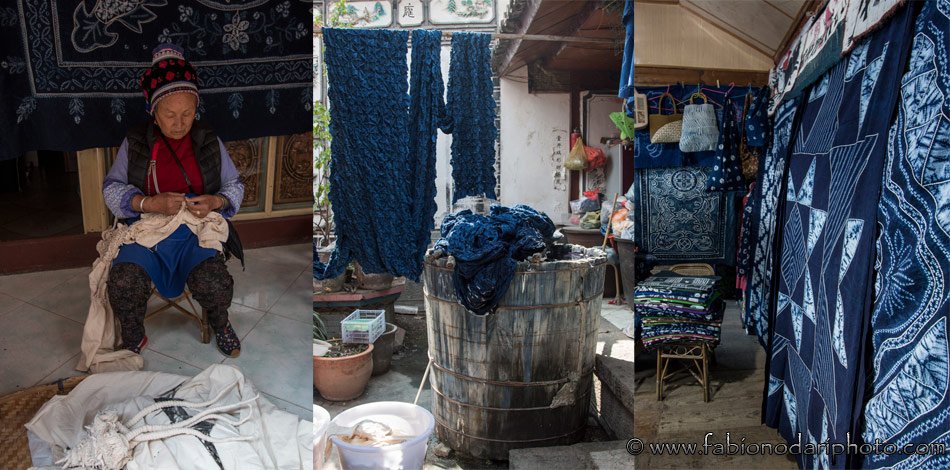
It is a fascinating process that requires a lot of work, and it demonstrates again that there is much to discover in China.
China is the home of silk, and seeing with my own eyes the process that has remained a secret in the rest of the world for centuries was very exciting.
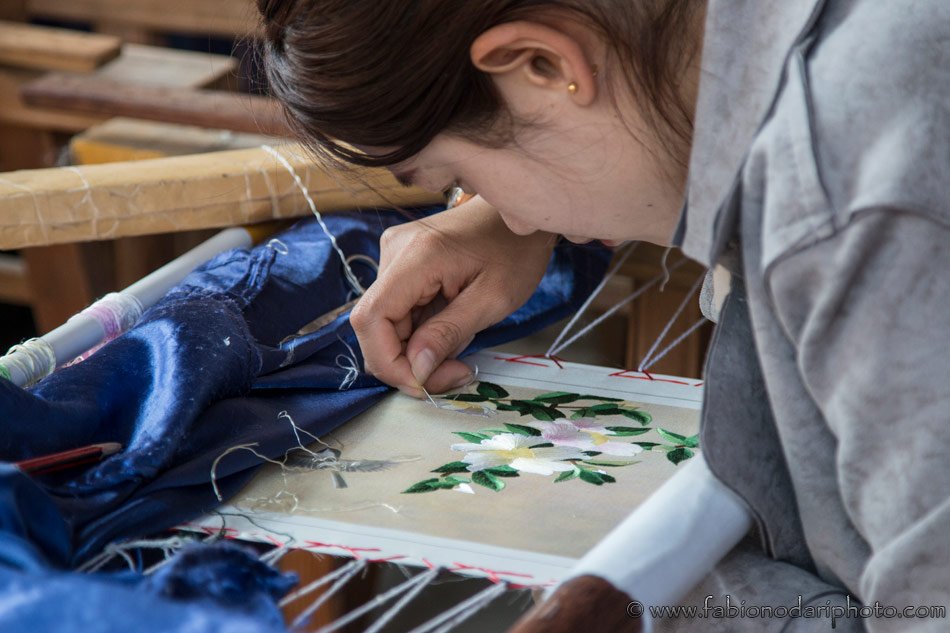
The paintings created by those who know how to work silk are art masterpieces and, as such, have very high prices. One of the paintings cost 13000€ and took 13 months to make.
A visit to the local markets
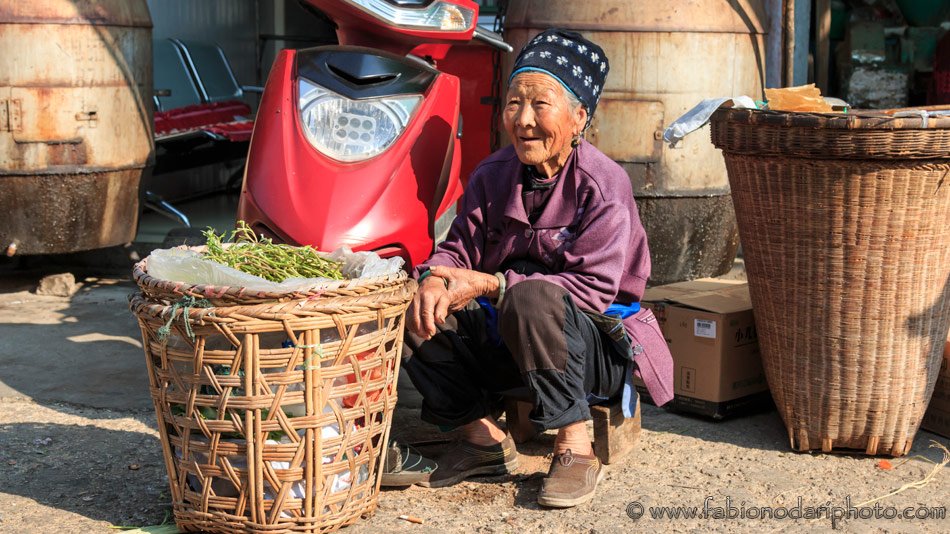
If you’re used to visiting Asia, visiting a local market is not a fundamental experience. If, on the other end, this is your first time, I recommend doing it. It is always interesting to see how local people live, and the market is the ideal place. I visited the one in Xizhou, which is not open every day. I recommend you contact a local agency for accurate information, as I said in the previous paragraph.
A day trip to Shaxi (沙溪)
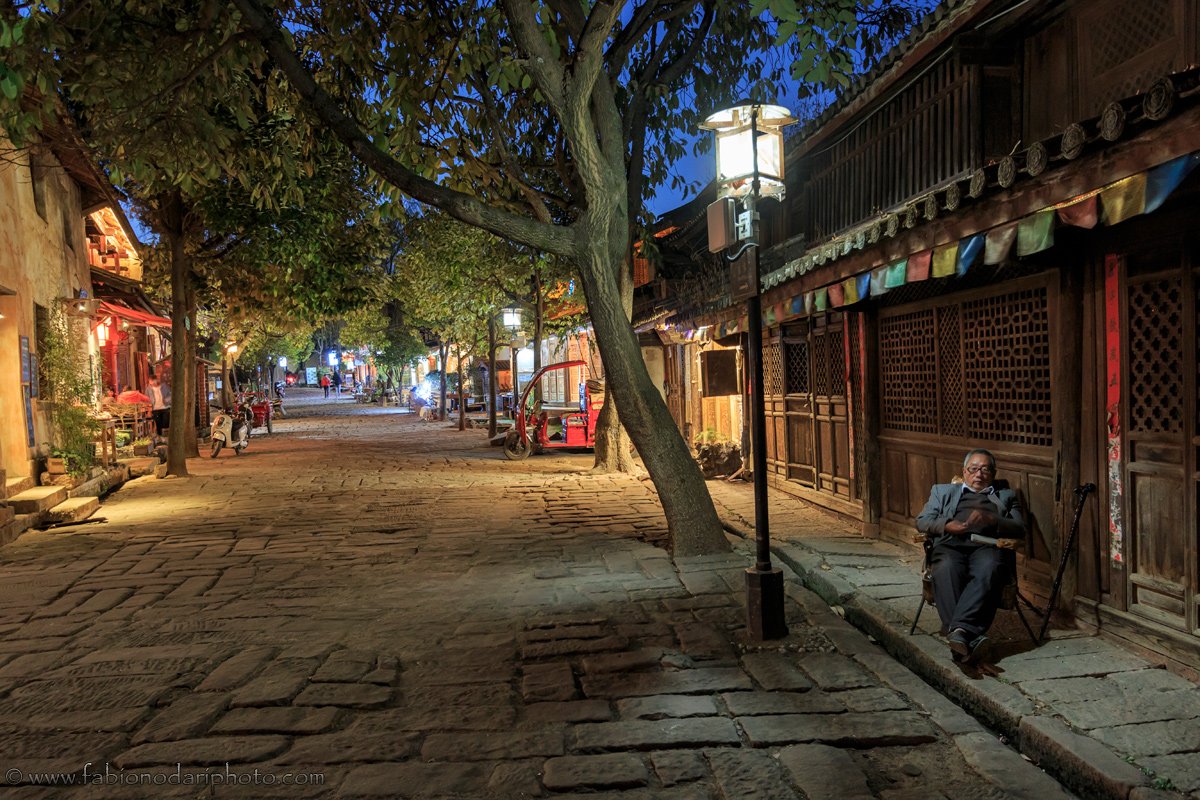
Halfway between Dali and Lijiang, you can find one of the best-preserved old towns along the ancient South Silk Road, also known as Tea Horse Road: Shaxi. If you have enough time, don’t miss it!
Final considerations and tips
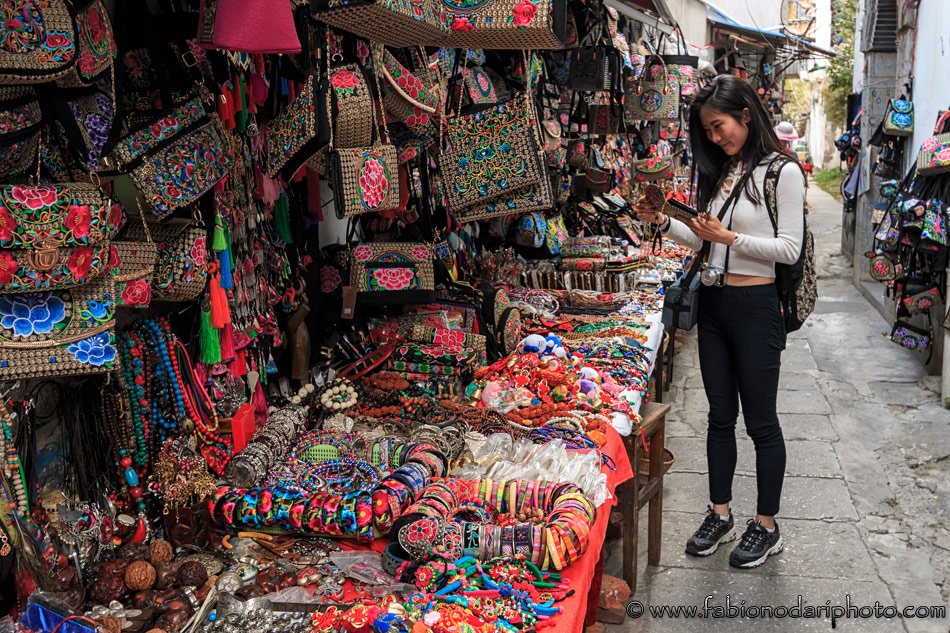
Dali is a place worth a visit for first-time visitors to Yunnan. But even if you’ve been there before, it’s still nice to come back occasionally to enjoy rural Chinese life without sacrificing comfort.
Getting there is very easy as there are many trains and buses departing from Kunming every day. One very important thing to remember is that Dali is divided into two parts: Dali Old Town (the one I talked about in this post) and the new city of Dali called Xiaguan. All means of transport, or almost all, arrive in Xiaguan and NOT in Dali Old Town. From there you must take a taxi to the Old Town 10 km away.
For the accommodation, I recommend Trip.com since it has way more options than other search engines.
To conclude, before visiting China, get a VPN , or you will lose access to all social media and Google, including Gmail.
Here, you can find more pictures I took in Yunnan . Here is my complete travel guide to China , and here is my two days guide to Shangri-La.

Zhangjiajie (张家界) DIY: a travel guide to the scenic spots
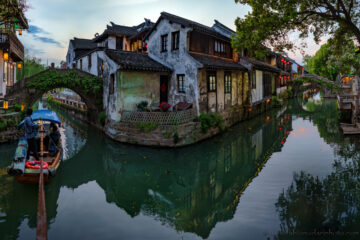
Exploring the Hidden Gems: Best Water Towns between Shanghai to Suzhou
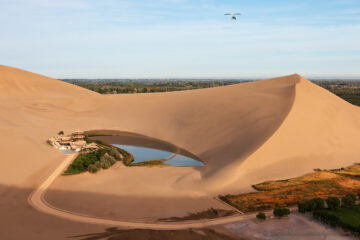
Travel Guide to Dunhuang and its surroundings
4 thoughts on “things to do in yunnan: exploring dali (大理) old town”.
Thanks a lot for this post. Beautiful pictures.
Oh I love the history and its culture as well. I have been a big fan of swordplay Chinese dramas and movies for so many years, especially the transformed works from novels of Kim Dung. Among a bunch of amazing novels. Tian Long Ba Bu makes the strong impression on me with the presence of Da Li country. Thanks so much for your sharing!
Interesting! Thanks for your comment!
Leave a Reply Cancel reply
Your email address will not be published. Required fields are marked *
- 1.1 History
- 2.2 By train
- 2.3 By plane
- 4.1 Old Town
- 4.2 Cangshan Mountains
- 4.3 Other sights
- 7.2.1 Chinese
- 7.2.2 Western
- 7.3 Splurge
- 9.1.1 Hostels
- 9.1.2 Hotels
- 9.2 Mid-range
- 9.3 Splurge
- 11 Stay safe
Dali (大理; Dàlǐ ) is a city in Yunnan Province in China famous for its old town and handicrafts.
Dali is a popular tourist destination for domestic Chinese tourists, one of the string of towns described in Yunnan tourist trail leading up to the beautiful Tiger Leaping Gorge . It is a medium-sized city of 650,000 but its tourist draw is the "Old Town." (大理古城). Like many Chinese tourist destinations, the old town, which has architecture that dates back to the Ming dynasty, has been extensively renovated, rebuilt and modernized, including newly constructed city walls and gates. You can still see the remnants of the old wall in the form of long mounds that surround the old city, but Dali is no longer a walled city by any means. The old town section of Dali is sandwiched between two multi-lane highways. While it lacks the authentic rustic charm of other old Chinese cities (e.g. Pingyao or even Lijiang ) and much of the old town has been renovated and is devoted to tacky knick-knack stores for Chinese tourists, it does sit in the shadow of a beautiful mountain range, the Cangshan and is close to the large Erhai lake. There is an expensive cable car (¥90) that you can take to reach the top and there are some hiking paths that offer beautiful views of Lake Erhai.
But do not expect to find a small ancient city in the beautiful mountains of Yunnan; this is not what you will get. Dali is very spread-out and it takes almost an hour by bus #8 to get from the train station in the modern part of town to the old town. In addition to the popular old town and various traditional villages scattered around the lake, Dali now has an urban core filled with modern buildings, 20-story residential towers, and a Wal-Mart. You can also see factories belching emissions on the other side of Lake Erhai.
In 738 the Nanzhao Kingdom was established; the original capital of the Nanzhao Kingdom was located in Weishan (within Dali Prefecture) and later moved to sites around Erhai Lake. The territory conquered was quite substantial; covered a large area of Yunnan and northern Burma , and parts of what are now Sichuan and Guizhou . The kingdom survived almost 200 years and had 13 kings before collapsing. After several decades of chaos the Kingdom of Dali emerged in 937.
The Kingdom of Dali established by Duan Siping in 937 was controlled by the Duan clan and survived until it was conquered by the Mongols about 300 years later. The Kingdom retained a close alliance with the Song Dynasty, and was one of the major transit points for the introduction of Buddhism throughout the rest of China. By 1000, Dali was one of the 13 largest cities in the world.
The rulers of the original Nanzhao Kingdom were probably precursors to the modern Yi peoples, while the Kingdom of Dali rulers were precursors to the modern Bai minority.
Many local people in Dali have the surname Duan to this day (rare in other parts of China). These historical events are romanticized in the Martial Arts literature of Hong Kong author Jin Yong (read by every Chinese school kid), giving Dali a fame nationwide. The Dali Kingdom had a military alliance with the Song Dynasty against the aggressive Tibetan Empire which made regular incursions into its territories.
A huge memorial stele to the Pacification of Kingdom of Dali was built during the Ming Dynasty and remains standing at the end of Sanyue Street past the city's West Gate. Entrance is free. The Mongols destroyed the old capital and palace of the Kingdom of Dali, just to the south of the Three Pagodas. Almost all records of the Nanzhao and Dali Kingdoms were burnt or destroyed, leaving much unknown about these periods. In addition, the Mongols brutally displaced many of the inhabitants of the prefecture, with the result that Bai minority people were forced as far east as Hunan Province. Many ethnic Han also moved into the Kunming area during this period.
The old Dali City was rebuilt in the early 1400s by the Ming Dynasty. What you see in Dali Old Town today is the rebuilt Ming town. Since then, the fortunes of Dali have declined and its importance as a cultural and economic centre in the Yunnan area have been overtaken by Kunming, the provincial capital.
1856-1872 Dali was the headquarters of the Panthay Rebellion led by Du Wenxiu. That rebellion commenced as an uprising against local oppressive rulers by the Hui Muslim minority and ended as open rebellion against the Qing Dynasty. The Palace of Du Wenxiu is on Fuxing Road and serves as the local museum (the museum exhibition on the rebellion paints it as a patriot workers revolt which it was not). The rebellion was brutally crushed by the Qing and hundreds of thousands of Yunnan Muslims were killed in revenge.
Buses from Kunming West Bus Station take about 4½ hours and cost around ¥100 for an ordinary bus (as of March 2019) and around ¥130 for an express luxury bus, and will bring you to Xiaguan (Dali New City). Some buses go to Dali, too, so check with the driver. There are three different bus stations in Xiaguan. From nearby the bus station you should be able to take bus 12 (¥2 as of March 2019) and then transfer to bus 8 (¥3 as of March 2019) or bus 4 (¥2), 45 minutes (approx. 18 km) to Dali Old Town 13 km to the north (Bus 4 also runs through the town). It's also possible to catch a white mini-bus on Jianshe Lu that run between Xiaguan and Dali, there's usually a white sign displayed inside the front wind shield that reads (大理<->下关) in Chinese. The cost for the mini-bus is ¥3 per person. Taxi fare between Xiaguan and Dali should be around ¥40.
If the expressway is closed or under construction the bus may take the more scenic route akin to the notorious "road of death" in Bolivia, though paved.
Buses coming south from Lijiang are about ¥60-80 and stop outside the old town, from where it is possible to get a taxi or walk to the main guesthouses. You can save about ¥20 on the Lijiang bus by hailing one on the highway east of the old town.
There is a bus service to Xiaguan from Jinghong , Xishuangbanna prefecture, which has buses running at 17:00 and 21:30, possibly earlier too. The ticket price is ¥195 and the journey was about 17 hours. The bus used on this route is a sleeper bus so you get a fairly comfortably bed and a blanket. This service may be useful for people who have arrived in China from northern Laos , e.g. Luang Namtha .
Bullet trains leave from Kunming South train station and Central train station (short stop) to Dali train station (in Dali New City) every 30 minutes, and take two hours to reach Dali, running at speeds of up to 200 km/h. Tickets cost around ¥155 (as of October 2023) . The number of slow train connecting Kunming to Dali is getting very rare, and night trains have been canceled. Once you've arrived at the train station, take bus 8 to the old town for ¥3 (2019) from just outside the station, taking about an hour and terminating near the North Gate. Another bus route named Chongsheng Tree Pagodas (崇圣寺三塔 in Chinese characters) also goes to old town, passing by West Gate. Another option is the Dali Shuttle Bus, which costs ¥5 (2019), takes about 45 minutes, and is more comfortable than the public bus; it drops you about 700 meters from the old town's South Gate.
There are also 8 trains daily from Lijiang to Dali and back. The ride takes nearly 2 hours. Cost is ¥34 for hard seat (as of March 2019). Your carriages might be hard sleeper cars, but you are not allowed to lay down as the sleeper is shared for four passengers.
There are no airport busses. Taxis are waiting but cannot always be trusted to take you to the guesthouse or hotel you want to go to as they get commission at a lot of hotels. Better book an airport pick-up with the hotel you booked. Depending on the time of year you can get discounted tickets (around ¥400 one way Dali-Kunming) but you will need to book well ahead. Full price is ¥750 (¥680 + 70 airport tax, Nov 2009). From major Chinese cities (Beijing, Shanghai, Guangzhou) it is possible to book a flight to Dali but always with a stopover in Kunming. Best discounts apply to tickets booked 15 days or more in advance.
Or, you can go to Kunming Wujiaba International Airport ( KMG IATA ) by plane. It is in the southeast of Kunming, the capital city of Yunnan Province. (It is one of the most important and the busiest international airports of China.) You can then take the Airport Shuttle bus [dead link] from Kunming airport. They operate 06:30-22:00 (Beijing time).

Dali Old Town is small enough to get around on foot, and being laid out in a grid format it is relatively easy to navigate. The major landmarks are the South and North Gates with Fuxing Road running between them, and Yangren Street (Westerner's Street) lined with cafés and tourist shops. City maps are readily available for around ¥5 but tend not to follow the usual north-at-the-top standard because the natural orientation of someone in Dali is to look towards the huge looming Cangs Mountain which run north-south next to the city. As you look at the mountains and face west, the lake is at your back, or east. This method of orientation makes even more sense when you realize that the entire town gently slopes from the mountains to the lake, making those two landmarks a natural way to find your bearings.
Bikes are available at many guesthouses and rental huts around town and cost ¥5-40 per day. Bikes vary greatly in quality so shop around for the best deal. The Chinese brands Merida and Giant are among the better ones to consider.
Electric scooters and electric micro cars (smaller than a Smart) seem to be license-less, hence available for renting, no driving license required. E-scooters go for different rates depending on the range of the battery, ranging from ¥30 to just bike around the vicinity of the old city to ¥80 for enough battery to comfortably ride all the way around Erhai Lake . The e-car seems to go for about ¥140, and has a range of 100 km.
The e-taxis in Dali Old Town generally cost ¥5 for under 3 km (though most drivers will ask for ¥10). For other locations outside the old town, all prices are negotiable. A taxi to Dali New City will cost around ¥40.
In addition to the Old Town, Dali is a Prefecture of over 10,000 km 2 . A whole range of destinations exist within the Prefecture that are perfect for the adventurous traveller. All are relatively easily accessible from either Dali Old Town or Dali New City, the major city 13 km to the south. A lot of useful information is available from the cafes within the old town on day trips around the prefecture.
Xiaguan Northern Bus Station
- Foreigner Street (洋人街) In the ancient city of Dali," the road" in the beginning of Yunnan people against Yuan Shikai proclaimed himself Emperor, named after the war of asylum. The road east-west, 1000 meters long, 7 meters wide, green stone pavement. Dali of Foreigner's Street is on the road in the West Dali section.
- City Wall: Take a walk in Dali Old Town's city wall for an elevated view on the town. Access from the Southern Gate.
- Wuhua-Tower (五华楼): Climb the stairs to the old gate-looking tower for a nice view. It's in the center of the pedestrian street of Dali Old Town. Entry free of charge. The tower is in accessible (as of March 2019).
- Dali Municipal Museum ( 大理市博物馆 ). summer 08:30-17:30, winter 09:00-17:00 . Mostly ancient steles, gravestones, and the like. Free . ( updated May 2019 )
- 25.7016 100.16558 1 Puxian Temple ( 普贤寺 Pǔxián Sì ). An authentic, non-touristy temple. ( updated May 2019 )
Cangshan Mountains
There are two accessible "peaks" of mountain you can choose: First, the 2500-m altitude that hosts Gantong Temple, Zhongho Temple and "Cloud Traveler's Path" that lies between the two temples. To reach here, you have options of:
- taking a cable car from the city (near Guan Yin Temple) to get to Gantong Temple; or riding a horse to Zhongho Temple from Dali Tianlongbabu TV City; or walking up (1½ hours) to the somewhat middle of Cloud Traveler's path from Dali Tianlongbabu TV City; or
- riding a horse or walking up (1½ hours) to Zhongho temple from the city (from the gate across Ren Min Lu street).
Second, the 3700-m altitude that hosts Horse Washing Pool. To reach here, you can use the cable car from Dali Tianlongbabu TV City or use cable car in direction of Gantong Temple and walk the Cloud Traveler's Path for around 3 km until you find a chairlift service and then take chairlift to Horse Washing Pool.
As the cable car to get to Horse Washing Pond is really pricey (¥285 for return as of January 2014), the most economical (yet still fascinating) hike to the mountain is to hike to and walk the Cloud Traveler's Path with the following route options:
- The northern route of 6 km of path offers one of the sharpest cliff views of the entire Dali valley, and on a clear day you can see Jizu Mountain well beyond Erhai lake. At the bend in the main valley it also offers a path up the mountains for 2 km which ends at a mountain pool where you can take a swim on a warm day.
- The southern route winds down for 11 km through a few valleys to Gantong temple. This hike will lead you to most of the sights mentioned below and will take 4–5 hours. You can even turn this into an 8 hour hike if you continue southwards Xiaguan along good paths (with several early exit points down the mountain) and enjoy the spectacular view.
- A suggested route would be to hike to Zhonghe Temple (by walking or riding horse), take the northern path for 3 km enjoying the clearest view of the entire valley, then head back south past Zhonghe Temple towards Gantong Temple. You can buy refreshments at the temple, so take a break, then keep walking the full 11 km until you reach Gangtong. If you are not up to the full walk, you can exit the mountain about 3 km past Zhonghe Temple down a well made stairway behind Dali Tianlongbabu TV City. If you are planning to get down using cable car at Gantong Temple, make sure you reach there before 16:30 (the cable car service closes at 17:00 but they may close earlier than that), otherwise there is a path to climb down (even though the map on your ticket only shows that the only way to get down is by cable car) to get back to city for about 1–2 hours hike down.
Entrance to the Mountain Park costs ¥30 and the cable car from/to Gantong Temple: ¥80 round trip or ¥50 one way. A taxi to/from Gantong temple (about 8 km south of the old town) is ¥30. If you are particularly dedicated, you can gain an access (also ¥30) to the mountain by taking a longer route behind the One Pagoda (follow the stone road) and up the stairway behind the Dali Tianlongbabu TV City.
Other sights
For a route around Erhai Lake that stops in several old towns, parks, and traditional temples, see Around Erhai Lake by electric scooter .
- Erhai Lake Villages ( 洱海湖山庄 ). There are 17 villages spread along the Western shore of the Erhai Lake between Xiaguan and Xizhou. Take a tour by bike by riding East from Dali Old Town until you reach the lake in Caicun Village and then North beside the lake shore taking local paths and roads. A great opportunity to see village life at its best, meet locals, see the Banyan trees in each village square and admire local architecture. There are 3 Qing Dynasty bridges along the route.
- 25.9092 100.0961 3 Butterfly Spring ( 蝴蝶泉 ) ( if you really want to see this you can catch a minibus from outside the west gate ). A deep blue pool that periodically swarms with countless butterflies, with a legend to go with it: Long ago, a young woman named Wen Gu and a young man named Xia Lang were in love. But the prince took a fancy to Wen Gu and kidnapped her. Xia Lang rescued his beloved, but the soldiers pursued them and, unable to defend themselves, the star-crossed lovers jumped into the deep pond. Early the next morning, out of the pond flew a pair of beautiful butterflies, and then countless butterflies flew to the pond from all over, fluttering and dancing in the air. For many hundreds of years since, the pond has been a gathering point for young men and women to dance, sing, and spend time with the butterflies. The site also includes a fairly nice hillside park with trees and birds, a small butterfly breeding centre, a Butterfly Museum (蝴蝶管) with hundreds of mounted butterfly specimens, and (the highlight) the "world of butterflies" (蝴蝶世界), a big greenhouse where you can see lots of butterflies flying around. You can pay an extra ¥15 for a ride to the pond on a sort of oversized golf cart, but it's probably not worth it - it's less than a kilometer and a nice walk anyway. ¥40 . ( updated May 2019 )
- Wase Market . Combine a trip to Erhai Lake with a visit to the Wase Market on the eastern shore of the lake. Wase is a traditional and conservative Bai town with a weekly market aimed at townspeople and nearby farmers. The market offers an interesting look at life in a quiet country town.
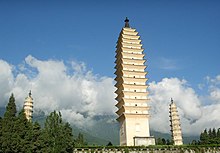
- Shaping Market ( about 30 km north of Dali ). Shaping Town offers a lively weekly market with plenty of local color. The market starts early. A great chance to see local farmers out in force and literally watch plenty of horse trading. Not much to buy (unless you are a farmer) but gives you the feeling of life in a small country town.
- 25.600251 100.230541 5 Dali Bai Nationality Autonomous Prefecture Museum ( 大理白族自治州博物馆 ), 8 Erhe South Road, Xiaguan (下关洱河南路8号) ( in the modern part of Dali, Xiaguan; take bus 8 from the old town and get off after the bridge, follow the river east (left) until just before the next bridge ), ☏ +86 872-2128614 , [email protected] . 8.30am - 5pm. Closed between 11:30 and 14:00 . Worth a visit. It has an extensive collection of exhibits, with half signs are translated into English. The museum grounds are beautiful as well, the exhibits are set around a traditional garden. Free, but requires ID to enter . ( updated Mar 2019 )

- Eryuan ( West of Dali ). Eryuan is a small town next to Cibihu lake. After taking a bus that leaves every hour for ¥13/person from the intersection with 214 National Road near the North Gate market you can get off in Eryuan town or anywhere along the way. If the bus is overloaded the bus driver's assistant will walk past police checkpoints with passengers that didn't have a seat. Cibihu lake is about 3 km downhill from the usual bus stop in Eryuan. Very few motorbikes for hire go to the lake, so if you walk in, expect to walk out.
- 25.60677 100.24502 8 Erhai Park ( 洱海公园 Ěrhǎi Gōngyuán ). The best piece of nature in downtown Dali, a city park on the lake known for its flowers. Free . ( updated May 2019 )

- ClimbDali ( 大理攀岩 ), 393 Renmin Road , ☏ +86 131 50644701 . 20 rock climbing routes have already been bolted (Shuanglang and Binchuan) with potential for hundreds more.
- Jizu Mountain ( lit. Chicken Foot Mountain ) ( further away from Dali to the northeast behind Wase on the east side of Erhai Lake, take a bus (2 hours) from Xiaguans Eastern Bus Station to Binchuan (滨川) and from there change to a minibus or bus (1 hour) ). The mountain and its ranges look like a chicken's foot. It's a 2-3 day trip in its own right. The top and slopes are covered in temples, many in a state of disrepair. Some have been restored and have resident monks. This is a difficult hike with the summit at 3200 metres. Be prepared. Or there are horse rides and a cable car that starts halfway up.
- Rice and Friends Cooking School Dali ( 米饭和朋友们 ), No.1 Hong Long Jing, Dali old town ( meeting point is the Bad Monkey Bar, 59 Renmin Road ), ☏ +86-151-2526-4065 . Rice & Friends Chinese cooking school offers hands-on Chinese cooking courses, highly rated on tripadvisor. Beautiful open-air setup with mountain views. Authentic and very personal 5-hour cooking experience, including outdoor-market shopping for ingredients, introduction to the theory of Chinese cooking, hands-on preparation of 3 dishes with a recipe booklet to take away and plenty of time for everybody to sit down together and enjoy the meal they cooked themselves.
- Johnny 'O palm reading , @Tibetan Cafe, ( Remin Lu, across from Bad Monkey Bar ). every day at 16:00 . The guy, that looks like a retired Super Mario with dark sunglasses, reads your palm and gives your an interesting perspective of what happened to you in the past. Won't tell you the future until you explicitly beg for it. Worth the ¥100 he's asking for. ¥100 .
- Erhai Paradise ( By Erhai Lake ). Certainly worth a visit. It is a magical Buddhist haven with giant statues, empty amphitheaters, demon-statues, tea gardens and an artificial beach. One way is to hire a taxi driver form Dali or Xiaguan for the entire day and negotiate a price. The driver can take you to the boat jetty and show you onto the island ferry. You will sail across the lake. Explore the island and come back by boat, where your driver will be waiting to take you to a restaurant for dinner, or temples and bars as you wish. However this is really unnecessary as there is never a shortage of taxi drivers waiting at the ferry and the local bus service is extremely inexpensive and accessible. Buses are lined up and ready to take you back to Dali at an intersection 5 minutes walk down the road leading to the ferry. Total for the day about ¥500 .
- Xiaguan Hot Springs ( 下关温泉 ) ( from the train station take bus 21 (Bus 8 runs from the Old Town to the train station) ). This swimming pool is called a hot springs resort because it probably really uses naturally hot water. Other than that it might be a little different from what most people might expect. These days it is a regular, pretty run down swimming pool (one pool on the inside, one on the outside, otherwise identical) with all the spa's (that are still on the price list) being closed. Interestingly there are places to stay in the resort with rooms around ¥280. ¥12 .
- Peter's Tourist Center ( 李震票务中心 ), #65 Bo Ai Street, Dali Old Town, Yunnan, China中国 云南 大理古城 博爱路65号 , ☏ +86 15125296978 , [email protected] . Fluent English speaking with experience in arranging tours around Dali, especially cultural tours like Shaxi day tour and Yi, Bai, Hui minority markets and villages. Air, bus and train ticket booking, hotel and guest house booking.
Dali has a number of famous local products. Any part of the city that gets a good number of tourists will have plenty of souvenirs, and probably hats (the sun is strong due to the altitude) and fruit. As ever, be prepared to bargain when shopping in Dali. See Yangshuo#Tourist stuff for advice on prices in Chinese tourist towns.
- Marble - Dali is famous for marble; the Chinese word for marble is Dalishi or Dali stone. Products included vases, ashtrays, carved animals and equipment for the game of Go . Some of this is just touristy trash, but much of it is exquisite. Larger items are heavy enough to be a little difficult to carry or a problem for airline luggage allowance.
- Tie-dye - The local tie-dye fashioned from dye and wax is also popular and cheap. One of the main production places is the Bai village Zhoucheng, about 40 minutes ride from Dali, which also has a nice daily small afternoon market and some nice old Bai houses.
- Embroidery - You can also purchase beautiful embroidery made by ethnic minorities, generally Miao minority from Guizhou Province, at a number of shops. The items include baby carriers, clothing or decorative patches that were attached to traditional costume.
- Teahouse - Dali has great teahouses. Relax in a teahouse regularly, buy a little tea and you will be welcome to come back at any time, with friends, usually for free. Sample new teas and as long as you buy something every so often, you will be welcomed again and again.
- Antiques - There are many antique shops very close to each other on Yù'ěr Lù (玉洱路). Start at the intersection of Yěyú Lù (叶榆路) and walk west. It can be very interesting to browse. Even if you're not a collector you may be tempted to buy something when you see how badly some of these treasures are being handled and stored.
- Rose products : roses are a big specialty here, and if you head out into the countryside you may spot rose farms. You can buy rose pastries (鲜花饼), rose juice, rose alcohol, rose jewelry, rose skincare products...you get the idea. Products made from other flowers, from peach blossom to osmanthus, can be found too.
If you are looking for light bites or other daily needs with fair price without paying the "tourist price", check out the 'Si Fang Jie' supermarket, they have three branches in Dali Old Town (Fuxing Street, Yu'er Rd, and near North Gate). Alternatively, you may check 'Da Chang Sheng' supermarket at the junction of PingDeng Rd and Yu'er Rd.
There are lots of local specialties, especially Bai cuisine (Bai people are the local ethnic group). Bai restaurants are plentiful, especially in the northern part of the old city. Try shuǐxìng yánghuā 水性杨花, an underwater plant whose name is also an idiom meaning "promiscuous"; shùhuā 树花, or "tree flower", a bitter tree fungus; or shùpí 树皮, literally "bark" but actually an even more bitter tree fungus.
Another local specialty is roses , which find their way into juice and pastries.
Try rǔshān 乳扇 the local "Fried cheese" that is a crispy snack often wound around bamboo skewers. Available at restaurants or sometime street stalls.
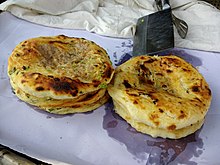
Xizhou' s famous dish is bābā 粑粑, a slightly oily, slightly chewy, slightly flaky thick pancake-like pastry, which you can get sweet or savory.
A bowl of noodle ranged between ¥10-15 (slightly more expensive than Kunming) (as of March 2019). Chinese meal served catering for four people along with beer expect to pay ¥80. Western meals average around ¥25, including a bottle of the local beer. Breakfast prix fixe menus are served everywhere and average around ¥25 including coffee.
Fruit stands and corner stores abound. Try to get a feel for prices before buying if you want to avoid paying exorbitant prices. You can buy apples for ¥4/jin (a half kilo), a bottle of water for ¥2 (as of March 2019).
- 再回首 (Zai Hui Shou) , Renmin Road ( walk east down Renmin Road just past Fuxing Road, traditional noodle stall on the left hand side ). Spicy cold noodles with chicken strips, very well known locally. There is only one thing to order.
- 色了木 (Se Le Mu) , Yu Er Road ( walk east down Yu Er Road, just past Fuxing Road, open restaurant on the right hand side ). The name literally means Salaam. Delightful eatery serving Dali Muslim food. Pictures are on the walls. Noodles only during breakfast hours while rice dishes are available for the rest of the day. Ask for chicken leg from the back kitchen.
- Golden Local-Style Noodles , Renmin Road ( near Fuxing Road, several storefronts to the left of Bad Monkey ). Noodle shop that specialized in Cross-the-Bridge Noodles, a local specialty where a bowl of hot broth is brought to the table, and then the rice noodles and a number of plates with small quantities of other foods is immediately added by the waiter. The menu is all in Chinese, but there are pictures displayed throughout, and ordering should be no problem.
- Vegetarian, Beef and Pork Dumplings , Renmin Road . Great place for fresh homemade dumplings. Nine dumplings with sauce just made and freshly steamed only cost ¥3.5.
- 25.688928 100.160961 1 Vegetarian Buffet ( 一然堂 ), Boai Road ( north of Mingcheng Art Garden Hotel, just off of Boai Road ). 11:30-13:00, 17:30-19:00 . All-you-can-eat vegetarian buffet operated by Buddhists, the choices are usually four different vegetable dishes, soup, rice, and pickled vegetables. ¥5 .

- Sun Island Cafe ( 太阳岛; Tàiyángdǎo ), 324 Renmin Road ( towards the East Gate ), ☏ +86 872 2676075 . A couple of steps away from the main tourist avenues lies this hybrid of Chinese and Japanese culture. This is the place to go for some genuine Japanese food cooked up the Chinese-, Japanese- and English-speaking owner or to relax to some chilled out music. The Japanese crew that manages the place might even throw a Jombei, Didgeridoo, Jews harp party which guests are more than welcome to join in on using any of the plentiful instruments. If the night creeps up on you after to many drinks or smokes then there is also a dormitory for ¥20 a night.
- Marley's Cafe , Huguo Road ( Central Old Dali Town cross with boai ), ☏ +86 872 2676651 . Excellent first floor restaurant. Very good Bai dishes. Nice decor. Cheap and has a narrow balcony great for people watching.
- Om Shanti , 245 Renmin Road ( East, down towards lake ), ☏ +86 872 2679306 . Vegetarian restaurant which serves great food and has a great, laid back atmosphere. The staff are very helpful too and can give you loads of helpful information.
- September , ☏ +86 872 2670266 . Sichuan food.
- Dali Cookery School , East Gate Village, Dali Old Town , [email protected] . Why not try to cook several Chinese dishes? Great time and good food. Several courses available with four dishes in each. Visit the local market to buy all the fresh veggies. Can be booked direct or through several guesthouses in Dali.
- [dead link] Ruben's Belgian Waffles ( 红龙井比利时挖福饼; bǐlìshí wāfúbǐng ), Corner of Fuxing Road and Honglong Jing (waterfall street), next to Dico's (红龙井和复兴路的十字路口,德克士旁边) , ☏ +86 13577015005 , [email protected] . Open everyday from 14:00 . This small waffle place, which is run by Belgian expat Ruben, offers delicious Belgian waffles, with several toppings available.
- The Sweet Tooth ( Sweet Tooth 甜点屋; Sweet Tooth Tiándiǎnwū ), 52 Boai Road (博爱路52号; Bó'àilù) ( on a corner in Dali Old Town ). This cafe specializes in pastries and desserts. The cafe is owned and operated by local hard-of-hearing people. Serves delicious and high quality desserts, coffee and milkshakes.
- Cafe de Jack ( 樱花园咖啡; Yīnghuāyuán Kāfēi ), 82 Boai Road (博爱路82号; Bó'àilù) , ☏ +86 872 2671572 . Dali's oldest Western cafe. Has a fireplace, great apple pie, pleasant atmosphere and a great rooftop garden. While the menu is a little tired, the breakfast is good, as well as the chocolate cake and the lasagne. Spread over three levels, Cafe de Jack is the largest and most successful of the backpacker cafe/bars in Dali. Very popular with locals and travellers alike. The owners, local brothers Jack and Tim, are often on hand to provide good travel advice.
- Bakery 88 ( 88号西点店; 88hào Xīdiǎndiàn ), 88 Boai Road (博爱路88号; Bó'àilù) ( next to Cafe de Jack ). This German-style bakery is easy to spot and has a great cake selection visible from the street. Run by a long term German resident, Karine, and is popular with both foreigners and locals.
- 25.693305 100.159709 2 [dead link] Black Dragon Cafe ( 墨龙咖啡馆 mòlóng kāfēiguǎn ), No.42 Centre Square, Foreigner Street 人街中心广场42号 ( in the alley two doors down from Bakery 88 ), ☏ +86 13330556685 , +86 872-2670535 . 09:00 to late . The best coffee, and generous, mouth-watering meals - the wraps (chicken, beef, smoked tofu) are a speciality. A good selection of books to borrow or buy.
- Jim's Peace Cafe ( 大理吉姆和平饭店; Dàlǐ Jímǔhépíng Fàndiàn ), Boai Road ( With Jim's Guesthouse ). Excellent Tibetan goulash, vegetarian or with yak meat. All-you-can-eat banquet for groups of four or more, ¥30 a head. Various other dishes. One of the town's oldest traveller hangouts.
- Old Dali Four Seasons Inn ( 四季客栈; Sìjì Kèzhàn ), 55 Boai Road (博爱路55号; Bó'àilù) ( near East Gate ), ☏ +86 872 2670382 . Great place to meet people and pick up travel tips; the Inn is a major backpacker hangout and people discusses their next expedition over breakfast. Has relocated and no longer provide all-you-can-eat breakfast.
- La Stella's Pizzeria ( 新星比萨房; Xīnxīng Bǐsàfáng ), 21 Huguo Road, Dali Old Town (护国路21号, Hùguólù) , ☏ +86 872 2679251 . A well-run operation making generous portions of delicious woodfired pizzas, pastas, salads and Chinese dishes at good-value prices. They also have a wide selection of alcoholic beverages. The staff speak English, and there is a travel agent out the back of the three-storey restaurant. Worth a visit.
- LP café ( 咖啡 ), A18 Hong Longjing Road (红龙井A18号) . It's the sort of place every neighbourhood would be lucky to have. The staff are friendly, the food thoughtfully composed and prepared. Serves deli style sandwiches and snacks made with high quality ingredients. Has a good selection of imported wine and liquors.
- Kaiyi's Kitchen (一线天), Foreign Street (洋人街). They have a nice mix of western and Chinese food available. The environment inside is relaxing and one can watch travelers walking down the Foreign Street of Dali from inside.
Dali Wall Hump Garden (驼峰厨房-点苍虹鳟). 53 Hong Long Jing. At the top of Hong Long Jing (waterfall street), right before the Hong Long Jing gate on the right. This newly opened restaurant specializing in Rainbow trout is set in a beautiful garden built over the remains of the original Dali wall. Dali's rainbow trout is considered the best in China, and spring water carried down from the mountains is used for every step of the cooking process.
A 500 ml bottle of Dali Beer will cost you around ¥10-12 in a bar and about ¥4-5 from a grocer. A large selection of beer is on offer but some are coloured green and require an acquired taste. But for the price, there is no excuse not to sample the lot.
- Bad Monkey ( 坏猴子; Huàihóuzi ), 59 Renmin Road, Dali Old Town (人民路59号; Rénmínlù) . From 09:00 . Dali's longest running foreign bar. It is hosted by two well-travelled Englishmen Carl and Scott who entertain guests before the dancing starts later in the evening with a Derek and Clive patter of jokes and one-liners. The Monkey is a magnet to foreign and Chinese travelers (many of whom seem to wander in and never leave), and remains popular with Dali locals. The bar has a pool table, dancing pole, a huge selection of local and imported beers and spirits (and their own pints of various Bad Monkey Beers on tap, made locally at the bar's microbrewery, and regular performances by bands and DJs. Bad Monkey also opens from 09:00 in the morning as a cafe, providing Western breakfasts; Thai, Indian, Chinese and Western cuisine are also available throughout the day.
- Daliba ( 大理吧; Dàlǐbā ), 260 Renmin Road, Dali Old Town . The first flavoured vodka bar in China, owned by Vanessa from Guizhou province. More than 30 flavoured vodkas made by Vanessa and Kiki, beer and cocktails are available too!
- Sun Island Cafe ( 太阳岛 ). A relaxed place owned by A Chun, a friendly woman from Lin Cang. Well worth a visit for a few drinks, well worth a stay in the rooms they have for visitors in the courtyard.
- ClimbDali ( 大理攀岩 ), 393 RenMin Lu . Boulder bar offers free bouldering, cheap beer, and information on rock climbing around Dali. Also has an organic garden and pool table.
- 非常麻辣烫 ( Fēicháng má là tàng ), Xiaguan, Renminjie (下关,人民街) ( it may be hard to find since this is deep territory, but well worth a trip into Xiaguan, so bring a Chinese friend if you can't speak any Chinese, though if not, then if coming from Old Town in the north, ask a taxi driver to take you to the intersection of Tiānbǎo lù(天宝路 and Rénmín nán jiē(人民南街, from there it's a short walk south and on the right hand side, although signs use its Chinese name ). This restaurant/bar makes an evening trip to the south of the lake worth it. They offer extremely kitschy Revolution-era Chinese military and cultural memorabilia decor, as well as one of the most friendly and talkative owners in the area, but the main attraction is the food and booze. Try their various homemade flavoured liquors made from local fruit: the Plum Baijiu is a favourite (梅子酒). The food is unpretentious and delicious local comfort food: recommended are the stir-fried erkuai with peanuts and chives (炒饵块), and dumplings tossed in chili sauce. Vegetarian options are limited, though its still worth the trip as a strictly drinking place for those coming from the Old Town. This place may be closed and demolished.
- Neverland Cafe . On Bo Ai Lu has homemade wine and fruit wines, and needs your help in advising how to blend good wines. Great baked potatoes with tuna fish topping. Owner speaks English and listens to Billie Holiday.
Dali has some of the cheapest accommodation options available in all China. Lots of accommodation to chose from. Expect to pay ¥15-30 for a dorm bed, ¥40 and above for rooms, ¥60-300 for a double room with private shower and toilet.
- Bird Nest ( 鸟窝 ), 22 Renmin Road ( Tucked into a courtyard Bai house at the top of Renmin Road ), ☏ +86 872 2661843 . Very comfortable range of rooms from dorm beds, single, double and suite rooms to a private, 3-bedroom courtyard house with kitchen. Free Wi-Fi, 24-hour hot water, chill bar, good pizza and great Greek-style yogurt. ¥30-500 .
- 25.704444 100.163333 1 Dali Letu International Youth Hostel ( 大理乐途国际青年旅舍 ), 叶榆路 Yeyu Road, Old City . A nice, clean hostel with free WiFi at the edge of the old city, less than a 5-minute walk from the 8 bus stop but more like 15 minutes from the main part of the old city. Most guests are Chinese but foreigners are welcome (check-in staff speak English). Bunks and private rooms available. Bunks from ¥20 . ( updated May 2019 )
- Dali Mingtong Yinxian Youth Hostel , Caicun Dock, Dali Old Town , ☏ +86 872 2691261 , +86 13888635082 . On the banks of Erhai Lake; there is an enjoyable view of the whole lake from the terrace on the third floor. Located in a Bai village, it is very quiet at night. Dorms ¥25, en suite doubles from ¥80 .
- Dali Three Pagodas Youth Hostel (Hostelling International) ( north-west of the old town, just west of the main road, a 5-minute walk away ), ☏ +86 872 2666398 , +86 13529651981 , [email protected] . This hostel has friendly staff and is clean and pleasant. Courtyard and gardens. There is a large comfortable lounge with two PCs and free internet access, self-catering kitchen, roof terrace with great views and a travel service. The hostel is empty off-season.
- [dead link] Dragonfly Hostel ( 清亭国际青年旅 ), 200 Pingdeng Rd ( from train station or long distance bus station take the bus #8 to its terminal station then head south along Yeyu road for 500 m then at Pingdeng road turn left and walk for 100 m ), ☏ +86 1800 872 4682 . Owned by an experienced hostel staff from Chengdu's mix hostel and her Dutch-American husband. The hostel is inside the ancient city of Dali but far from the noise of the touristic spots. It was opened in 2014. Dorm beds have privacy curtains and extra wide IKEA beds. Cheap beers and large roof top area to smoke and eat BBQ. Suitable for long term stay. ¥25-165 .
- Five Elements ( 五行客栈, wu xing ke zhan ), Dali oldtown West Gate Dazhifang 69 or the west side of 214 Highway, opposite of Hong Long Jing gate, walk north for 50 m, or 500 m south of the West Gate, on your right side ( Directions ), ☏ +86-130-9985-0360 , [email protected] . Facilities include: Staff are fluent in English and Japanese, comfortable rooms, organic food, freshly ground coffee each morning, clean spring water, convenient location (2-min walk to the town), and a beautiful garden area. There are two cute golden retriever dogs. Drinks are also available. Dorm bed: Starting at ¥15; a room with queen size bed: Starting at ¥90 .
- Mama Naxi Guesthouse Dali ( Joker's Guesthouse ), 88 Fu An Alley. Ren Min Lu ( walk to the East Gate on the Ren Ming Lu; go right after the No.5 guesthouse (should be on your right); you should also see Wang Jia Zhuang Hotel written on the wall at the end of the street; go there and then turn left; walk until you reach the end and turn right ), ☏ +86 872 267 1168 , +86 015198320421 . This is the Mama Naxi in Dali offering the same services as the one in Lijiang. Clean comfy dorms, double and triple rooms. Quiet, convenient location with friendly, knowledgeable English-speaking staff. Free internet and Wi-Fi. Bike rental. Bus, train and airplane bookings. Discount tickets for local sights. Breakfast and family dinner. There is a nice courtyard to sit and meet other people. ¥20- .
- Higherland Inn , Zhonghe Temple, Cangshan Mountains , ☏ +86 872 2661599 , +86 13988539680 . Up in the Cang Mountains behind the Zhonghe Temple at 2600 m altitude, with a spectacular view of the lake and valley. Blissfully peaceful. A short cable car ride away from town. Great food, highly recommended for vegetarians. Booking advised.
- The Jade Emu and The Jade Roo International Guesthouses ( outside the west wall, 5 minutes walk to the centre of town ), ☏ +86 872 2677311 , +86 13887232726 , +86 15887399551 , [email protected] . The Jade Emu International Guesthouse was built in 2008 and the Jade Roo opened in 2010. The Jade Emu Guesthouse won the Hostelbookers Award for Excellence, 2010 - Top 3 Hostels/Guesthouses in Asia. They are run by Dave (from Australia) and his partner Song (from China). Double, twin/triple share, singles, family suites and dorm rooms available, all are modern, clean and comfortable. Facilities include spacious courtyard and rooftop balcony, Facebook access, pool table, table tennis table, Fussball table, bar/cafe with outdoor home theatre system, free internet (6 PCs including Wi-Fi throughout the buildings), satellite TV, printing/scanning facilities, laundry service and/or free access to a washing machine, electric bike rental, discounted tours. Guests staying for 4 weeks or more are given a 40% discount. Dorms from ¥20-40, private rooms from ¥55-150 .
- Lee's Guesthouse , Dali Old Town , ☏ +86 872 2671385 , +86 872 3156069 , [email protected] . Set up in 2008 and run by Lee's family from Inner Mongolia. It provides quality accommodation for backpackers. Cozy, clean and comfortable. Facilities include local Bai minority courtyard, mosquito-free accommodation, free internet & Wi-Fi, free movie, family dinner 19:00 (book one day ahead), fax/printing/scan, CD/DVD burning, laundry service, bike rental (shimano system), ¥1/min international call and travel agency. English spoken. Dorm rooms and double rooms ¥25-290 .
- Rainbow‘s Nest International Guesthouse , 104 Guangwu Rd, Dali Old Town ( two minutes from the center of Dali Old Town ), ☏ +86 15808726740 , +86 15125250972 , [email protected] . Bai style house with six separate apartments each one equipped with living rooms, kitchens and private bathroom. Open sunny courtyard garden. Rooftop entertainment area and chill out room with free movies. Free laundry service, bike rental, comfortable and relaxed atmosphere. Free high speed internet and Wi-Fi. Traveler information and bookings. Staff are fluent in English and Chinese. Discount rates for weekly and monthly stay. Private rooms with living room and kitchen ¥130-150 .
- Smile Cafe , Renmin Road, Dali Old Town ( 5 minutes further downhill from the tourist concentration ), ☏ +86 872 2670565 , [email protected] . 11:00-01:00 . The young English-speaking couple that run Smile Cafe have befriended many a visitors with their laid back attitudes, approachability, and helpfulness. Cheap accommodation with nice rooms, laundry, free internet, hot water, courtyard with sun and table tennis, TV and DVD player. Dorms ¥25-30 .
- TTF Cafe Hostel , 11 Luyu Road, Dali Old Town (大理古城绿玉路11号) ( One minute walk on Luyu Road (绿玉路) from south end of Boai Road (博爱路) where intersects with Yita Road (一塔路) ), ☏ +86 13988536165 , [email protected] . This may be the best bargain in the area. Free green tea, internet machine, Wi-Fi, 24-hr solar-hybrid hot shower, western-style toilet. Dorms and private rooms available. Dorms ¥15 (¥10 for members) .
- Dali Private House , Dali Jiulong Ju A3-4 ( opposite Gurong Hotel ), ☏ +86 15894533443 . Check-in: 14:00 , check-out: 14:00 . Private house to rent with all appliances provided. Discount for socially active tenants (baking cakes, helping in BBQ, painting, etc.) possible. 180 .
- Jim's Tibetan Guest House , Bo Ai Lu 63 Dali Old Town , ☏ +86 872 2671822 , [email protected] . Very comfortable, clean and well appointed single and double rooms. Relaxed service. Downstairs is the cosy and good cafe & restaurant, Jim's Peace Cafe. They own another more upmarket place called Jim's Tibetan Hotel (see listing below). Owner Jim (a local) is a fluent English speaker and was the first local to start business with foreigners. With his Dutch wife he organizes great daytrips: trekkings, overland to Tibet, etc., can be found on their website. Bookings accepted by e-mail. Singles/doubles from ¥150 .
- Koreana Guesthouse . This Korean-themed guesthouse is on the Foreign Street very close to the Chinese Construction Bank ATM. The staff is pleasant and well-trained and the manager speaks good English. They have Western toilets. They also provide a quick and free laundry service. Avoid rooms facing the street as they can be quite noisy in the evenings and mornings. ¥150-300 .
- New No. 5 Guest House ( down Renmin Road near East Gate ). A nice, quiet spot on the East end of Old Town. Its rooftop deck claimsa very nice view of the area. English is spoken here, but the guests are typically Chinese. Affordable and clean.
- No. 3 Guesthouse , Huguo Road , ☏ +86 872 2664941 . Nice, inexpensive, quiet option just outside the gates of the old town. The helpful staff speak Korean, Chinese and English and will accommodate most reasonable requests. Rooms on the second floor are pricier than those on the first. Restaurant on the first floor specializes in Korean fare but offers other dishes as well. Rooms are relatively clean. You should be able to bargain a double down to ¥70-80, including private bathroom .
- Tibetan Lodge , 58 Renmin Road, Dali Old Town , ☏ +86 872 2664177 , +86 872 2678917 . A guest house and restaurant with a lot of character and atmosphere. Cheap but with mediocre service. Sometimes no air-con. Room types available include singles, doubles, triples, family, and suites. Slow but free internet is provided (wireless or on very slow desktops in the lounge). The restaurant downstairs is good, but a little on the expensive side. Single rooms start at ¥39 .
- Yu Yuan Guesthouse ( A block West of the main tourist area ), ☏ +86 872 2673267 . Clean, with friendly English-speaking staff. Doubles with bathtub and electric blankets. The breakfast is good. Doubles ¥80 including breakfast .
- Jim's Tibetan Hotel , Yuxiu lu 13 yu yuan 4 ( just outside the small South Gate in Dali Old Town ), ☏ +86 872 2677824 , +86 872 2440014 , [email protected] . Beautiful spacious rooms with colourful handmade furniture. Singles, doubles, 3- and 4-bed rooms and family rooms. Great garden, rooftop bar and terrace. Playground for kids. From ¥280 including breakfast. Same owner as Jim's Guesthouse (see above). Bookings accepted by e-mail.
- Dali Garden Bed & Breakfast ( 10 km north of Dali in a Bai minority farmers village; 2 km north of the B&B is the ancient town of Xizhuo with its Bai morning market and traditional Bai courtyard houses ), ☏ +86 138 872 317 54 , [email protected] . Dali Garden Bed & Breakfast is not a hotel or guesthouse. In the B&B you are the (local Bai/Dutch) owners' special guest and you can use also private parts of the house, such as the comfortable living room with TV. As you are their guests, service and hospitality have a high priority. The B&B is built in Bai architecture with European influence. The nice decorated guestrooms (doubles on first floor and twins on second floor) have modern Western facilities and an attached spacious bathroom with shower. One double on the third floor has a big terrace and a fantastic view over the village, lake and mountains. The price includes free pickup (with minimum stay of 2 nights) from Dali airport/express bus station, a welcome drink and snack, extensive Western breakfast, Yunnan coffee, tea, free use of bicycles, free Wi-Fi, all the mineral water, soft drinks and Dali beer you need during your stay and travel information.
- Landscape Hotel ( 大理古城兰林阁酒店; Dàlǐgǔchéng Lánlíngé Jiǔdiàn ), Yu'er Road, Dali Old Town (大理古城玉洱路96号; Dàlǐgǔchéng Yùěrlù) ( at the foot of Cang Mountain close to Erhai Lake ), ☏ +86 872 2666188 , fax : +86 872 2666189 , [email protected] . Spacious rooms with internet access against surcharge. Business center, currency exchange, gift shop, ticket office, massage and sauna available. Chinese restaurant, coffee shop and room service. Listed rates for doubles from ¥460, discounted from ¥250, including breakfast .
- The Linden Centre , 5 Cheng Bei Xizhou ( 19 km north of Dali in timeless village of Xizhou ), ☏ +86 872 2452988 . In one of Southwest China's most pristine examples of traditional Bai architecture. Developed and managed by an American couple who has been involved in China since 1984, offers 14 upscale double rooms in the completely restored, nationally-protected villa. The centre also has a small museum, two restaurants, a cafe/bar, library, conference rooms, exercise room, and four elegant courtyards full of gardens and outdoor seating.
- 25.70184 100.17098 2 [dead link] Regent Hotel ( 大理风花雪月大酒店; Dàlǐ Fēnghuāxuěyuè Dàjiǔdiàn ), Yu'er Road, Dali Old Town (大理古城玉洱路; Dàlǐgǔchéng Yùěrlù) ( on Cang Mountain facing Erhai Lake ), ☏ +86 872 2666666 , fax : +86 872 2682082 , [email protected] . Five-star hotel in Bai architecture style. Very large rooms with free internet. Business center, currency exchange, gift shop, beauty salon, ticket office, karaoke, night club, billiards, table tennis, fitness, tennis, massage and outdoor swimming pool available. Chinese and Western restaurants as well as coffee shop and bar. The hotel comes with everything you can expect from a Chinese five star hotel, but lacks something in taste, service and Western breakfast compared to what you will find in larger cities. Listed rates for doubles ¥880-5,800 including breakfast .
- Linden Centre : in Xizhou, 20 km north of Dali. Lovely Bai architecture; very nice hosts and lovely surroundings. Very tasteful. ¥700 (incl breakfast).
The old town has free WiFi. Use the network "DaliTravel".
There are a few scams and petty crime targeting tourists in Dali. Watch your belongings carefully to protect from pickpockets and theft, though perhaps the major risk you take if staying in cheap accommodation is theft by other foreign travellers. Overall Dali is a very safe place with little crime directed at tourists.
If you are planning to hike up the Cang mountains, travel in a group both to protect yourself from robbery and as back up in case of accident. Stay on the paths and don't take any risks climbing no matter how experienced you are, as fatal accidents do happen!
Drugs disguised as strange artifacts are usually sold by women in traditional Bai costume, who will then lead you to their homes. Marijuana is still widespread, of course, but it is no longer tolerated in public. It is not uncommon to see marijuana growing in the wild. Women may also offer you "opium", but it is just worthless garbage, possibly sesame oil pressed with some unknown substance. It is no longer easy to purchase marijuana in Dali.
Don't get your shoes fixed by men approaching you on the corner of Fu Xing Rd and Foreigner St. Even if a price is agreed, they will add a couple of extra stitches and charge ridiculously inflated prices (¥200-300). You're in a difficult position to argue because they have your shoes! Just go to a regular established shoe shop (there are several towards the east end of Renmin Rd) where you can get your shoes repaired well for less than ¥10.
Most of the hostels and travel agents can organise bus tickets anywhere in Yunnan . They can also arrange flights farther afield.
Many travelers from Kunming continue on from Dali to Lijiang (either by bus or by train). Consider taking a bus to the Old Southern Silk Road town of Shaxi , which is about half way between Dali and Lijiang. The town has been well preserved and still holds much of its traditional character. The valley around it is littered with Qing and Ming Dynasty homes, bridges, theatres and temples. It is also the main jumping off point to visit the beautiful grottos at Shibaoshan. After your visit to Shaxi it is easy to continue your journey. Direct buses are now available from Shaxi to Lijiang.
There are also bus services to Shangrila . Most of these buses depart from the Dali North Bus Terminal, though a few a buses depart from the Dali Old Town Bus Terminal.
If you prefer to take the train to Shangri-la, you will need to change trains in Lijiang.
- Has custom banner
- Has map markers
- Airport listing
- Articles with dead external links
- Has mapframe
- See listing with no coordinates
- Do listing with no coordinates
- Eat listing with no coordinates
- Drink listing with no coordinates
- Sleep listing with no coordinates
- Usable cities
- Usable articles
- City articles
- Central Yunnan
- All destination articles
- Has Geo parameter
- Pages with maps
Navigation menu
Must-see attractions in Dali
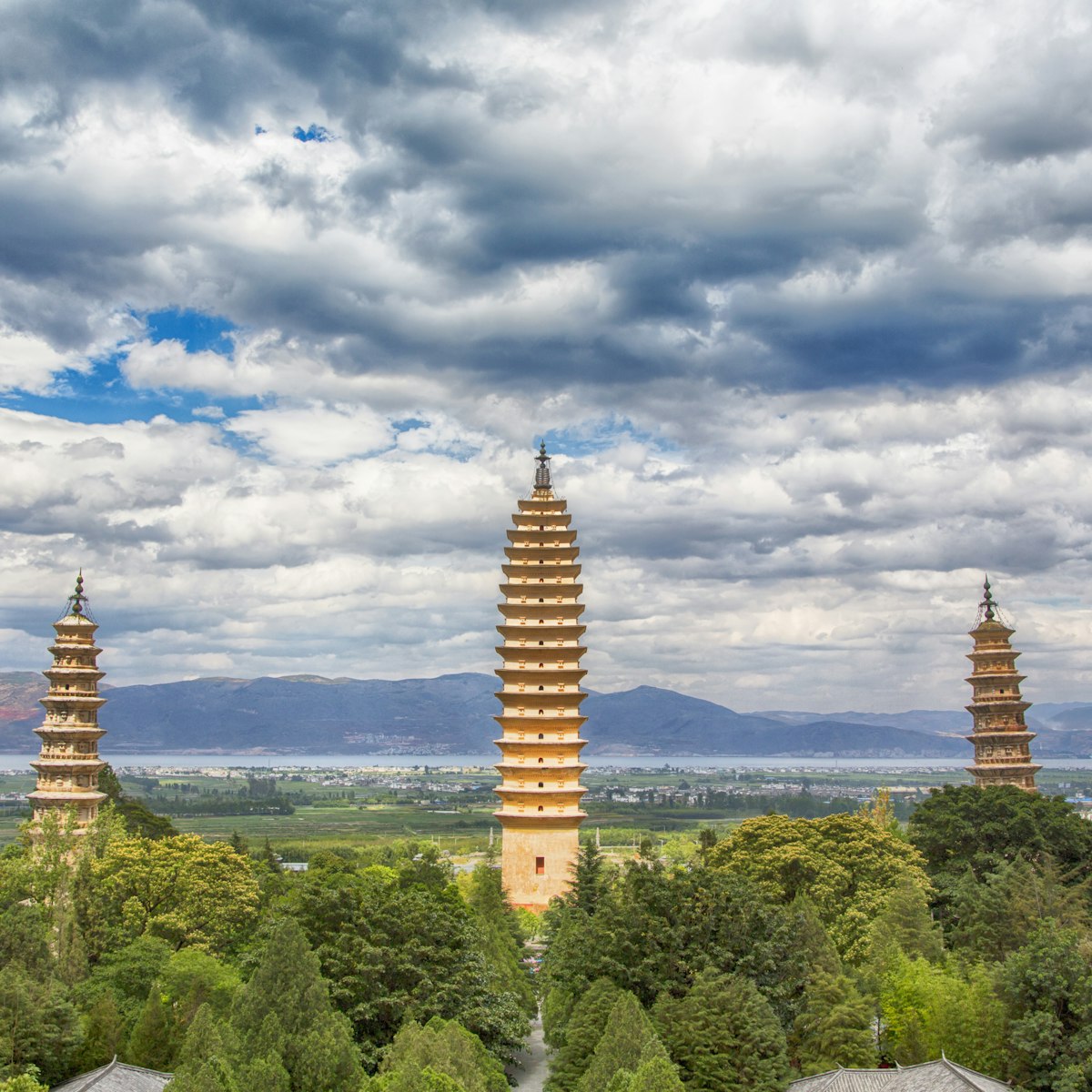
Three Pagodas
Absolutely the symbol of the town and region, these pagodas, a 2km walk north of the north gate, are among the oldest standing structures in southwestern…

Dali Catholic Church
It's worth checking out Dali’s Catholic Church. Dating back to 1927, it's a beautiful blend of Bai-style architecture and classic Christian theology and…
Dali Confucian Temple
Dali's attractive Confucian Temple is a 2014 reconstruction on the site of the original Qing dynasty structure, but the grounds are peaceful and there are…
Dali Municipal Museum
The museum houses a small collection of archaeological pieces relating to Bai history, including some fine figurines. English descriptions are lacking,…
Plan Your Trip to Dali: Best of Dali Tourism

Dali, China
Essential dali.

Dali Is Great For
Cultural tours.

Historical Tours

Hiking Tours

Nature and Wildlife Tours

- The Linden Centre
- Hilton Dali Resort & SPA
- Hotel Indigo Dali Erhai, an IHG hotel
- Dali Old Courtyard Boutique Inn
- Sky Valley Heritage Boutique Hotel
- The Bakery No.88
- The Backyard
- Blue Gecko Cafe
- Fly Me To The Moon
- The Market Neighbourhood cafe
- Yunnan Shaxi Ancient Town
- Cangshan Mountain
- Dali Ancient
- Xizhou Town
- Eat Your Way Through Yunnan's Tea & Horse Road, from Dali to Lijiang, 8-day Trip
- 9 days Ancient Town Tour
- Private tour to Xizhou old town local market Erhai lake three Pagodas from Dali
- Dali Yunnan Local Market + Pottery Making Eco Tour
- 1-Day Dali tour with the Daili old town, Xizhou Village and Three Pagodas
Traveling to Dali: The Complete Guide
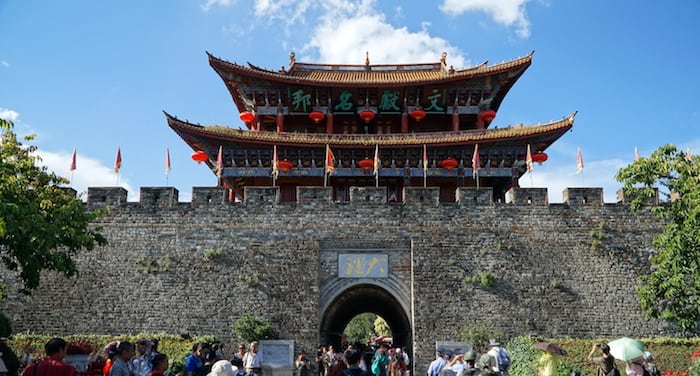
Located in the heart of Yunnan, Dali (大理) is a picturesque town mainly inhabited by the ethnic Bai, who settled here millenniums ago. Or better, this is the Dali Old Town, the original heart, surrounded by a city wall and characterized by typical Bai homes and architecture.
Dali New Town, which China flaunts today, is a long settlement along the shores of Lake Erhai and has almost swallowed up the small classic center on the western shore. The hotels are all close to one another, the cars battle along the road that runs along the lake going from the airport to the old center, passing by new cement monsters that are increasingly huge and in bad taste, but represent progress.
This is an area that has seen a prosperous kingdom, the Kingdom of Nanzhao, submissive to the Mongols, when the Bai Buddhists invaded and then annexed them to the Heavenly Empire; for a long time Yunnan was nothing more than a stop on the Ancient Tea Road (or the Southern Silk Road) .
Today tourism is an important source of its renewal, with all the pros and cons that comes with such speculation: local artisans struggle to resist serial production, homes give in to the temptation to convert into shops, the use of local costumes has become more for the tourists than tradition, at least for new generations.
Actually it’s not just in Dali, but the entire northwestern part of Yunnan, where ethnic minorities battle daily with imminent type-approval. It’s here, you can say, that the situation isn’t yet so compromised as, for example, Lijiang, where the locals have almost completely abandoned the old inhabited center .
This is to clarify my position as a tourist, which varies diametrically between fascination and disgust; and to make clear that in these areas it’s best to go as soon as possible since, when it comes to authenticity, there’s a relentless march that pushes Yunnan to lose something precious every day . The only alternative is to personally promote culturally responsible tourism.
When to go to Dali
Dali, though located at an altitude of 1,900 meters, still doesn’t record the freezing cold of the most northern parts of Yunnan. The climate is generally mild and very sunny. It’s a pleasure to visit the city during the shoulder seasons, as much as it is as a summer destination considering that the thermometer hardly reaches 30°.
Rather, the same recommendations for Kunming apply : the sun beats down because of the altitude, so it’s good to “apply cream” as needed during the day and keep in mind the temperature change between the early morning and night.
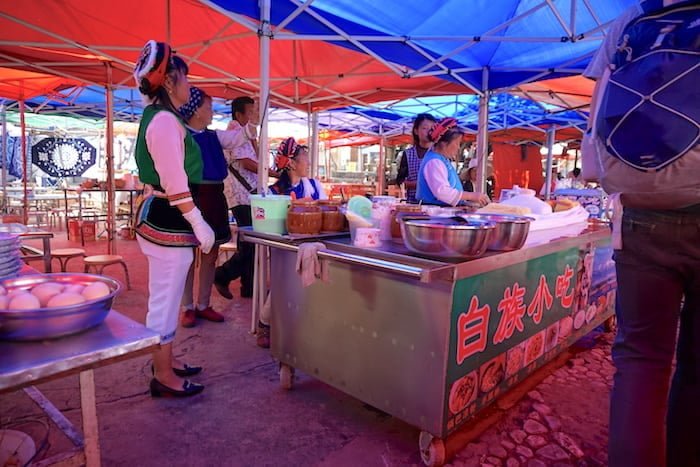
How to get to and how to get around Dali
Usually Dali is one of the stops that you make on itineraries going to Lijiang or Shanghri-la: so being on the way toward the north, it often ends up being a base of operations for quick excursions to ethnic minority villages or the Cangshan Mountains. Then, a race toward Lijiang and beyond.
As a result, in the old city, the small historic center is still preserved, you only need a half day to gallop between shops. But the finesse of what remains of the Bai rhythm and their buildings are best discovered by stopping a little longer and dodging the crowds.
Dali airport 大理机场) is not served by international flights. It has a small terminal where only domestic flights come and go. So from other countries you’ll be forced to consider a stop at one of the bigger cities like Beijing, Shanghai, Nanjing or the closer Chengdu and Chongqing . In particular, there are tons of daily connections with Kunming, which saves several hours of travel by road or train, since the flight lasts less than an hour.
The downside of the airport is that it is on the exact opposite side of the lake and the old city. To get there, it takes at least an hour by car in normal traffic conditions. There’s a shuttle bus that goes as far as Xiaguan Station (a.k.a. Dali New Town) , where you’ll have to change with Line 8 to get to the old city. By public transportation the whole price is about 20 Yuan. A taxi directly from the airport to the old city costs about 80 Yuan, and it doesn’t make any stops ;-)
Dali can also be reached by long distance buses from Kunming, Lijiang and Shanghri-la. Some services travel by night, especially for the route to and from the capital. The inconvenience is that the bus station isn’t close to the historic center, but in Xiaguan, a good 14 km to the south. There are various connections, but the real problem is that there’s practically only one road, so traffic builds up easily.
The rail option is limited to express trains; there are no high speed trains between the cities, which stops instead at Kunming. Between Kunming and Dali it still takes 6 to 8 hours of travel, while to Lijiang it’s a more bearable 2 hours.
When it comes to getting around the city: the center is so small that you won’t need anything more than your legs . Rather, other points of interest can respectively be reached:
- with bus C2 if you go from Dali Old Town to the boat dock for Lake Erhai (but it can also be reached on foot in an hour’s walk)
- with bus C2, C7 or the direct line if you want to go to the Three Pagodas (even closer than the lake on a pleasant stroll)
- with tourist bus number 1 (古城自助游览车1号线) if you want to get to the entrance of Mount Cang park.
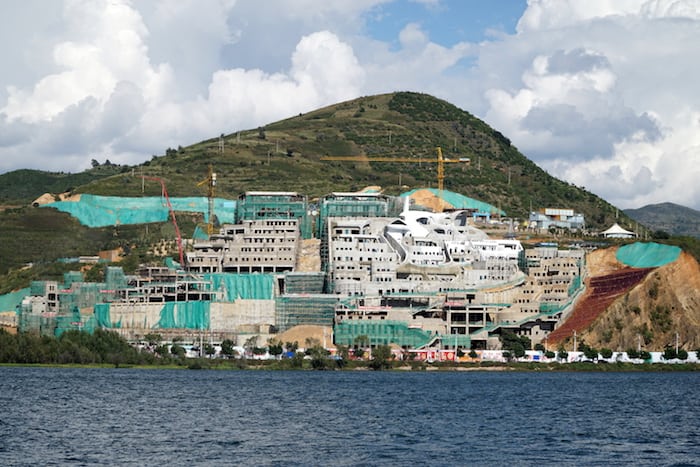
Where to stay in Dali
Since Dali New Town was developed to the south of Old Town and all around the lake, much of the lodging is located outside the old city, and many have affordable prices. They are mostly modern buildings in a good location, that is, facing Lake Erhai or towards the mountains. But it’s still not the same as staying in old Dali.
In fact, many of the hotels in Dali Old Town are inside of historic Bai buildings, with inner courtyards and finely renovated rooms and uniquely decorated doors. Personally, I stayed at the Fairyland Hotel Dali Zhong He Ju and it was a picturesque experience immersed in the general vibe of the city.
This is why, if your budget allows, try to avoid the easy solutions of Xiaguan and spend a little more time looking for the ideal place inside the historic city center (even one of the renovated Bai homes!).
Considering the size of the city, one corner is as good as another. The city itself is small and for getting around longer distances, taxis and public transportation are available.
Click here to read our reviews on the best hotels in Dali .
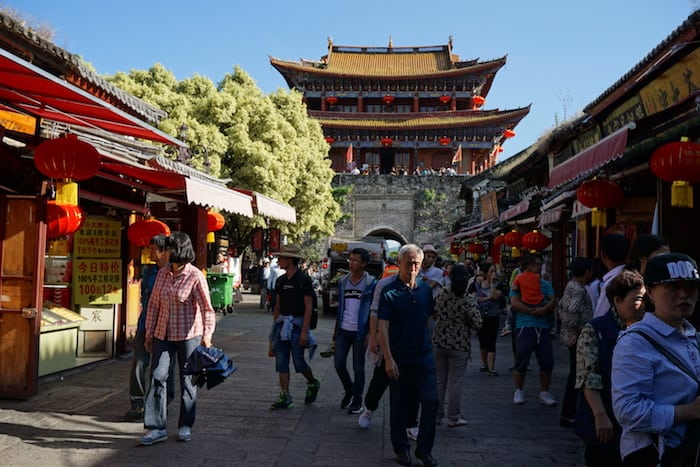
What to see in Dali
Dali Old Town (大理古城), or the historic center: surrounded by walls and marked by four imposing entrance gates on the four cardinal points, the city is squared off by roads filled by streets that today are populated by little holes in the wall and souvenir shops. To appreciate the magic, it’s good to walk through before the shops open, when the vendors tediously stretch as they dismantle the doors and pieces from closing the night before. At night it transforms into chaotic disco where the PR try to lure tourists inside, while the shop next door noisily works with silver to the sound of hammer blows.
The main roads are Huguo Lu (护国路), Renmin Lu (人民路) and Hong Long Jin Lu (红龙津路). Avoiding the touristy zone, toward the east, you can still see some of the Bai authenticity. And also, sadly, architectural decadence, because many of these wonderful buildings are a little neglected if not renovated for tourism.
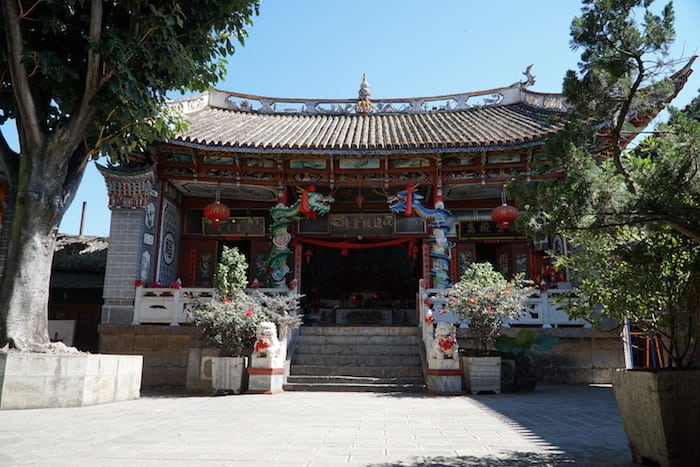
Lake Erhai (洱海湖) : literally the sea in the shape of an ear, this basin is 42 km long and 6 km wide. It’s an interesting area from a flora and fauna point of view, and offers wonderful landscapes…aside from the cement abominations built along its shores, in some cases only halfway finished. The shores of the lake were once populated by the typical activities of the Bai; here they fished with cormorants and grew rice on terraces on its banks. Now it’s easier to find fish markets and restaurants for tourists, even though these traditions still, in some way, survive.
The most popular destinations on Lake Erhai are Putuo Island (小普陀岛) and the Sky Mirror Pavilion (天镜阁) which can be reached via boat tours that start from the dock at the village of Cai Cun (才村), not far from the old city. There are other little islands here and there, marked by a pagoda or a small temple. Some boat tours allow for a day of exploring even these little hidden corners. Be careful of the wind!
Finally, the shores of the lake are surrounded by various visit-worthy villages (see the following).
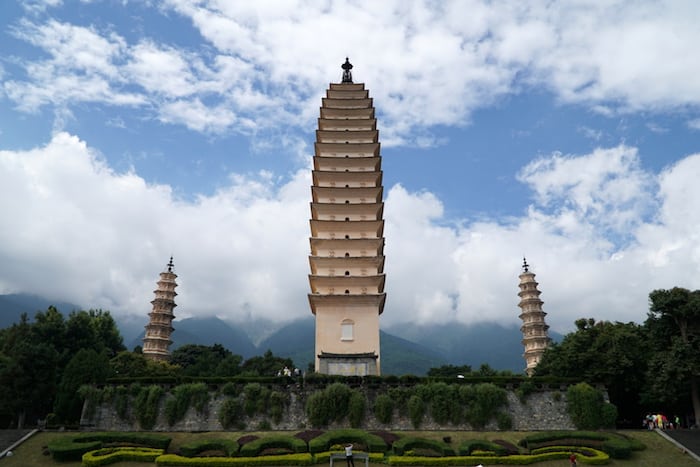
The Three Pagodas (三塔寺) : is a large complex, recently enlarged, which actually includes three ancient pagodas and a modern temple rising up behind it. Of the pagodas, the most beautiful is without a doubt the queen of 69 mt., the “lady” Qianxun, which was built during the reign of Nanzhao and is one of the highest in China. It was inspired by the Great Pagoda of the Wild Goose of Xi’An. Sadly its 16 stories are presently off-limits because it is dangerous: furthermore, Dali has experienced several earthquakes in the past, and it’s almost a miracle that the three towers are still there in their original form. When the sky is clear and the pagodas are embraced by the Cang Mountains, the impression is quite enchanting.
For this reason tourists are moved to go to the top toward the freshly painted temple. The temple is nothing special in and of itself, but in its entirety it is a pleasant view wrapped in the Cang Mountains, which on sunny days shines in vivid colors. It’s a little pricey to get in and the golf car that brings tourists up and down isn’t included in the price of the ticket.
The Cang Mountains (苍山) : the chain that surrounds the west shore of Lake Erhai and protects and watches over old Dali; the highest peak goes above and beyond 4.000 mt. The Cang Mountains can be explored on foot or by taking advantage of the three cable car lines. There’s a very easy path, full and paved, which crosses the chain east to west: to take the path, you can get to the Zhonghe Temple (中和寺) by taxi and start the 14 km. trek. Or, admire the area and panorama, and then go down by cable car.
During the ride you’ll come across another cable car line (Ximatan) which goes up to 4.000 mt., or you could also say, brings you back down the valley if you’re done at this point. Continuing on, the path ends at Gantong Temple (感通寺), which from here you can go down to the valley again by cable car or make the last effort on foot, if you haven’t had enough. Since the path winds at altitude, being able to trek it depends on the weather conditions, so it’s recommended that you trek only if the skies are clear and doesn’t look to change. A better reason is because the visibility guarantees breathtaking views of the Three Pagodas, Erhai and Dali itself.
Entrance to the Cang Mountains park costs 40 Yuan, but doesn’t include tickets for the cable cars (and each cable car requires a separate ticket). Depending on the route that interests you, it varies between a 10 to 20 km walk.
The Bai villages, Yi and Hui : around Lake Erhai, but not necessarily nearby Dali, there are numerous villages, among which are a few preserved gems. They can also be explored by boat by going alongside the lake: it is a challenging cyclo-tourism itinerary if you’re looking to complete the complete tour (128 km), and certainly requires more than one day to allow enough time for the various stops that deserve it. They often go on days of the local markets, to combine a taste of the local specialties with the visit.
Among these, on the same eastern shore of Dali, the renowned Xizhou (喜洲) : famous for its really fine homes, it is possible to attend a show of Bai dances organized for tourists here; in Zhoucheng (周城) instead, go if you’re interested in colored textiles with the batik technique or tie-dyeing, which here are specifically called zaran (扎染) ; or also Shaping (沙坪), where at the local Monday market you could be the only different face; and further on, still on the Lake’s east side, Shuanglang (双廊), a laid back fishing village.
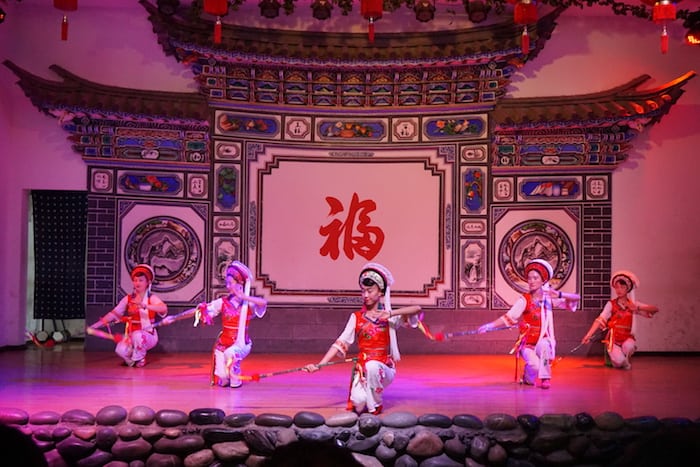
The ethnic Bai
The Bai have a long history that has its origins in these areas and is tied to the already mentioned Kingdom of Nanzhao. Yunnan is the region where they are most numerous, but are also present in Guizhou and Hunan.
They are distinguished locally because they wear finely decorated clothing with a preference for white (in fact Bai 白 in Chinese means white); single women braid their hair and wear head coverings with long cords that look like spaghetti, which they cut once they get married. The Bai are excellent dancers thanks to a long musical tradition, and are also known for the typical characteristics of their residential areas, which over time have developed into their own architectural style.
The use of marble and wood are widespread in these buildings: in fact the entire area of Dali if full of this hard stone, to the point where in Chinese, marble is translated into “Dali stone” not surprisingly, 大理石. The interior of homes include a garden and special wall, onto which according to tradition the sun’s light should be concentrated. Observing the decorations of the entrance doors, you can guess if the head of the household is the woman just by noting if the highest decorated animal is a phoenix.
As able fishermen, the Bai offer a special suanla yu (酸辣鱼) even if the majority of their dishes are prepared with pork or chicken meat (as a mid-morning snack, you can have a piece of pork rind, how great…). At the market you’ll find pickles in abundance, and obviously lots of goat cheese!
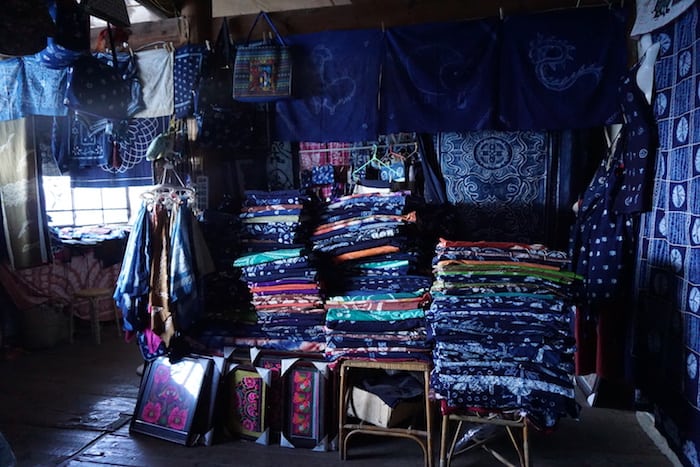
Shopping in Dali
The area is full of marble quarries and silver mines, and for this reason handicrafts are still active in the old city. Rather, you need to be careful to stay away from “trash”.
These go from massive silver trinkets that you buy by weight, such as bracelets as large as a bone or often as handcuffs. However, in the finer stores, you can also find minutely worked rings and even thermoses with embellished finishes (considering how they’re used in China, a silver flask is an imperial gift).
Next to this, locally made tie-dye textiles are exquisite . The majority use the natural blue of indigo ; the color doesn’t fade with washing if it is first prepared by soaking it in a salt bath for a few hours.
Certain works, rigorously handmade, are so painstaking as to require months: to give an example, to design different circles, they include grains of rice one by one before adding color. And then, once the textile has been treated, the same grains of rice are taken out of the material one by one. And voilà, a work of Amenuensis, which are obviously paid for such.
I can recommend “Happy Embroidery di Yu Ling Li” , a nice girl that tenaciously carries on the family tradition. Her shop (namely her house) is at Xizhou, 26, Rangyi alley (大理喜洲镇染衣巷26号), [email protected] .
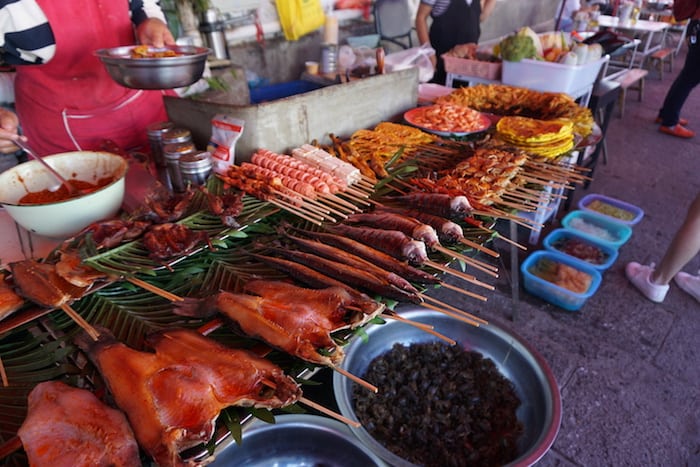
Not to miss
Personally, I find the local cuisine among the most tasty in all of China. And this is because the more you go up into the mountains of Yunnan, the more widespread are the mushrooms ! The smell of home…
But the mushrooms aren’t the only specialty. Prune alcohol has a really long history: it is prepared in fat skin bottles, with various gradations and enriched by various scents. It is sublime when used for cooking, especially when making pork and prunes .
A typical restaurant both in style and architecture is Meizijing Jiujia (梅子井酒家), which prepares the prune liquor in house and offers lots of dishes full of local products.
As a last recommendation: if you arrive in the evening and stay on the most popular roads without allowing an early morning walk in Dali or go off the beaten paths, all that will remain for your eyes and ears are crowds of people. Or worse yet the locals’ loud music.
So, don’t stop at the first impression, but earnestly search for the Dali hidden by the violence of tourism. It’s still an esquisite place.
Do you have any doubts? Leave a comment here below!
About The Author
Rita Andreetti
Related posts.

The Stone Forest and the legend of Ashima

From Lijiang to Lugu Lake: Chronicle of a Hectic Trip

Gubeikou: Hiking on the Wild Great Wall
Leave a comment cancel reply.
Your email address will not be published. Required fields are marked *
Save my name, email, and website in this browser for the next time I comment.
Privacy Overview
Get 3 Months FREE with EXPRESS VPN
+ Best VPN For China + 30-Day Money-Back Guarantee + 24/7 Live China Customer Support + 3 Months Free on 12 Months Package
Winter is here! Check out the winter wonderlands at these 5 amazing winter destinations in Montana
- Travel Destinations
Dali Is The Hippie Town Of China
Published: September 19, 2023
Modified: December 27, 2023
by Laurena Jiang
- Arts & Culture
- Plan Your Trip
- Cultural Festivals
- Eco-tourism
Introduction
Dali, often referred to as the “Hippie Town of China,” is a mesmerizing destination that captures the hearts of travelers from around the world. Nestled in the breathtaking Yunnan Province, this charming town is known for its stunning landscapes, rich cultural heritage, and vibrant artistic community.
With a history dating back over 1,300 years, Dali has been a center of trade, culture, and art since ancient times. Its strategic location on the ancient Tea Horse Road made it a melting pot of different cultures, resulting in a unique blend of traditions and customs. Today, Dali is not only a living testament to its rich historical past but also a thriving hub of creativity and spirituality.
One of the most fascinating aspects of Dali is its distinctively laid-back and bohemian atmosphere. Walking through the narrow cobblestone streets lined with traditional Bai-style houses, one can’t help but feel a sense of tranquility and freedom. The town has become a sanctuary for free-spirited travelers, artists, and nature enthusiasts seeking inspiration and a break from the bustling modern world.
From its vibrant street markets filled with colorful handicrafts to its serene lakeshores and breathtaking mountain ranges, Dali offers a myriad of experiences for visitors to indulge in. Whether you’re exploring its ancient temples and pagodas, hiking through picturesque rice terraces, or simply enjoying a cup of local tea in a quaint teahouse, Dali has a magical allure that captivates the soul.
Moreover, Dali is renowned for its mesmerizing natural beauty. The crystal-clear Erhai Lake, surrounded by lush green mountains, is a paradise for nature lovers. The imposing Cangshan Mountain range, with its snow-capped peaks, provides a stunning backdrop to the town. The Bai people, the predominant ethnic group in the region, have lived in harmony with nature for centuries and have preserved their traditions and customs, adding to the authenticity of the experience.
Join me as we dive deeper into the captivating history, cultural significance, natural beauty, local cuisine, art scene, and festivals of Dali. Discover why this charming town has earned the nickname of the “Hippie Town of China” and why it continues to be a beloved destination for those seeking a unique and enriching travel experience.
History of Dali
The history of Dali can be traced back to the days of the ancient Nanzhao Kingdom, which rose to prominence in the 8th century. This kingdom, led by the Bai ethnic group, established Dali as its capital and fostered a prosperous era for the region.
During the Tang Dynasty, Dali became an important trading hub along the legendary Tea Horse Road, connecting China with Tibet and Southeast Asia. This led to a flourishing economy and the exchange of diverse cultures and traditions. The town was a melting pot of Bai, Han Chinese, Tibetan, and other ethnic groups, which contributed to its unique cultural identity.
In the 13th century, the Mongols invaded Dali and established the Yuan Dynasty. For the next several centuries, Dali experienced periods of stability and prosperity, followed by unrest and political turmoil. It wasn’t until the Ming Dynasty that Dali regained its prominence as a center of trade and commerce.
Dali’s historical significance is evident in its architectural treasures. The ancient city walls, built during the Ming Dynasty, have withstood the test of time and stand as a reminder of the town’s fortification and importance. The Three Pagodas, an iconic landmark of Dali, were constructed in the 9th century and are a testament to the region’s rich Buddhist heritage.
During the Cultural Revolution in the mid-20th century, Dali, like many other cultural sites in China, suffered significant damage. However, in recent years, efforts have been made to restore and preserve the town’s cultural heritage, ensuring that its historical charm continues to enchant visitors.
Today, Dali’s rich history is celebrated through its museums, ancient temples, and traditional Bai-style architecture. The town is a living museum, where visitors can immerse themselves in the past and gain a deeper understanding of the region’s cultural roots. Exploring Dali is like stepping back in time, where ancient traditions blend seamlessly with modern influences.
Join me as we delve deeper into the cultural significance of Dali, learning about the Bai ethnic group and their contributions to the town’s vibrant history.
Cultural Significance of Dali
Dali is more than just a picturesque town; it is a cultural treasure trove that offers a glimpse into the rich heritage of the Bai ethnic group and the diverse cultures that have shaped the region throughout history.
The Bai people, who make up the majority of Dali’s population, have a unique culture and traditions deeply rooted in their daily lives. Known for their exquisite craftsmanship and artistic talents, the Bai people have made significant contributions to Dali’s cultural landscape.
One of the most notable aspects of Bai culture is their distinct architecture. The traditional Bai-style houses, with their intricately carved woodwork and white walls, are a sight to behold. Each house is a masterpiece, reflecting the Bai people’s attention to detail and their belief in harmonizing with nature.
The Bai people are also known for their love of music and dance. Traditional Bai music, characterized by delicate melodies and soothing rhythms, is often accompanied by the lusheng, a traditional wind instrument. The Shibaoshan Dance, a traditional Bai dance performed during festivals and celebrations, is a vibrant display of the Bai people’s joyous spirit.
Buddhism has played a significant role in shaping the cultural fabric of Dali. The town is dotted with beautiful Buddhist temples, such as the Chongsheng Temple and the Zhonghe Temple. These ancient temples not only serve as places of worship but also as cultural landmarks that showcase the artistic prowess of the Bai people. Intricate carvings, stunning murals, and serene courtyards transport visitors to a realm of tranquility and spiritual contemplation.
Another cultural highlight of Dali is the Bai people’s traditional clothing. The women wear colorful embroidered dresses, adorned with intricate patterns and symbols that reflect their beliefs and aspirations. These vibrant costumes are a visual feast and a testament to the Bai people’s appreciation for craftsmanship and beauty.
Furthermore, Dali is renowned for its vibrant festivals and celebrations. The Torch Festival, held annually, is a spectacular event that showcases Bai culture at its finest. Fireworks, dragon dances, and the lighting of giant torches create a festive atmosphere that attracts both locals and tourists.
Overall, the cultural significance of Dali lies in its ability to preserve and celebrate the traditions and art forms of the Bai people. By immersing oneself in the local customs and traditions, one can gain a deeper appreciation for this unique cultural heritage and understand why Dali is often referred to as a living museum.
Join me as we explore the natural beauty of Dali, immersing ourselves in its breathtaking landscapes and discovering the soul-soothing wonders that await.
Natural Beauty of Dali
Dali is a destination blessed with unparalleled natural beauty. From stunning lakes and majestic mountains to lush valleys and vibrant flora, the town offers an abundance of breathtaking landscapes that captivate the hearts of all who visit.
One of the most striking natural features of Dali is the picturesque Erhai Lake. Translated as “Ear-shaped Sea,” this shimmering body of water is surrounded by rolling hills and expansive plains, creating a scene straight out of a postcard. Erhai Lake is not only a visual delight but also an important ecological and cultural asset for the region. It provides a habitat for numerous animal and plant species and plays a vital role in the livelihoods of local fishermen.
For those seeking outdoor adventures, the Cangshan Mountain range is a must-visit. With its snow-capped peaks, rugged cliffs, and lush green forests, this mountain range offers breathtaking vistas at every turn. Hiking enthusiasts can embark on trails that lead to hidden waterfalls, serene temples, and panoramic viewpoints. The mountain range is also home to alpine meadows, where wildflowers bloom in a stunning array of colors during the spring and summer months.
Dali is famous for its terraced rice fields, which not only provide a scenic backdrop but also reflect the harmonious relationship between the Bai people and the land. As the seasons change, the fields transform into a patchwork of different shades of green, presenting a captivating spectacle for nature lovers and avid photographers alike.
In addition to its larger natural wonders, Dali is surrounded by smaller hidden gems that showcase the region’s biodiversity. From the lush Nanzhao Folk Island, where rare plant species thrive, to the dense forests of Shibaoshan, home to unique wildlife, these areas offer a sanctuary for nature enthusiasts and researchers.
Dali’s natural beauty is not confined to its land. The skies above are adorned with vibrant colors during the sunrise and sunset, painting a breathtaking palette of hues over the landscape. Whether it’s the misty morning fog enveloping the mountains or the warm golden glow casting its spell at dusk, the skies of Dali add to the enchanting allure of the town.
Exploring the natural beauty of Dali is not just about admiring the scenery; it’s about connecting with the earth and immersing oneself in the tranquility that surrounds. Whether you’re strolling along the lakeshore, hiking through the mountains, or simply enjoying a picnic in a meadow, the natural wonders of Dali offer a respite from the chaos of everyday life.
Join me as we delve into the local cuisine of Dali, savoring the flavors of traditional dishes and exploring the culinary delights that the town has to offer.
Local Cuisine of Dali
The local cuisine of Dali is a tantalizing blend of flavors, influenced by the region’s diverse ethnic groups and its proximity to neighboring countries. From savory dishes to delectable snacks, the gastronomic scene in Dali offers a delightful culinary journey for food enthusiasts.
One of the iconic dishes of Dali is the Bai Cuisine. Known for its light and refreshing flavors, Bai Cuisine showcases the use of fresh, local ingredients and delicate cooking techniques. Popular dishes include Xizhou Baba, a crispy pancake topped with various savory toppings, and Erkuai, a chewy rice cake often served with spicy sauces.
Another must-try dish in Dali is the Three-Course Tea. This unique culinary experience involves savoring three different courses of tea-infused dishes. Each course is meticulously prepared and paired with a specific type of tea, creating a harmonious balance of flavors and textures.
Seafood lovers will delight in the fresh catches from Erhai Lake. The lake is known for its abundant fish, shrimp, and eel, which are often prepared in a variety of dishes such as steamed fish with soy sauce, spicy shrimp stir-fry, and braised eel.
Dali is also famous for its street food scene. From the aromatic BBQ skewers to the flavorful rice noodles and crispy fried snacks, the local street vendors offer a wide array of delicious treats that are perfect for a quick bite or a late-night snack.
For those seeking a unique culinary experience, Dali is home to a vibrant vegetarian scene. The town boasts numerous vegetarian restaurants that serve innovative and delicious plant-based dishes. From tofu dishes to vegetable stir-fries and creative meat substitutes, these restaurants cater to the growing demand for vegetarian and vegan options.
No visit to Dali is complete without indulging in its rich tea culture. The region is renowned for its Pu’er tea, one of the most famous and prized teas in China. Visitors can participate in tea ceremonies, where they can learn about the different types of tea, the proper brewing methods, and the art of tea appreciation.
Exploring the local cuisine of Dali is not just a delicious journey for the taste buds; it’s also an opportunity to immerse oneself in the culture and traditions of the region. Whether you’re enjoying a traditional Bai feast, sipping on a cup of aromatic tea, or savoring the flavors of street food, the culinary delights of Dali are sure to leave a lasting impression.
Join me as we discover the vibrant art and music scene in Dali, exploring the creative expressions that have made the town a haven for artists and musicians alike.
Art and Music Scene in Dali
Dali has earned a reputation as a creative hub, attracting artists, musicians, and free spirits from all corners of the globe. The town’s laid-back atmosphere and breathtaking landscapes have inspired a vibrant art and music scene that adds to its unique charm.
One of the most notable aspects of Dali’s art scene is its combination of traditional and contemporary influences. The town is home to numerous art galleries and studios, showcasing a diverse range of artworks, from traditional Bai-style paintings to modern abstract pieces. Visitors can explore these galleries, interact with local artists, and even take part in artistic workshops to learn traditional techniques or unleash their own creativity.
Dali’s artistic spirit is not limited to the confines of galleries. The town itself is an open-air gallery, with vibrant murals adorning the walls of buildings and alleyways. These street art displays not only add color and life to the town but also serve as a platform for artists to express their ideas and engage with the community.
In addition to visual arts, Dali has a thriving music scene that draws on a diverse range of genres and influences. Live music venues can be found throughout the town, offering visitors the opportunity to enjoy performances by local musicians, as well as international artists who have made Dali their creative home.
The music scene in Dali is often reminiscent of the town’s hippie roots. It is not uncommon to come across impromptu jam sessions or open-mic nights, where musicians come together to share their talents and create a relaxed and communal atmosphere.
Beyond public performances, Dali also hosts music festivals that attract both local and international acts. These festivals showcase a wide range of genres, including folk, rock, electronic, and fusion music, providing a platform for emerging artists to showcase their talent and for music enthusiasts to immerse themselves in a world of sonic delight.
The artistic and musical spirit of Dali doesn’t stop at the professional level. The town embraces a culture of creativity and self-expression, encouraging visitors and locals alike to explore their own artistic endeavors. Whether it’s participating in a painting workshop, joining a music jam session, or simply finding inspiration in the stunning natural landscapes, Dali offers an environment that nurtures and celebrates creativity.
Join me as we uncover the colorful festivals and celebrations that take place in Dali, immersing ourselves in the joyous atmosphere and vibrant traditions that make the town truly come alive.
Festivals and Celebrations in Dali
Dali is a town that knows how to celebrate life, and throughout the year, it hosts a plethora of vibrant festivals and celebrations that showcase the rich cultural heritage of the region. These events provide a unique opportunity for visitors to immerse themselves in the local traditions and experience the infectious joy that permeates Dali.
One of the most anticipated festivals in Dali is the Torch Festival, held annually in late June. This grand celebration is a spectacle of lights, music, and dance, as the town comes alive with giant torches, fireworks, and traditional performances. Locals and visitors gather to witness the festive dragon dances, listen to traditional music, and indulge in delicious street food.
Another significant festival in Dali is the Butterfly Festival, celebrated in April when the butterfly population is at its peak. During this time, the Butterfly Spring becomes a mesmerizing sight as thousands of butterflies fill the air. The festival features various activities, including butterfly-themed art exhibitions, cultural performances, and guided tours to witness the beauty of these delicate creatures in their natural habitat.
The Tea and Horse Caravan Festival is another highlight of the Dali calendar. This festival pays homage to the historic Tea Horse Road, an ancient trading route that connected China with Tibet and Southeast Asia. Visitors can witness horse races, traditional tea ceremonies, and cultural performances that showcase the importance of tea and horses in the region’s history.
The Bai people, the predominant ethnic group in Dali, celebrate their New Year with colorful festivities and time-honored customs. During the Bai New Year Festival, the town is adorned with vibrant decorations, and locals participate in traditional dances, music performances, and ceremonial rituals to usher in prosperity and good fortune for the coming year.
Throughout the year, Dali also hosts numerous music festivals that attract music lovers from near and far. These festivals showcase a diverse range of genres, from traditional Chinese music to international acts, providing a platform for both established and emerging artists to perform and connect with their audiences.
Besides these major festivals, Dali is a town that embraces spontaneity and creativity. It is not uncommon to stumble upon impromptu celebrations, street performances, and local gatherings where music, dance, and laughter fill the air.
These festivals and celebrations in Dali are a testament to the liveliness and rich cultural heritage of the town. They provide a unique opportunity to witness traditional customs, experience the warmth and joy of the community, and create lasting memories.
Join me as we explore the significance of tourism in Dali, discussing the town’s appeal as a popular tourist destination and the preservation of its unique charm.
Tourism in Dali
Dali has emerged as a popular tourist destination, attracting travelers from all corners of the world who seek to immerse themselves in its rich history, vibrant culture, and breathtaking natural landscapes. The town’s unique charm, relaxed atmosphere, and plethora of attractions make it an enchanting place to explore.
One of the main draws for tourists is Dali’s rich historical heritage. The ancient city walls, dating back to the Ming Dynasty, and the Three Pagodas, iconic landmarks of the region, are testimony to the town’s glorious past. Exploring these historical sites offers a glimpse into the craftsmanship and architectural prowess of ancient China.
Another aspect that lures visitors to Dali is its captivating cultural scene. The Bai ethnic group, with their distinctive traditions and customs, provide a rich cultural tapestry that captivates and educates. Visitors can delve into the local Bai culture by exploring the traditional houses, visiting the Bai villages, and experiencing their vibrant festivals and celebrations.
The natural beauty of Dali also plays a significant role in attracting tourists. From the tranquil shores of Erhai Lake to the majestic peaks of Cangshan Mountain, the town is surrounded by breathtaking landscapes that provide endless opportunities for outdoor activities. Hiking, cycling, and boating are popular choices for those seeking adventure and exploration.
The artistic and bohemian atmosphere of Dali is another magnet for tourists. The town’s thriving art scene, filled with galleries and studios, showcases the creativity and talent of local and international artists. Strolling through the streets, visitors can admire vibrant murals and experience live music performances, adding to the town’s vibrant and eclectic ambiance.
Moreover, Dali’s reputation as a center for holistic healing and spiritual retreats attracts wellness-conscious tourists. The town is home to numerous yoga centers, meditation retreats, and wellness resorts that offer a range of rejuvenating experiences, from traditional Chinese medicine treatments to holistic therapies.
The tourism industry in Dali has played a vital role in the economic development of the region, providing employment opportunities and promoting the preservation of the town’s cultural and natural heritage. However, it is important to ensure that tourism growth is balanced with sustainable practices to protect the town’s authenticity and minimize the impact on the environment.
Dali’s appeal as a tourist destination lies in its ability to offer a diverse range of experiences, from historical and cultural immersion to outdoor adventures and artistic exploration. Whether you’re seeking relaxation, inspiration, or a deeper connection with nature, Dali promises to captivate your heart and leave you with lasting memories.
Join me as we conclude our journey through Dali, reflecting on its unique allure and the enduring charm that continues to captivate travelers from around the world.
Dali, the “Hippie Town of China,” is a treasure trove of beauty, culture, and artistic inspiration. Nestled in the enchanting Yunnan Province, this vibrant destination captures the hearts of travelers with its rich history, diverse culture, and breathtaking landscapes.
Through exploring Dali’s history, we discovered its roots as an important trading hub along the Tea Horse Road and its evolution into a center of culture and art. The town’s cultural significance is evident in its traditional Bai-style architecture, its love for music and dance, and its celebration of festivals and customs that have been passed down through generations.
The natural beauty of Dali transports us to a world of serenity and tranquility. With its crystal-clear Erhai Lake, majestic Cangshan Mountain range, and picturesque rice terraces, the town offers a playground for nature enthusiasts and a sense of wonder for all who wander its landscapes.
Dali’s culinary scene tantalizes the taste buds, with its array of delicious dishes influenced by the Bai people’s culinary traditions. From the savory Xizhou Baba to the delicate flavors of the Three-Course Tea, exploring the local cuisine is a journey in itself.
Art and music are woven into the fabric of Dali, with its thriving art scene, vibrant street art, and lively music festivals. The town attracts creative souls who find inspiration in its bohemian spirit and breathtaking surroundings. Dali truly is a haven for artists and musicians, offering a platform for self-expression and an appreciation for the beauty that surrounds.
From the Torch Festival to the Butterfly Festival, Dali’s calendar is brimming with lively celebrations that showcase the town’s joyful spirit and cultural diversity. These festivals provide a window into the rich traditions and customs that have shaped the region and add to the town’s magnetic charm.
Tourism in Dali has flourished, driven by its alluring mix of history, culture, and natural wonders. The town’s appeal lies in its ability to offer a diverse range of experiences, catering to the desires of adventure seekers, art enthusiasts, nature lovers, and those seeking spiritual retreats.
As we conclude our journey through Dali, we are left with a deep appreciation for the town’s unique allure and the enduring charm that continues to captivate travelers from around the world. Dali is more than just a destination; it is an invitation to immerse oneself in history, culture, and natural beauty while embracing the free-spirited and bohemian vibe that defines the “Hippie Town of China.”
So come, wander the cobblestone streets, marvel at the ancient temples, savor the local delicacies, listen to the melodies of the town’s musicians, and feel the embrace of Dali’s captivating spirit.

- Privacy Overview
- Strictly Necessary Cookies
This website uses cookies so that we can provide you with the best user experience possible. Cookie information is stored in your browser and performs functions such as recognising you when you return to our website and helping our team to understand which sections of the website you find most interesting and useful.
Strictly Necessary Cookie should be enabled at all times so that we can save your preferences for cookie settings.
If you disable this cookie, we will not be able to save your preferences. This means that every time you visit this website you will need to enable or disable cookies again.
Dali is the Pai of China
03/21/2014 by Kristin Addis 19 Comments
I’ve sung Pai in northern Thailand’s praises until I was blue in the face. Whenever anyone asks me where my favorite place in Southeast Asia is, I answer, “Pai,” without even needing to stop and think about it. There’s so much to love about that hippie town , full of dreadlocked, tattooed, and pierced residents and visitors.
I certainly didn’t expect that I’d find Pai’s counterpart in China, but was pleasantly surprised to see dreadlocked and rock star-attired Chinese residents when I visited Dali in Yunnan province, about 4 hours outside of Kunming.
Dali is the kind of place that everyone likes, and unlike other old towns in China which have been completely manufactured and are fake, people actually make their homes and livelihoods in Dali.
What is it about Dali that makes it so amazing? For one, the scenery is beautiful:
The town is surrounded by mountains for hiking and lakes for bicycling around.
For a rental fee of 30 RMB for one day, one can rent a bike and take it around the outskirts of town and around Er Hai, the massive lake outside of town.
I met up with a couple of guys I had first briefly encountered at my hostel in Kunming, and we hatched a plan to cycle along as much of the river as we could manage given our late 12- noon start.
Along the banks of the lake in a small town outside of Dali, we happened upon an enterprising woman who engineered an hour-long boat ride for us for about 40 RMB each – a bit rich but an adventure we felt like having, so we sprang for it.
About 20 minutes in we were rewarded with the incoming of fishermen with their cormorant birds – a symbiotic relationship where a string is tied around the bird’s neck so that when it dives for fish, it’s unable to swallow them. The birds are given a fish as payment for their services after the fishermen have a satisfactory catch.
I had read about this before but didn’t realize the method was still employed just as it had been hundreds of years in the past. It was pretty exciting to see first-hand.
The lake itself is pretty easy to cycle around, with flat paths passing through a lot of little villages with various food and beverage offerings.
However, cycling around the lake still proved difficult because of the constant beautiful distractions, such as the busy people fishing in the lakes, tending to the fields of veggies and rapeseed flowers, and generally making Dali as picturesque as a little Chinese town can be.
The final distraction was shao kao, which I’ve waxed poetic about my love for in Kunming. I was more than happy to come upon it again in Dali.
Alex was, too. He even made up a song about it that I still can’t get out of my head, three weeks later.
He also felt compelled to push a Chinese man on a hammock.
Oh Alex, always giving!
The day finished with a brilliant sunset, which I climbed a roof to get a photo of:

I stayed in Dali for three days, eating at little German coffee shops, discovering a beverage called exploding egg mango, drinking an amazing IPA at the Bad Monkey bar, making new friends, and making plans for the lesser-known parts of Yunnan, near Tibet.
I would be heading there next.
Do it yourself:
- Busses leave from Kunming West Bus Station to Dali every 20 minutes or so. One can also take an overnight train, but it takes 3 hours longer than the bus
- Most busses actually go to Xiaguan, 15km outside of Dali old town. Busses bound for the old town can be taken from the parking lot in front of the bus station for 2.50 RMB. Ask to be dropped off at Honglongjing (红龙井), which is closest to the hostels
- Rent a bike anywhere along the main walking street, Renmin Lu, for 30 RMB. They will request a passport
- Follow the signs for Er Hai along the western road
- Stay: I’m a big fan of The Lily Pad . It’s super clean and a great value for the money with a western style bathroom – a treat in China!
READ NEXT: A Guide to China and Yunnan Province Highlights
About kristin addis.
Kristin Addis is the founder and CEO of Be My Travel Muse, a resource for female travelers all around the world since 2012. She's traveled solo to over 65 countries and has brought over 150 women on her all-female adventure tours from Botswana to the Alaskan tundra.
Leave a Reply Cancel reply
Your email address will not be published. Required fields are marked *
Save my name, email, and website in this browser for the next time I comment.
subscribe to our newsletter
This site uses Akismet to reduce spam. Learn how your comment data is processed .
Andrea says
03/21/2014 at 7:35 am
Wow your photos are stunning. What camera do you use?
Kristin says
03/21/2014 at 5:43 pm
Why thank you! Just a Nikon D3000 – the most basic DSLR they make 🙂 Info is here: https://www.bemytravelmuse.com/backpacking-asia-packing-list/
Steph (@ 20 Years Hence) says
03/21/2014 at 6:04 pm
You’ll forgive me if I stop reading your posts about China because they positively make me sick with envy! When we visited at the start of our trip, we were such green travelers that we found the country really overwhelming and largely unenjoyable. We started in the north and stuck to the cities early on and I think that also tainted our experiences, so we never made it to Yunnan or Sichuan province. I don’t have a lot of regrets about our trip because we’ve done the best we can with the info we have at any given moment, but in retrospect (and seeing your photos!), I really wish we had made it to China’s southwest. It looks so beautiful!
03/22/2014 at 11:49 pm
I think it’s a hard place to start out. I am definitely glad that I have some travel experience to build upon for my time here. It wasn’t easy at first but now that I’ve gotten the hang of it I’ve learned to love the differences and challenges. The Southwest is Amazing!
03/21/2014 at 7:27 pm
I’m so happy you’re traveling here right now and posting about it because China is where I’m starting my RTW trip in September and I’m going to be traveling to all these regions! After Beijing and Xi’an I’m heading to Chengdu and then to Dali, Litang, Tiger Leaping Gorge before flying out of Kunming to Kathmandu. Now I know all the best things to do in those areas thanks to you! 🙂
03/22/2014 at 11:47 pm
September should be a good time! I am totally loving Chengdu. I have returned to it because I love it so much.
03/22/2014 at 11:46 pm
Oooh I’ll have to check out Suzhou now!
03/24/2014 at 12:53 am
Yunnan is wonderful. I think you’ll really enjoy it!
Heather says
03/25/2014 at 8:15 am
I completely agree with your love for Dali! We spent five days there, staying on the lake and exploring the old town which is by far one of the most authentic in China. We took the train down from Lijiang which was a huge disappointment but Dali completely made up for everything Lijiang lacked. Glad you are enjoying your time in China!
03/26/2014 at 5:02 am
I thought Dali was a lot better than Lijiang as well. Lijiang is fake, Dali’s real.
10/25/2020 at 12:54 pm
What is fake? The Asians love it!
Is Disney fake?
And sorry to be an ass but Dali is equally fake if not more so
10/25/2020 at 4:03 pm
Lijiang is a fake town, people actually live in Dali, that’s all I meant.
Siu Kan Tang says
11/03/2020 at 2:17 pm
Why do you think so ? I see a sad human who only generalize n profile others.
Kylie Belli says
03/29/2014 at 4:25 am
This is awesome and you’re gorgeous! I finally made my way to Pai and was definitely in love. Guess I’ll have to start a trek to Dali!
03/29/2014 at 10:42 pm
Aw thank you, Kylie.
07/20/2016 at 9:42 pm
Nice, can I repost it on my site?
07/21/2016 at 4:19 am
NO – I suggest you come up with your own content.
Nicole @ Shinyvisa says
10/01/2016 at 8:03 am
Nice experience. I was at Dali last year. Is this er hai lake? Did you visit xi zhou too?
China Train Schedule & Tickets Booking
- International Train from China
- Select Seats for Free
- 100% Refund for Failed Purchases
- Easy Changes and Cancellations
- One-to-one Service in English
- Expert Booking Consultation
- 3000+ 5-star Reviews on TripAdvisor
- Hong Kong Guangzhou 1h from $30
- Hong Kong Shenzhen 15mins from $9
- Hong Kong Shanghai 8.5h from $141
- Hong Kong Beijing 9h from $150
- Hong Kong Guilin 3.5h from $53
- Hong Kong Xiamen 4h from $36
- Hong Kong Hangzhou 7.5h from $131
- Hong Kong Humen 46mins from $25
- Beijing Shanghai 4.5h from $77
- Beijing Xian 4.5h from $72
- Beijing Pingyao 4h from $26
- Beijing Tianjin 30mins from $8
- Beijing Guangzhou 8h from $120
- Beijing Luoyang 3.5h from $51
- Beijing Datong 6h from $7
- Beijing Harbin 7h from $43
- Shanghai Beijing 4.5h from $77
- Shanghai Xian 6.5h from $94
- Shanghai Hangzhou 45mins from $8
- Shanghai Nanjing 1h from $10
- Shanghai Suzhou 30mins from $4
- Shanghai Huangshan 4h from $42
- Shanghai Yiwu 1.5h from $17
- Shanghai Ningbo 2h from $15
- Guangzhou Shenzhen 30mins from $10
- Guangzhou Yangshuo 2.5h from $15
- Guangzhou Zhuhai 1h from $8
- Guangzhou Shanghai 7.5h from $111
- Guangzhou Beijing 8h from $120
- Guangzhou Zhangjiajie 14h from $24
- Guangzhou Guilin 2.5h from $23
- Guangzhou Hong Kong 2h from $28
- Xian Beijing 4.5h from $72
- Xian Shanghai 7.5h from $94
- Xian Chengdu 3.5h from $37
- Xian Luoyang 1.5h from $17
- Xian Pingyao 2.5h from $21
- Xian Huashan 30mins from $5
- Xian Chongqing 5h from $39
- Xian Lanzhou 3h from $24
- Hangzhou Shanghai 1h from $8
- Hangzhou Suzhou 1.5h from $15
- Hangzhou Beijing 4.5h from $75
- Hangzhou Huangshan 3h from $32
- Hangzhou Nanjing 1.5h from $16
- Hangzhou Ningbo 1h from $8
- Hangzhou Xian 6.5h from $91
- Hangzhou Guangzhou 6.5h from $101
- Suzhou Shanghai 30mins from $4
- Suzhou Hangzhou 1.5h from $15
- Suzhou Beijing 4.5h from $73
- Suzhou Nanjing 1.5h from $10
- Suzhou Xian 6.5h from $89
- Suzhou Huangshan 9.5h from $11
- Suzhou Ningbo 3h from $18
- Suzhou Hefei 2.5h from $21
- Shenzhen Guangzhou 30mins from $10
- Shenzhen Guilin 3h from $33
- Shenzhen Xiamen 3.5h from $25
- Shenzhen Beijing 9h from $132
- Shenzhen Shanghai 12h from $79
- Shenzhen Changsha 3.5h from $54
- Shenzhen Fuzhou 5h from $36
- Shenzhen Chaoshan 2h from $15
- Nanjing Shanghai 2h from $19
- Nanjing Beijing 3.5h from $62
- Nanjing Hangzhou 1.5h from $16
- Nanjing Suzhou 1.5h from $10
- Nanjing Xian 5h from $75
- Nanjing Wuhan 3h from $28
- Nanjing Huangshan 6h from $7
- Nanjing Guangzhou 7.5h from $92
Quick Guide on Train Travel in China

High Speed Trains

First Class Seat vs. Second Class Seat
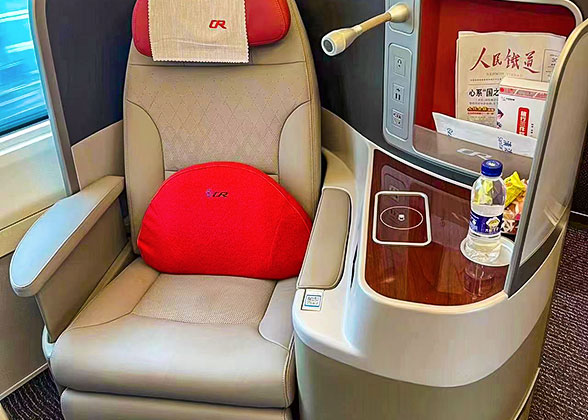
Which type of train and which class to choose

How to buy China rail tickets

How to take a train in China
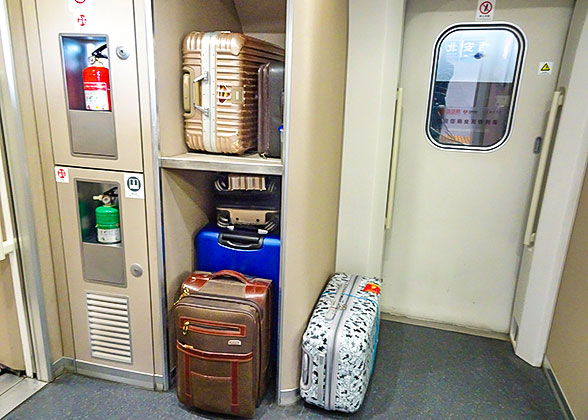
Weight & size limit for carry-on luggage
- Admission Tickets Booking
- Railway Stations
- Food Onboard
- Useful Chinese Phrases
- China Railway
- Railway Map
- Travel Tips
- International Tickets
- Booking FAQ
- China Train App
- Tips during Holidays
Best China Train Travel Routes:
- Beijing-Shanghai : 4.5 - 6 hours
- Hong Kong-Guangzhou : 1 hour
- Beijing-Xian : 4.5 - 6 hours
- Beijing-Guangzhou : 8 - 10 hours
- Shanghai-Guangzhou : 7 - 8.5 hours
- Shanghai-Hangzhou : 1 hour
- Shanghai-Suzhou : 23 - 44 minutes
- Guangzhou-Guilin : 2.5 hours
- Guangzhou-Hong Kong : 1 hour
- Guangzhou-Shenzhen : 30 minutes
- Xian-Shanghai : 6 - 7.5 hours
- Xian-Chengdu : 3 - 4.5 hours
Schedule of Top Chinese Cities:
Security Alert May 17, 2024
Worldwide caution, update may 10, 2024, information for u.s. citizens in the middle east.
- Travel Advisories |
- Contact Us |
- MyTravelGov |
Find U.S. Embassies & Consulates
Travel.state.gov, congressional liaison, special issuance agency, u.s. passports, international travel, intercountry adoption, international parental child abduction, records and authentications, popular links, travel advisories, mytravelgov, stay connected, legal resources, legal information, info for u.s. law enforcement, replace or certify documents.
Share this page:
China Travel Advisory
Travel advisory april 12, 2024, mainland china, hong kong & macau - see summaries.
Updated due to new national security legislation in the Hong Kong Special Administrative Region.
Summary: Reconsider travel to Mainland China due to the arbitrary enforcement of local laws, including in relation to exit bans, and the risk of wrongful detentions.
Exercise increased caution when traveling to the Hong Kong Special Administrative Region (SAR) due to the arbitrary enforcement of local laws .
Reconsider travel to the Macau Special Administrative Region (SAR) due to a limited ability to provide emergency consular services . Exercise increased caution when traveling to the Macau SAR due to the arbitrary enforcement of local laws .
See specific risks and conditions in each jurisdiction .
Mainland China – Level 3: Reconsider Travel
Reconsider travel due to the arbitrary enforcement of local laws , including in relation to exit bans, and the risk of wrongful detentions .
Summary: The People’s Republic of China (PRC) government arbitrarily enforces local laws, including issuing exit bans on U.S. citizens and citizens of other countries, without fair and transparent process under the law.
The Department of State has determined the risk of wrongful detention of U.S. nationals by the PRC government exists in the PRC.
U.S. citizens traveling or residing in the PRC may be detained without access to U.S. consular services or information about their alleged crime. U.S. citizens in the PRC may be subjected to interrogations and detention without fair and transparent treatment under the law.
Foreigners in the PRC, including but not limited to businesspeople, former foreign-government personnel, academics, relatives of PRC citizens involved in legal disputes, and journalists have been interrogated and detained by PRC officials for alleged violations of PRC national security laws. The PRC has also interrogated, detained, and expelled U.S. citizens living and working in the PRC.
PRC authorities appear to have broad discretion to deem a wide range of documents, data, statistics, or materials as state secrets and to detain and prosecute foreign nationals for alleged espionage. There is increased official scrutiny of U.S. and third-country firms, such as professional service and due diligence companies, operating in the PRC. Security personnel could detain U.S. citizens or subject them to prosecution for conducting research or accessing publicly available material inside the PRC.
Security personnel could detain and/or deport U.S. citizens for sending private electronic messages critical of the PRC, Hong Kong SAR, or Macau SAR governments.
In addition, the PRC government has used restrictions on travel or departure from the PRC, or so-called exit bans, to:
- compel individuals to participate in PRC government investigations;
- pressure family members of the restricted individual to return to the PRC from abroad;
- resolve civil disputes in favor of PRC citizens; and
- gain bargaining leverage over foreign governments.
U.S. citizens might only become aware of an exit ban when they attempt to depart the PRC, and there may be no available legal process to contest an exit ban in a court of law. Relatives, including minor children, of those under investigation in the PRC may become subject to an exit ban.
The PRC government does not recognize dual nationality. Dual U.S.-PRC citizens and U.S. citizens of Chinese descent may be subject to additional scrutiny and harassment. If you are a U.S. citizen and choose to enter Mainland China on travel documents other than a U.S. passport and are detained or arrested, the PRC government may not notify the U.S. Embassy or the U.S. Consulates General or allow consular access.
Check with the PRC Embassy in the United States for the most updated information on travel to the PRC. In some limited circumstances travelers to Mainland China may face additional COVID-19 testing requirements to enter some facilities or events.
The Department of State does not provide or coordinate direct medical care to private U.S. citizens abroad. U.S. citizens overseas may receive PRC-approved COVID-19 vaccine doses where they are eligible.
Do not consume drugs in the PRC or prior to arriving in the PRC. A positive drug test, even if the drug was legal elsewhere, can lead to immediate detention, fines, deportation, and/or a ban from re-entering the PRC. PRC authorities may compel cooperation with blood, urine, or hair testing. Penalties for drug offense may exceed penalties imposed in the United States.
Demonstrations : Participating in demonstrations or any other activities that authorities interpret as constituting an act of secession, subversion, terrorism, or collusion with a foreign country could result in criminal charges. Be aware of your surroundings and avoid demonstrations.
XINJIANG UYGHUR AUTONOMOUS REGION, TIBET AUTONOMOUS REGION, and TIBETAN AUTONOMOUS PREFECTURES
Extra security measures, such as security checks and increased levels of police presence and surveillance, are common in the Xinjiang Uyghur Autonomous Region, Tibet Autonomous Region, and Tibetan Autonomous Prefectures. Authorities may impose curfews and travel restrictions on short notice.
If you decide to travel to Mainland China:
- Enter the PRC on your U.S. passport with a valid PRC visa and keep it with you.
- Read the travel information page for Mainland China .
- Enroll in the Smart Traveler Enrollment Program (STEP) to receive alerts and make it easier to locate you in an emergency.
- Avoid demonstrations.
- Exercise caution in the vicinity of large gatherings or protests.
- Avoid taking photographs of protesters or police without permission.
- Keep a low profile.
- If you are arrested or detained, ask police or prison officials to notify U.S. Embassy Beijing or the nearest U.S. Consulate General immediately.
- Review the China Country Security Report from the Overseas Security Advisory Council.
- Do not consume drugs in the PRC or prior to arriving in the PRC.
- Follow the Department of State on Facebook and Twitter . Follow U.S. Embassy Beijing on Twitter , WeChat , and Weibo .
- Visit the Centers for Disease Control and Prevention (CDC) page for the latest Travel Health Information related to the PRC.
- Prepare a contingency plan for emergency situations.
- Review the Traveler’s Checklist .
Hong Kong Special Administrative Region (SAR) – Level 2: Exercise Increased Caution
Exercise increased caution due to the arbitrary enforcement of local laws .
Summary: Hong Kong SAR authorities have dramatically restricted civil liberties since the Government of the People’s Republic of China (PRC) imposed the Law of the PRC on Safeguarding National Security in the Hong Kong SAR on June 30, 2020. Following the Hong Kong SAR government’s enactment of its own Safeguarding National Security Ordinance on March 23, 2024, Hong Kong SAR authorities are expected to take additional actions to further restrict civil liberties.
The 2020 National Security Law outlines a broad range of vaguely defined offenses, such as acts of secession, subversion, terrorism, and collusion with foreign entities. The 2024 Safeguarding National Security Ordinance builds on this framework with additional vaguely defined offenses, such as treason, insurrection, theft of state secrets, sabotage against public infrastructure, and external interference. According to the legislation, these offenses are applicable to foreign nationals within the Hong Kong SAR and to individuals, including U.S. citizens and permanent residents, located outside its borders. Under these provisions, anyone who criticizes the PRC and/or Hong Kong SAR authorities may face arrest, detention, expulsion, and/or prosecution. Hong Kong SAR authorities are attempting to enforce these provisions against individuals, including U.S. citizens and permanent residents, residing outside of their jurisdiction by offering cash rewards for information leading to their arrests in the Hong Kong SAR.
Dual Nationality: The Hong Kong SAR government does not recognize dual nationality. Dual U.S.-PRC citizens and U.S. citizens of Chinese descent may be subject to additional scrutiny and harassment. If you are a dual U.S.-PRC citizen and enter Hong Kong SAR on a U.S. passport, and you are detained or arrested, PRC authorities are under an obligation to notify the U.S. Embassy or a U.S. Consulate General of your detention and to allow U.S. consular officials to have access to you. In practice, however, U.S. consular officers may be prevented from providing consular assistance, even to those who have entered on their U.S. passports. For more information, visit Consular Protection and Right of Abode in HK(SAR) for Dual Nationals - U.S. Consulate General Hong Kong & Macau .
Demonstrations : Participating in demonstrations or any other activities that authorities interpret as constituting an act of secession, subversion, terrorism, or collusion with a foreign country could result in criminal charges under the 2020 National Security Law and/or the 2024 Safeguarding National Security Ordinance. Be aware of your surroundings and avoid demonstrations.
If you decide to travel to the Hong Kong SAR:
- Enter the Hong Kong SAR on your U.S. passport and keep it with you.
- Read the travel information page for the Hong Kong SAR .
- Be aware of your surroundings.
- If you are arrested or detained, ask police or prison officials to notify U.S. Consulate General Hong Kong & Macau immediately.
- Review the China Country Security Report from the Overseas Security Advisory Council.
- Do not consume drugs in the Hong Kong SAR or prior to arriving in the Hong Kong SAR.
- Follow the Department of State on Facebook and Twitter . Follow U.S. Consulate General Hong Kong & Macau on Facebook and Twitter .
- Visit the Centers for Disease Control and Prevention (CDC) page for the latest Travel Health Information related to the Hong Kong SAR.
- Monitor local media, local transportations sites, and apps like MTR Mobile or Citybus for updates.
Macau Special Administrative Region (SAR) – Level 3: Reconsider Travel
Reconsider travel due to a limited ability to provide emergency consular services. Exercise increased caution due to the arbitrary enforcement of local laws.
Summary: The U.S. government has a limited ability to provide emergency services to U.S. citizens in the Macau SAR due to People’s Republic of China (PRC) Ministry of Foreign Affairs travel restrictions on U.S. diplomatic personnel.
Even in an emergency, the PRC Ministry of Foreign Affairs requires all U.S. diplomatic personnel, including those accredited to the Macau SAR, to apply for and receive visas before entering the Macau SAR. Approval takes at least five to seven days, significantly limiting the U.S. government’s ability to offer timely consular services in the Macau SAR.
Dual Nationality: The Macau SAR government does not recognize dual nationality. Dual U.S.-PRC citizens and U.S. citizens of Chinese descent may be subject to additional scrutiny and harassment. If you are a dual U.S.-PRC citizen and enter the Macau SAR on a U.S. passport, and you are detained or arrested, PRC authorities are under an obligation to notify the U.S. Embassy or a U.S. Consulate General of your detention and to allow U.S. consular officials to have access to you. In practice, however, U.S. consular officers may be prevented from providing consular assistance, even to those who have entered on their U.S. passports. For more information, visit Consular Protection and Right of Abode in HK(SAR) for Dual Nationals - U.S. Consulate General Hong Kong & Macau .
Demonstrations : Participating in demonstrations or any other activities that authorities interpret as constituting an act of secession, subversion, terrorism, or collusion with a foreign country could result in criminal charges. Be aware of your surroundings and avoid demonstrations.
If you decide to travel to the Macau SAR:
- Enter the Macau SAR on your U.S. passport and keep it with you.
- Read the travel information page for the Macau SAR .
- If you are arrested or detained, ask police or prison officials to notify Review the China Country Security Report from the Overseas Security Advisory Council.
- Do not consume drugs in the Macau SAR or prior to arriving in the Macau SAR.
- Follow the Department of State on Facebook and Twitter . Follow U.S. Consulate General Hong Kong & Macau on Facebook and Twitter .
- Visit the Centers for Disease Control and Prevention (CDC) page for the latest Travel Health Information related to the Macau SAR.
- Monitor local media and the Macau Government Tourism Office website for updates.
- Review your flight status with your airline or at the Macau International Airport website.
Travel Advisory Levels
Assistance for u.s. citizens, search for travel advisories, external link.
You are about to leave travel.state.gov for an external website that is not maintained by the U.S. Department of State.
Links to external websites are provided as a convenience and should not be construed as an endorsement by the U.S. Department of State of the views or products contained therein. If you wish to remain on travel.state.gov, click the "cancel" message.
You are about to visit:
Famous waterfall in China goes viral after hiker finds pipe supplying it
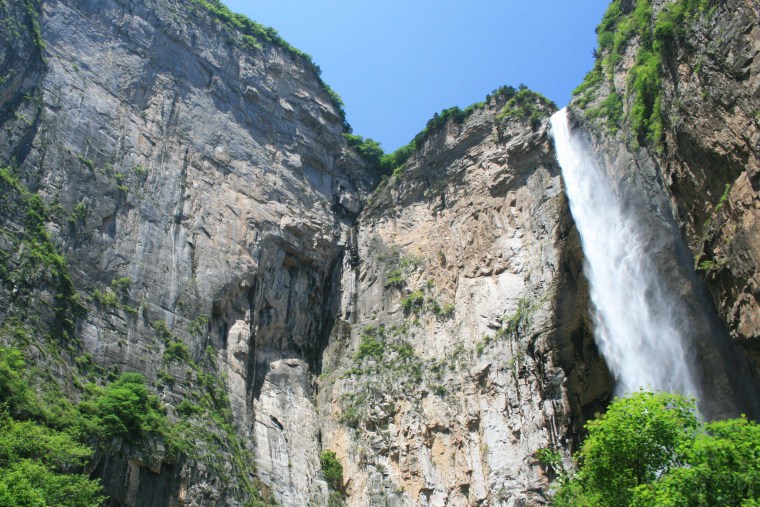
HONG KONG — China’s highest natural waterfall has cascaded into controversy after a video posted to social media showed water flowing from a pipe built into the rock face.
The Yuntai Sky Fall, which at just over 1,000 feet is classified as China’s highest tourism site, is popular with visitors, many of whom become soaked by mist as they view the torrent of water from a platform near its base.
But after a hiker posted the video showing the pipe on Douyin, the Chinese version of TikTok , the operators of the Yuntai Mountain Geo park where the falls are based admitted they had made a “small enhancement” to the site.
“To enrich the visiting experience of our friends, and to ensure that you who have traveled from afar do not come in vain, I have made a small enhancement during the dry season, solely to be able to present myself in a better state when meeting with my friends,” they said in a statement.
On Douyin , the video of the large pipe coming out of the mountain with water pouring out of it quickly went viral.
Alongside the video, the hiker who posted it wrote that it was difficult to reach the source of the waterfall, but when they got there they found only a pipe.
After the video was shared thousands of times, for the most part on Weibo, China’s largest microblogging site, users were understanding about the decision to keep the water flowing.
“As long as you are willing to put in the effort for me, that is good enough,” one user wrote. Another added that it was “great that you can still see the grand waterfall even during the dry season.”
“I understand,” one said. “Actually, many scenic spots do this during the dry season, otherwise without water it wouldn’t feel worth the visit.”
Others were slightly less forgiving.
“They are just so accustomed to fabricating things,” one user wrote, while others pointed out that the park was deceiving tourists and unfairly profiting.
Under Article 48 of the Tourism Law of the People’s Republic of China, “websites releasing information on tourism operation shall ensure the authenticity and accuracy of such information.”
Before the hiker uploaded the video, the pipe was not mentioned on the website or social media accounts of the park, which received more than 7 million visitors last year, according to the Department of Culture and Tourism in the eastern Henan Province, where the park is.
However, there are other artificial waterfalls in China, including one at the Tiantai Mountain in the eastern Zhejiang province that is known for its “punctual clocking off.”
Dry for 60 years because of the construction of a reservoir, in 2013 it was transformed into a cascading waterfall that now runs for set hours every day.
Cheng Wong is an intern on NBC News’s Asia Desk.
- 86-19138970032 (GMT+8 18:00~09:00)

- Beijing Xian Tours
- Shanghai Beijing Tours
- Hong Kong Guilin Tours
- Hangzhou Suzhou Tours
- Kunming Lijiang Tours
- Shanghai Yangtze Cruise Tours
- Chengdu Tibet Tours
- More Short Stay Tours
- China Tours in January
- China Tours in February
- China Tours in March
- China Tours in April
- China Tours in May
- China Tours in June
- China Tours in July
- China Tours in August
- China Tours in September
- China Tours in October
- China Tours in November
- China Tours in December

- High Speed Trains
- China Yangtze Cruise Tour
- Photography
- Desert Adventure
- Ethnic Villages
- Biking Tours
- Kung Fu Tours
- Heritage Sites Exploration
- China Spring Tours
- China Summer Tours
- China Autumn Tours
- China Winter Tours
Notice! 2024 available cruise routes include 4~5 days Chongqing-Yichang(most classic) and 11~12 days Chongqing-Yichang-Shanghai(limited).

- Best-value Yangtze Cruises
- Top Family-friendly Cruise Ships
- Top 3 Luxury Yangtze River Cruises
- Yangtze River Highlights
- Yangtze River Cruise Routes
- Upstream or Downstream?
- Dining & Drinking
- Accommodations
- On-board Activities
- Yangtze Cruise Booking Steps

- Inner Mongolia

- Fanjingshan
- How to Plan Your First China Tour
- How to Plan Beijing Tour
- How to Plan Xian Tour
- How to Plan Shanghai Tour
- How to Plan Guilin Tour
- How to Plan Sichuan Tour
- How to Plan Family Tour
- 2024 China Travel Ideas
- Best Time to Visit China
- What to Pack for Your China Journey
- Make Payment in China
- Updated China Travel News
- Ultimate Chinese Visa Guide
- Chinese Visa Types
- Chinese Visa Requirements
- Do I Need a Visa for China
- Chinese Visa Application
- Chinese Visa Exemptions
- 144-hour Visa Free
- Shenzhen Visa on Arrival
- Hainan 30-day Visa Free
- Embassies & Consulates
- Invitation Letter
- Useful Visa FAQs & Tips
- Entry Regulations
- Baggage Allowance
- Customs Declaration
- Exit Regulation
- How to Book Train Tickets
- How to Collect Train Tickets
- How to Cancel & Alter Train Tickets
- How to Read Train Tickets
- China High Speed Train Types
- Seats Class & How to Choose
- Friendly Facilities on the Train
- The Train Station Departure Process
- Available Food and Drinks on the Train
- Western Toilets on the Train
- Luggage Racks & Baggage Allowance
- Beijing Train Stations
- Shanghai Train Stations
- Guilin Train Stations
- Xian Train Stations
- Chengdu Train Stations
- Hong Kong West Kowloon Railway Station
- Beijing - Xian
- Beijing - Shanghai
- Guangzhou - Shanghai
- Shenzhen - Shanghai
- Chengdu - Xian
- Shanghai - Hangzhou
- Shanghai - Xian
- Chengdu - Chongqing
- Kunming - Lijiang
- Beijing Capital International
- Beijing Daxing International
- Shanghai Pudong International
- Shanghai Hongqiao International
- Guangzhou Baiyun International
- Hangzhou Xiaoshan International
- Chengdu Tianfu International
- Chengdu Shuangliu International
- Xian Xianyang International
- Shanghai - Beijing
- Hong Kong - Shanghai
- Guangzhou - Beijing
- Chengdu - Lhasa
- Shanghai - Guilin
- Shanghai - Sanya
- Travel in Spring Season
- Travel in Summer Season
- Travel in Autumn Season
- Travel in Winter Season
- Weather in January
- Weather in February
- Weather in March
- Weather in April
- Weather in May
- Weather in June
- Weather in July
- Weather in August
- Weather in September
- Weather in October
- Weather in November
- Weather in December
- Top 10 China Destinations
- Top 15 Things to Do
- China World Heritage Sites
- Top 10 Best Natural Beauties
- Top 10 Museums in China
- Top 10 Old Towns & Villages
- Five Great Mountains in China
- Top 10 Monasteries & Temples
- Top 10 Ski Resorts
- Top 10 Beautiful Lakes in China
- 7 Best Beaches in Sanya
- Top 6 Beautiful Waterfalls
- Panda Volunteering
- Having fun on Ice and Snow Festival
- About Us Who We Are Our Team Why Travel with Us Feedback & Reviews Travel Stories Travelers' Gallery Payment Guide Customer Support Contact Us
- Tour Experiences
Destinations
- Travel Guide
Top Dali Attractions
Dali as a center of the Dali Bai Autonomous Prefecture gathers 25 ethnic minorities to create a unique background with kinds of ancient towns and historical buildings. With its geographical location and pleasant weather, there are many top attractions to see in Dali.
Dali Old Town is the No.1 must-see to seek the past history of the influential ancient Nanzhao kingdom. Cangshan Mountain and Erhai Lake are praised as the city's leading scenic areas. Most attractions lie between these two landmarks, such as the Butterfly Spring and the Three Pagodas . Also there are many activities held, like Spring Fair , Bai Torch Festival , etc.
Most Popular Dali Tour:
▶ 3 Days Dali Classic Tour
For most visitors to Dali, they prefer travel Dali together with more destinations in Yunnan in one go, such as Kunming with Stone Forest (1-2 days), Lijiang with Lijiang Old Town (2-3 days), Shangri-La with Sumtseling Monastery (1-2 days), etc. The amazing natural and cultural highlights in colorful Yunnan deserves your visit!
Best Dali Yunnan Tours:
▶ 6 Days Yunnan Essence Tour (Kunming, Dali & Lijiang)
▶ 8 Days Classic Yunnan Tour (Kunming / Dali / Lijiang / Shangri-La)
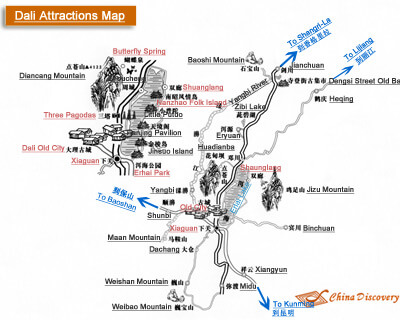
Dali Travel Map
- Top Attractions
- Top Things to Do
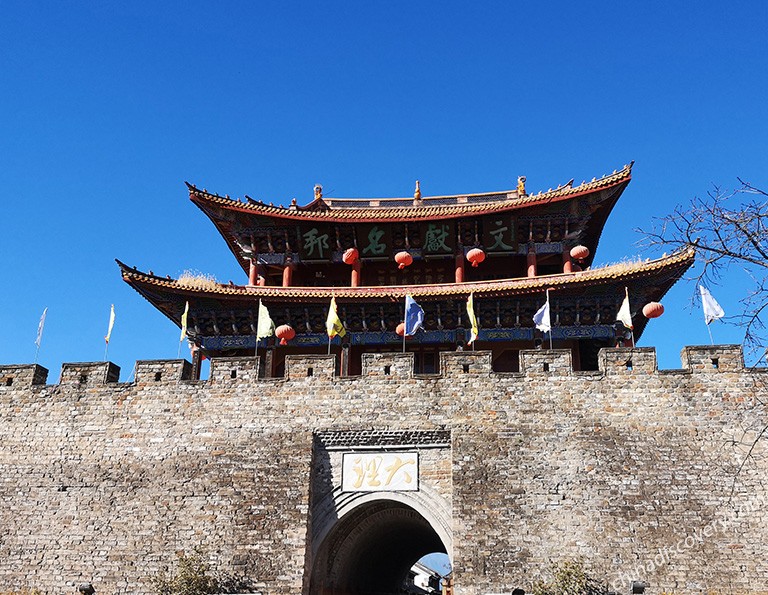
No.1 Dali Old Town
Type: Ancient Town, Historic Sites
Dali Old Town is the southernmost of the large old towns - the other two are Lijiang and Shangri-La. Embracing Erhai Lake in the east and Cangshan Mountain in the west; streams from Cangshan Mountain come into the city, going across the streets and visiting every family, running eastwards to Erhai Lake. In the Town, you’ll enjoy the City Wall, Gate-towers, elegant streets, small and exquisite courtyards, colorful flowers blooming in the sunshine. Some visitors, seduced by Dali’s charms forget to leave and Westerners run much business here.
Recommended Tour:
6 Days Yunnan Essence Tour (Kunming, Dali & Lijiang)
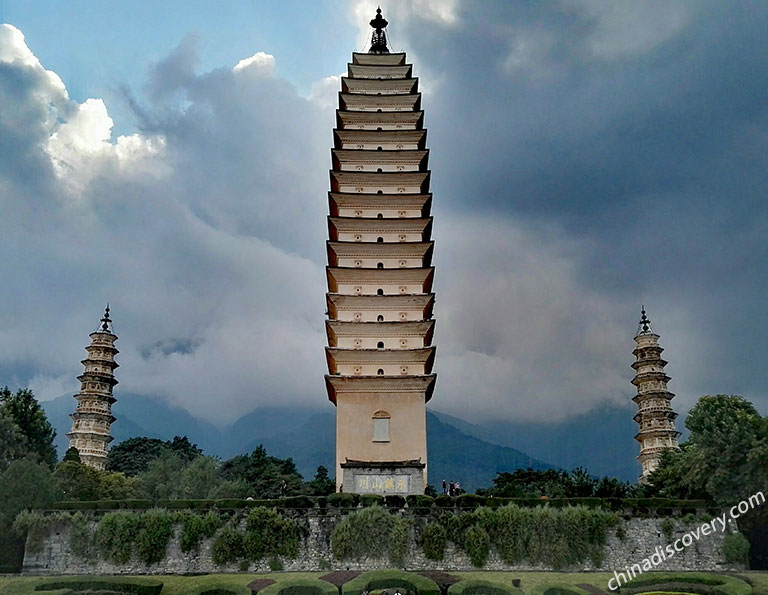
No.2 The Three Pagodas
Type: Cultural Relics, Scenic Spots
The Three Pagodas , around 3km north of the Dali Old Town, is Dali’s most iconic landmarks, three Layered, cream-coloured pagodas gently tapering towards their summits. The oldest pagoda was built around 850 when the region was a major Buddhist center. The Three Pagodas look best at a distance. Chongsheng Temple adjoins the Three Pagodas and was the largest monastery in this area.
8 Days Classic Yunnan Tour (Kunming / Dali / Lijiang / Shangri-La)
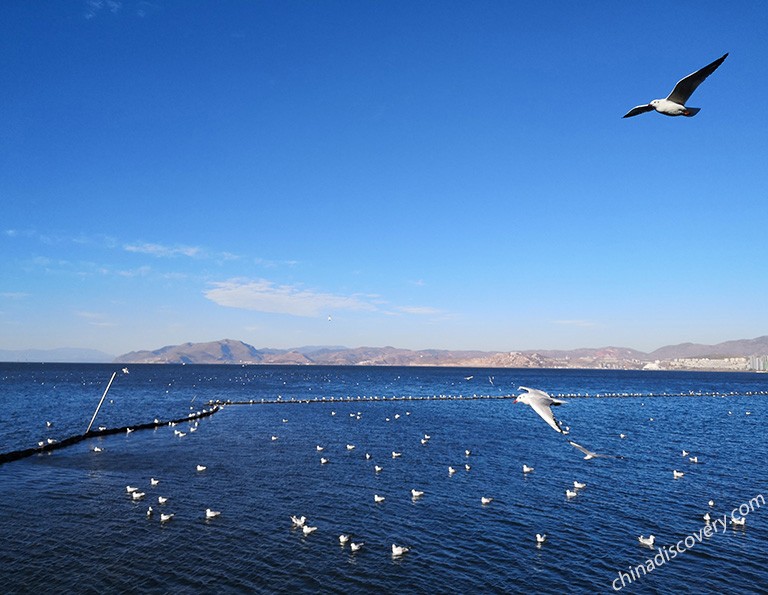
No.3 Erhai Lake
Type: Natural Landscape,Scenic Spots
Erhai Lake stretches 40km along the flat valley in the west of Dali Old Town, its shore fringed with Bai villages. The west side is well watered by stream descending the Cangshan Mountain; and famous little old town, Xizhou Town and Zhoucheng Town are all lies in the west side. You can reach many local villages by cycling or car.
Cruising on the Erhai Lake is a leisure way to see the Lake. Also, you can choose cycling . Cormorant fishing trips are available for tourist to see local traditional fishing.
3 Days Dali Classic Tour
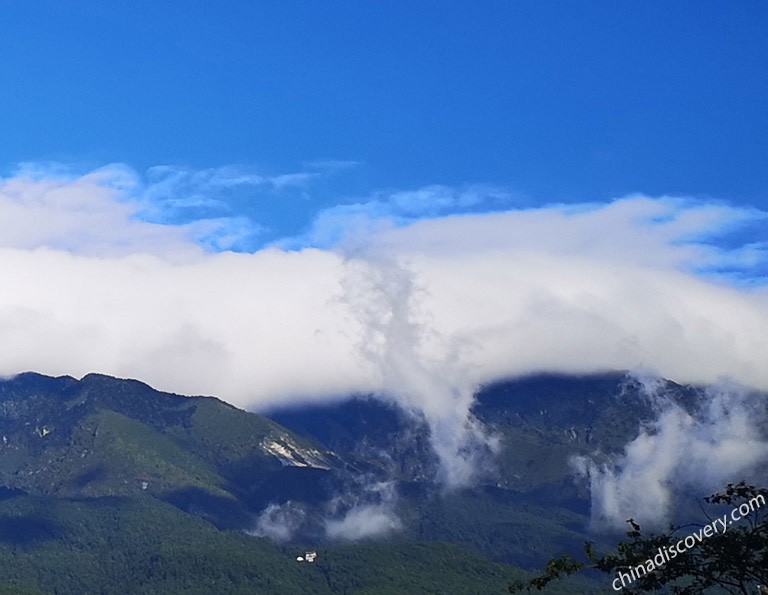
No.4 Cangshan Mountain
Cangshan Mountain , the Green Mountains, is a 50-km-long range peaking from between 2100m and 4122m, cloaked in thick forest and cloud. You’ll experience 15km-long walking trail (named Cloud Pass) which passes some temples, waterfalls, caves and shrines; you’ll see Gantong Temple , Qingbi Stream , Grand Canyon and Zhonghe Temple by the walking trail. In good weather, views off the mountain take in the whole Erhai Lake , with plenty of birdlife, the odd squirrel and colorful flowers alongside the path. Of course, you can take multi-day hikes in the mountain area if you are hiking enthusiasts.
3 Days Dali City Tour with Cangshan Mountain Hiking
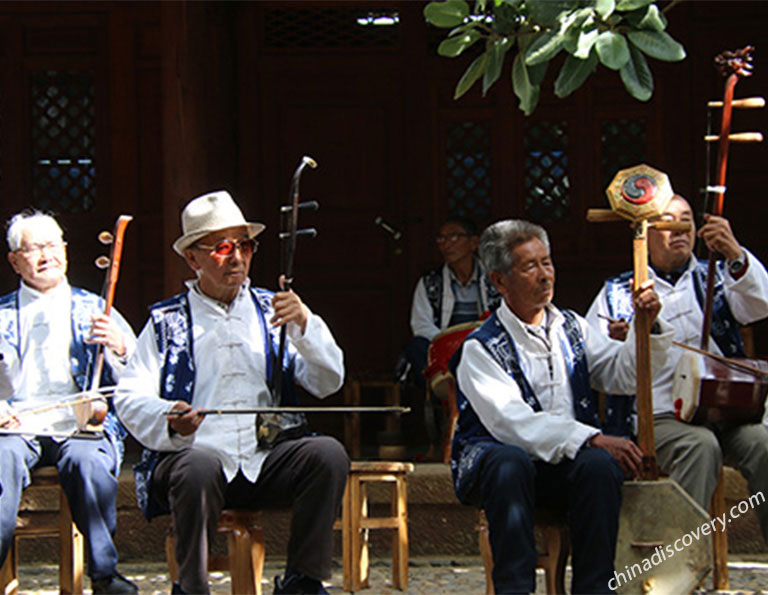
No.5 Shaxi Ancient Town
Shaxi Ancient Town is an attractive old mud-brick Bai town of Shaxi, occupies a flat, heavily farmed valley, 95km northwest of Dali Old Town. Shaxi is tiny but plays a very important role as a bustling trade station on the Tea and Horse Road . Nowadays, Shaxi still has that border-town feel; mountain villagers come down from the hills to trade their goods on every Friday which is Friday Market in Shaxi. Even you can buy a horse here if you would like. Some sites you can’t miss- Sideng , Sifang Street and the arched stone Yujin Bridge which marks the start of the old packhorse route north to Tibet. It’s best to catch Friday Market here if you are lucky.
4 Days Dali Leisure Vacation for Nature & Culture Savory (in Luxury Boutique Hotel)
6 Days Dali Lijiang Tour with Shaxi Ancient Town (Dali / Shaxi Ancient Town / Lijiang)
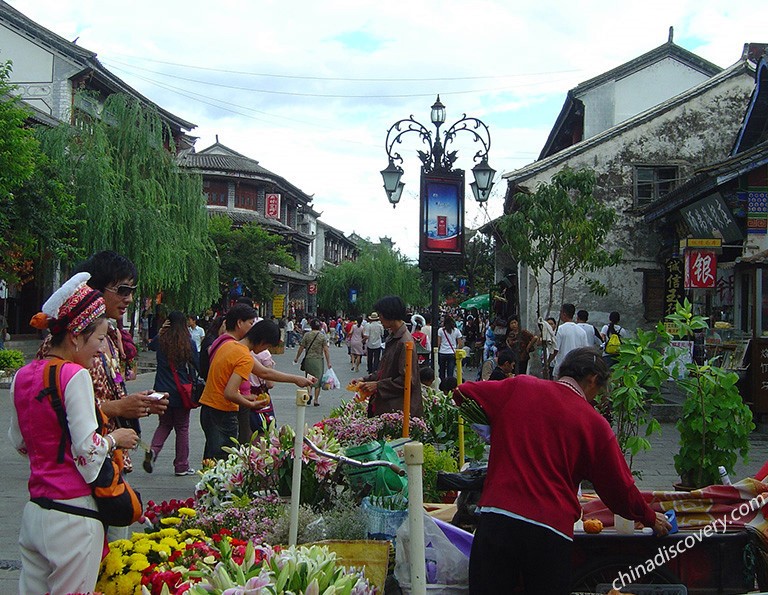
No.6 Xizhou Village & Morning Market
Type: Ancient Town
With 18km north from Dali Old town, the single most important Bai town , Xizhou Village was once a commercial center of Yunnan Province, and more than 1500 year ago, Xizhou and nearby area has been the major habitat for the Bai people. Xizhou is going to show you the Bai minority cultural, the local people’s daily life and natural beauty.
The morning market in Xizhou, a place for local people trading daily supplies, including fresh vegetable, fruits, meats, and many kinds of food and daily necessities. It is a great opportunity for getting close to local living conditions.
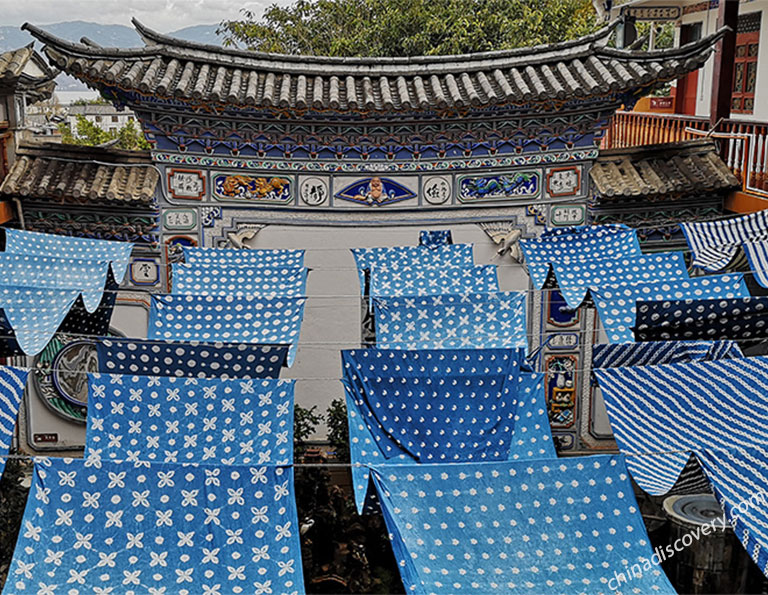
No.7 Zhoucheng Village
This small town is 28km up the highway from Dali Old Town. Zhoucheng is a tie-dyeing center , is named “ the Land for National Tie-Dye ” by China Culture Administration. Tie-dye is an old Chinese textile dyeing technique. This traditional technique is still popular in Zhouzheng. Behind Zhoucheng’s main marketplace, the Butterfly Spring is a deep, blue pond haunted by clouds of butterflies in early summer. The Butterfly Festival is held on the 15th of the fourth lunar month (Late May or early June).
Keep Reading on Dali
- Dali Old Town
- Cangshan Mountain
- Three Pagodas & Chongsheng Temple
- Xizhou Village
- Shaxi Ancient Town
- How to Plan a Dali Tour
- Dali Things to Do
- Dali Transportation
- Dali Weather
- Dali Where to Stay
- Dali Hotels
- Dali Travel Guide
Useful Yunnan Travel Articles
- Yunnan Travel Guide
- How to Plan a Yunnan Tour
- Yunnan Tours
- Kunming Tours
- Lijiang Tours
- Shangri-La Tours
- Yuanyang Tours
- Top 10 Places to Visit in Yunnan
- Yunnan Attractions
- Yunnan Transportation
- Yunnan Weather & Seasons
- Yunnan Maps
- Yunnan Minorities
- Yunnan Ethnic Festivals
- Yunnan Ethnic Markets
Recommended Dali Tours
Top 3 Dali tours chosen by most customers to explore Dali in the best way. Check the detailed itinerary, or tailor your own trip now with us.
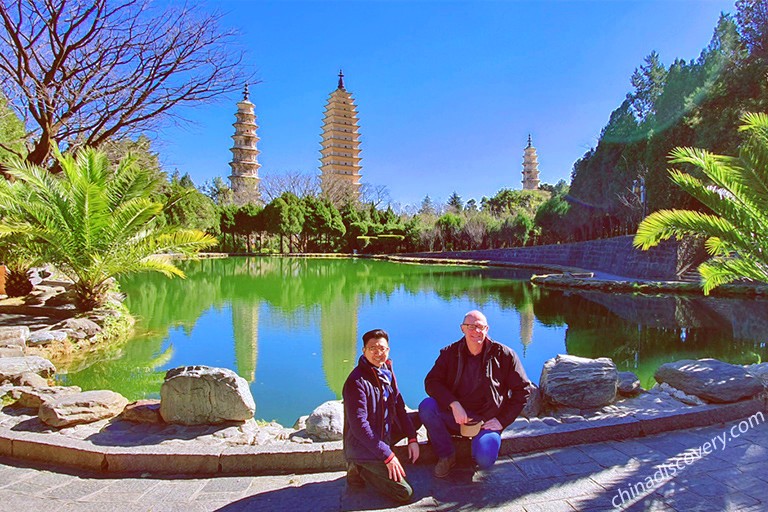
4 Days Kunming & Dali Highlights Tour by High Speed Train
Kunming / Stone Forest / Kunming / Dali
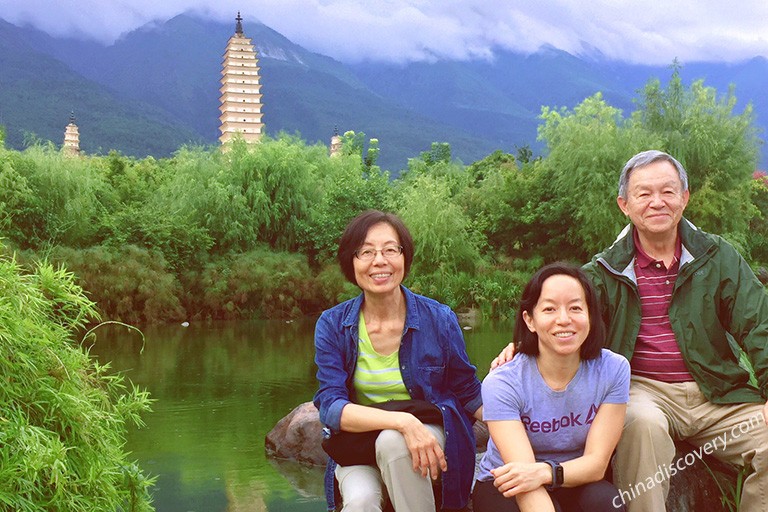
8 Days Classic Yunnan Tour
Kunming / Dali / Lijiang / Shangri-La
Start planning your tailor-made holiday to China by contacting one of our specialists. Once inquired, you’ll get a response within 0.5~23.5 hours.

- Affordable and valuable price
- 100% tailor-made packages
- Highly rated customers reviews
- Efficient customer support
China Tours
- Top 10 China Tours
- Classic China Tours
- China Tours from Beijing
- China Tours from Shanghai
- China Tours from Hong Kong
- China Tours from Chengdu
- Short China Trips
- Customize China Tour
- China Panda Tours
- Family Tour with Kids
- High-Speed Train Tour
- Silk Road Travel
- Yangtze River Cruise
- Hiking & Trekking Tours
- Photography Tours
- China Minority Travel
- Beijing Shanghai Tours
- Shanghai Yangtze Tours
- Chengdu Jiuzhaigou Tours
- Chengdu Lhasa Tours
- Suzhou Hangzhou Tours
- Guilin & Yangshuo
- Zhangjiajie
“Very good experience”
“WONDERFUL 25 DAYS IN CHINA - PRIVATE TOUR”
“Awesome China tour from northeast to southwest”
Any questions, please email us at: [email protected] or call us at: 86-19138970032 (Monday-Friday 9 a.m. to 6 p.m. GMT+8)
- Terms & Condition
- Privacy Policy
- Customer Support
Copyright © 2011-2024. All rights reserved.
Cookie policy
We use cookies to give you the best experience on our website. Continue using our website means you agree with our cookie policy. For more info, please read here .
1,434 episodes
Learn something new every day! Everything Everywhere Daily is a daily podcast for Intellectually Curious People. Host Gary Arndt tells the stories of interesting people, places, and things from around the world and throughout history. Gary is an accomplished world traveler, travel photographer, and polymath. Topics covered include history, science, mathematics, anthropology, archeology, geography, and culture. Past history episodes have dealt with ancient Rome, Phoenicia, Persia, Greece, China, Egypt, and India. as well as historical leaders such as Julius Caesar, Emperor Augustus, Sparticus, and the Carthaginian general Hannibal. Geography episodes have covered Malta, Tuvalu, Vanuatu, Monaco, Luxembourg, Vatican City, the Marshall Islands, Kiribati, the Isle of Man, san marino, Namibia, the Golden Gate Bridge, Montenegro, and Greenland. Technology episodes have covered nanotechnology, aluminum, fingerprints, longitude, qwerty keyboards, morse code, the telegraph, radio, television, computer gaming, Episodes explaining the origin of holidays include Memorial Day, April Fool’s Day, St. Patrick’s Day, May Day, Christmas, Ramadan, Halloween, Thanksgiving, Canada Day, the Fourth of July, Famous people in history covered in the podcast include Salvador Dali, Jim Thorpe, Ada Lovelace, Jessie Owens, Robert Oppenheimer, Picasso, Isaac Newton, Attila the Hun, Lady Jane Grey, Cleopatra, Sun Yat Sen, Houdini, Tokyo Rose, William Shakespeare, Queen Boudica, Empress Livia, Marie Antoinette, the Queen of Sheba, Ramanujan, and Zheng He.
Everything Everywhere Daily Gary Arndt | Glassbox Media
- 4.7 • 1.2K Ratings
- JUN 9, 2024
College Sports
In the 19th century, several American universities began to compete with each other in several sporting events in friendly intercollegiate competitions. Fast forward over a hundred years, and college sports in the United States is a multibillion-dollar business. How did institutes of higher education become some of the biggest sports organizations in the world? And how did this situation come to be, and why does it only exist in the United States? Learn more about college sports and how it became to be such a big business on this episode of Everything Everywhere Daily. Sponsors Available nationally, look for a bottle of Heaven Hill Bottled-in-Bond at your local store. Find out more at heavenhilldistillery.com/hh-bottled-in-bond.php Sign up today at butcherbox.com/daily and use code daily to choose your free offer and get $20 off. Visit BetterHelp.com/everywhere today to get 10% off your first month. Use the code EverythingEverywhere for a 20% discount on a subscription at Newspapers.com. Visit meminto.com and get 15% off with code EED15. Listen to Expedition Unknown wherever you get your podcasts. Get started with a $13 trial set for just $3 at harrys.com/EVERYTHING. Subscribe to the podcast! https://link.chtbl.com/EverythingEverywhere?sid=ShowNotes -------------------------------- Executive Producer: Charles Daniel Associate Producers: Ben Long & Cameron Kieffer Become a supporter on Patreon: https://www.patreon.com/everythingeverywhere Update your podcast app at newpodcastapps.com Discord Server: https://discord.gg/UkRUJFh Instagram: https://www.instagram.com/everythingeverywhere/ Facebook Group: https://www.facebook.com/groups/everythingeverywheredaily Twitter: https://twitter.com/everywheretrip Website: https://everything-everywhere.com/ Learn more about your ad choices. Visit megaphone.fm/adchoices
- JUN 8, 2024
Ninjas (Encore)
Ninjas are awesome. They’re silent, they can turn invisible, and they can totally flip out and kill people, especially their mortal enemies…pirates. …or at least that is what popular culture would like you to believe. Were ninjas really as powerful as they are made out to be? Were they the ultimate silent assassins? Learn more about ninjas, real ninjas, on this episode of Everything Everywhere Daily. Sponsors Available nationally, look for a bottle of Heaven Hill Bottled-in-Bond at your local store. Find out more at heavenhilldistillery.com/hh-bottled-in-bond.php Sign up today at butcherbox.com/daily and use code daily to choose your free offer and get $20 off. Visit BetterHelp.com/everywhere today to get 10% off your first month. Use the code EverythingEverywhere for a 20% discount on a subscription at Newspapers.com. Visit meminto.com and get 15% off with code EED15. Listen to Expedition Unknown wherever you get your podcasts. Get started with a $13 trial set for just $3 at harrys.com/EVERYTHING. Subscribe to the podcast! https://link.chtbl.com/EverythingEverywhere?sid=ShowNotes -------------------------------- Executive Producer: Charles Daniel Associate Producers: Ben Long & Cameron Kieffer Become a supporter on Patreon: https://www.patreon.com/everythingeverywhere Update your podcast app at newpodcastapps.com Discord Server: https://discord.gg/UkRUJFh Instagram: https://www.instagram.com/everythingeverywhere/ Facebook Group: https://www.facebook.com/groups/everythingeverywheredaily Twitter: https://twitter.com/everywheretrip Website: https://everything-everywhere.com/ Learn more about your ad choices. Visit megaphone.fm/adchoices
- JUN 7, 2024
The Five Good Emperors
Depending on how you define it, there were approximately 70 Roman Emperors. They were a mixed bag ranging from philosophers to the insane, from generals to children. Some were truly horrible, but some were actually pretty good at their job. In particular, there were five consecutive emperors who reigned during the peak of Pax Romana. Learn more about the Five Good Emperors on this episode of Everything Everywhere Daily. Sponsors Available nationally, look for a bottle of Heaven Hill Bottled-in-Bond at your local store. Find out more at heavenhilldistillery.com/hh-bottled-in-bond.php Sign up today at butcherbox.com/daily and use code daily to choose your free offer and get $20 off. Visit BetterHelp.com/everywhere today to get 10% off your first month. Use the code EverythingEverywhere for a 20% discount on a subscription at Newspapers.com. Visit meminto.com and get 15% off with code EED15. Listen to Expedition Unknown wherever you get your podcasts. Get started with a $13 trial set for just $3 at harrys.com/EVERYTHING. Subscribe to the podcast! https://link.chtbl.com/EverythingEverywhere?sid=ShowNotes -------------------------------- Executive Producer: Charles Daniel Associate Producers: Ben Long & Cameron Kieffer Become a supporter on Patreon: https://www.patreon.com/everythingeverywhere Update your podcast app at newpodcastapps.com Discord Server: https://discord.gg/UkRUJFh Instagram: https://www.instagram.com/everythingeverywhere/ Facebook Group: https://www.facebook.com/groups/everythingeverywheredaily Twitter: https://twitter.com/everywheretrip Website: https://everything-everywhere.com/ Learn more about your ad choices. Visit megaphone.fm/adchoices
- JUN 6, 2024
On December 6, 1944, the largest amphibious landing in world history took place on the shore of Normandy, France. The allied forces called it D-Day. The landing marked the commencement of Operation Overlord, a strategic move that heralded the long-awaited opening of the second front in the European war. D-Day was the start of the most meticulously planned events in history and one of the greatest logistical operations of all time. It was also the day that saw some of the war's most horrific and heroic actions. Learn more about D-Day and the start of the liberation of Western Europe on this episode of Everything Everywhere Daily. Sponsors Available nationally, look for a bottle of Heaven Hill Bottled-in-Bond at your local store. Find out more at heavenhilldistillery.com/hh-bottled-in-bond.php Sign up today at butcherbox.com/daily and use code daily to choose your free offer and get $20 off. Visit BetterHelp.com/everywhere today to get 10% off your first month. Use the code EverythingEverywhere for a 20% discount on a subscription at Newspapers.com. Visit meminto.com and get 15% off with code EED15. Listen to Expedition Unknown wherever you get your podcasts. Get started with a $13 trial set for just $3 at harrys.com/EVERYTHING. Subscribe to the podcast! https://link.chtbl.com/EverythingEverywhere?sid=ShowNotes -------------------------------- Executive Producer: Charles Daniel Associate Producers: Ben Long & Cameron Kieffer Become a supporter on Patreon: https://www.patreon.com/everythingeverywhere Update your podcast app at newpodcastapps.com Discord Server: https://discord.gg/UkRUJFh Instagram: https://www.instagram.com/everythingeverywhere/ Facebook Group: https://www.facebook.com/groups/everythingeverywheredaily Twitter: https://twitter.com/everywheretrip Website: https://everything-everywhere.com/ Learn more about your ad choices. Visit megaphone.fm/adchoices
- JUN 5, 2024
The Apollo Lunar Module
When President John F. Kennedy set the objective of landing on the moon before the end of the 1960s, no one really knew what it entailed. The Apollo program involved many incredible feats of engineering, but perhaps the most impressive was the development of the Apollo Lunar Module. The Lunar Module was unlike any spacecraft before or since. It was the first spacecraft designed to fly only in the vacuum of space and the first to land on another celestial body. Learn more about the Apollo Lunar Module and the incredible design challenges it had to overcome on this episode of Everything Everywhere Daily. Sponsors Available nationally, look for a bottle of Heaven Hill Bottled-in-Bond at your local store. Find out more at heavenhilldistillery.com/hh-bottled-in-bond.php Sign up today at butcherbox.com/daily and use code daily to choose your free offer and get $20 off. Visit BetterHelp.com/everywhere today to get 10% off your first month. Use the code EverythingEverywhere for a 20% discount on a subscription at Newspapers.com. Visit meminto.com and get 15% off with code EED15. Listen to Expedition Unknown wherever you get your podcasts. Get started with a $13 trial set for just $3 at harrys.com/EVERYTHING. Subscribe to the podcast! https://link.chtbl.com/EverythingEverywhere?sid=ShowNotes -------------------------------- Executive Producer: Charles Daniel Associate Producers: Ben Long & Cameron Kieffer Become a supporter on Patreon: https://www.patreon.com/everythingeverywhere Update your podcast app at newpodcastapps.com Discord Server: https://discord.gg/UkRUJFh Instagram: https://www.instagram.com/everythingeverywhere/ Facebook Group: https://www.facebook.com/groups/everythingeverywheredaily Twitter: https://twitter.com/everywheretrip Website: https://everything-everywhere.com/ Learn more about your ad choices. Visit megaphone.fm/adchoices
- JUN 4, 2024
A Brief History of Central America
Located between Mexico and Columbia, in a strategic area connecting the Atlantic and the Pacific, is the region we call Central America. The countries that makeup Central America were mostly former Spanish colonies, but unlike other Spanish colonies to the north and south, Central America wound up as a series of small countries rather than one big one. But why? Learn more about the history of Central America and how the current borders came to be on this episode of Everything Everywhere Daily. Sponsors Available nationally, look for a bottle of Heaven Hill Bottled-in-Bond at your local store. Find out more at heavenhilldistillery.com/hh-bottled-in-bond.php Sign up today at butcherbox.com/daily and use code daily to choose your free offer and get $20 off. Visit BetterHelp.com/everywhere today to get 10% off your first month. Use the code EverythingEverywhere for a 20% discount on a subscription at Newspapers.com. Visit meminto.com and get 15% off with code EED15. Listen to Expedition Unknown wherever you get your podcasts. Get started with a $13 trial set for just $3 at harrys.com/EVERYTHING. Subscribe to the podcast! https://link.chtbl.com/EverythingEverywhere?sid=ShowNotes -------------------------------- Executive Producer: Charles Daniel Associate Producers: Ben Long & Cameron Kieffer Become a supporter on Patreon: https://www.patreon.com/everythingeverywhere Update your podcast app at newpodcastapps.com Discord Server: https://discord.gg/UkRUJFh Instagram: https://www.instagram.com/everythingeverywhere/ Facebook Group: https://www.facebook.com/groups/everythingeverywheredaily Twitter: https://twitter.com/everywheretrip Website: https://everything-everywhere.com/ Learn more about your ad choices. Visit megaphone.fm/adchoices
- © Copyright 2020-2024 Gary Arndt, All Rights Reserved
Customer Reviews
1.2K Ratings
Outstanding Podcast
Gary is a vey professional, well-spoken orator and produces and writes excellent podcasts. They are about 15 minutes long and are very informative. Download or peruse his podcast, and you will be entertained. Highly recommended.
Perfect podcast for ADHD listeners!
I wish I’d discovered this podcast a while ago. The short episodes and super diverse topics covered are a dream for someone with ADD like me who is curious about everything but has a notoriously short attention span. Feeds my Wikipedia wormhole urges, but without the resultant physical inertia since I can listen to them while doing housework!
BEST PODCAST EVER!!!
This show is amazing. I love listening to it every single day after school, and the content on this show is great. Best podcast ever!!! ❤️❤️❤️❤️
Top Podcasts In History
You might also like.

IMAGES
COMMENTS
Dali travel information provides travelers with attractions, things to do, Dali Bai culture, transportation, best times to visit and suggested tours on Dali. China Tours. ... Best (& Worst) Times to Visit China, Travel Tips (2024/2025) How to Plan a 10-Day Itinerary in China (Best 5 Options) 8 Days in China: Top 15 Tours and Itineraries (2024/2025)
Check Dali China travel guide to view top attractions and things to do, when and how to get to Dali, where to stay to plan a Yunnan Dali tour in 2024. Tailor-made Tour Package Refundable Quick Response 3,770+ comments (1,910+ reviews)
Dali Airport is located in the junction of Fengyi Town and Haidong Town, Dali City, Dali Bai Autonomous Prefecture, Yunnan Province, southeast of China. As a vital tourist airport, it is about 13 kilometers (about 8 miles) from Dali City, 5 kilometers (about 3 miles) from Erhai and 30 kilometers (about 18.5 miles) from Dali Ancient City.
Top 22 Things To Do in Dali, China For Visitors. Here are the top 22 things to do in Dali: 1. Explore the Ancient City of Dali. The Ancient City of Dali, also known as Dali Old Town, is a beautifully preserved area with traditional Bai architecture, cobbled streets, and vibrant markets.
Here we list the top 7 things to do in Dali, from beautiful old towns and temples to natural beauty, from outdoor adventures to Bai culture experiences. 1. Visit Dali's Ancient Towns. Dali has many old towns. The stone walls are beautifully tiled, flowers hang from the roofs, and streams gurgle alongside the streets.
Day 1: Kunming arrival + free time. Day 2: Stone Forest + Dian Lake; transfer to Dali by a bullet train. Day 3: Dali Old Town + the Three Pagodas + flower cake making. Day 4: Jianchuan Ancient Town + Shaxi Ancient Town. Day 5: Transfer to Lijiang; Lijiang Old Town. Day 6: Dragon Snow Mountain + Baisha Village.
Yunnan, China, Asia. Dali Old Town (大理古城, Dàlǐ Gǔchéng), the original backpacker hang-out in Yunnan, was once the place to chill, with its stunning location sandwiched between mountains and Erhai Lake. Loafing here for a couple of weeks was once an essential part of the Yunnan experience. 01 / Attractions.
4. Wuhua Tower. Wuhua Tower, once used for official gatherings and hosting honored guests, is now a prominent feature of Dali Old Town. Despite its tumultuous history of being built and destroyed three times, what stands today is a reconstruction from the 1990s, designed to resemble the Ming Dynasty Wuhua Tower.
For most visitors to Dali, they prefer travel Dali together with more destinations in Yunnan in one go, such as Kunming with Stone Forest (1-2 days), Lijiang with Lijiang Old Town (2-3 days), Shangri-La with Sumtseling Monastery (1-2 days), etc. The amazing natural and cultural highlights in colorful Yunnan deserves your visit!
5. Dali Ancient. 876. Neighborhoods. Most travelers head straight for the ancient city of Dali, also known as Dali Gucheng. The old city is where the three pagodas and Foreigner's Street are located, while Erhai lake is closer to the…. See ways to experience (21) 6. Mt.Cangshan and Erhai Lake Scenic Resort.
The Dali Bai Autonomous Prefecture Museum is near the Erhai Dock, which is a garden museum with strong local ethnic minority's characteristics. Running from north to south, the Cangshan Mountains and Erhai Lake form one of the most enchanting sights to be seen in the city. Proceeding northward from Xiaguan, Erhai Park, established in 1976, is ...
Dali in southwest China is known for appealing natural landscapes and diverse culture of ethnic minorities, rewarding its visitors lots of interesting things to do in Dali, like climbing Cangshan Mountain, cycling around Erhai Lake, seeing traditional residences, watching Bai people's music and dance performance, try tie-dying, and taste delicious local food.
The old town of Dali. Dali's main attraction is the old town, one of the few in China surrounded by walls. Unlike Lijiang, Dali is a little more authentic because there are still many families living there. For a panoramic view, I recommend a walk on the walls to enjoy the view of the lake on one side and the mountains on the other.
Dali is a popular tourist destination for domestic Chinese tourists, one of the string of towns described in Yunnan tourist trail leading up to the beautiful Tiger Leaping Gorge. It is a medium-sized city of 650,000 but its tourist draw is the "Old Town." ... Dali Old Town, Yunnan, China中国 云南 大理古城 博爱路65 ...
English descriptions are lacking,…. Discover the best attractions in Dali including Three Pagodas, Dali Catholic Church, and Dali Confucian Temple.
1. from $2,026 per adult. 3-Day Private In-Depth Yunnan Discovery: Kunming, Dali and Lijiang. 0 reviews. from $863 per adult. 7-Days tour from Kunming to Lijiang and overnight in Yuanyang Rice Terraces. 0 reviews. from $1,755 per adult. Kunming Private 3-Day Bullet Train Trip to Dali, Shaxi Ancient Town and Lijiang.
Just take some time to read and make a perfect Dali travel plan for yourselves in 2024/2025! Dali Weather & Best Time to Visit Dali . Dali is located in the west of Yunnan Province, with an average altitude of 2090 meters. It belongs to plateau monsoon climate with very distinct dry and wet season, and small seasonal temperature differences.
Located in the heart of Yunnan, Dali (大理) is a picturesque town mainly inhabited by the ethnic Bai, who settled here millenniums ago. Or better, this is the Dali Old Town, the original heart, surrounded by a city wall and characterized by typical Bai homes and architecture. Dali New Town, which China flaunts today, is a long settlement ...
Dali, the "Hippie Town of China," is a treasure trove of beauty, culture, and artistic inspiration. Nestled in the enchanting Yunnan Province, this vibrant destination captures the hearts of travelers with its rich history, diverse culture, and breathtaking landscapes. Through exploring Dali's history, we discovered its roots as an ...
Dali is the Pai of China. 03/21/2014 by Kristin Addis 19 Comments. I've sung Pai in northern Thailand's praises until I was blue in the face. Whenever anyone asks me where my favorite place in Southeast Asia is, I answer, "Pai," without even needing to stop and think about it. There's so much to love about that hippie town, full of ...
Quick Guide on Train Travel in China. China train system boasts over 159,000 km (98,800 mi) long railway, including the world's largest high speed train network connecting more than 500 cities across the country, and the highest speed can reach 350 km/h (217 mph). To plan a budget, convenient and safe travel, China train is your best choice.
Reconsider travel due to a limited ability to provide emergency consular services.Exercise increased caution due to the arbitrary enforcement of local laws.. Summary: The U.S. government has a limited ability to provide emergency services to U.S. citizens in the Macau SAR due to People's Republic of China (PRC) Ministry of Foreign Affairs travel restrictions on U.S. diplomatic personnel.
June 7, 2024, 1:09 PM UTC. By Cheng Wong. HONG KONG — China's highest natural waterfall has cascaded into controversy after a video posted to social media showed water flowing from a pipe ...
The Yuntai Waterfall is located in Yuntai Mountain Park, a major tourist attraction in China's north-central Henan province. The park has an AAAAA rating - the highest given to a tourist ...
Top 7 Dali attractions lists the best tourist attractions in Dali, including Dali Old Town, Cangshan Mountain, Erhai Lake, Three Pagodas, Xizhou, Shaxi... for planning your Dali tour 2024/2025! ... Belgium, and Luxembourg has been extended until December 31, 2025. 2) Best China Tour Packages specially recommended for Singapore travelers.
Learn something new every day! Everything Everywhere Daily is a daily podcast for Intellectually Curious People. Host Gary Arndt tells the stories of interesting people, places, and things from around the world and throughout history. Gary is an accomplished world traveler, travel photographer, and…
DALI OWNER LOBBIES UP: ... he cannot attend due to overseas travel for a G7 meeting. ... He is a partner and senior vice president for China and technology policy lead at Dentons Global Advisors.
Dali Yang, a political scientist at the University of Chicago, said limiting such a large part of the population that is tasked with carrying out China's policies will exact a toll in the long run.